Dr Jane
Talks Primates And Prejudice GOODALL
Richard E Grant “I WISH I WAS MORE FORGIVING”
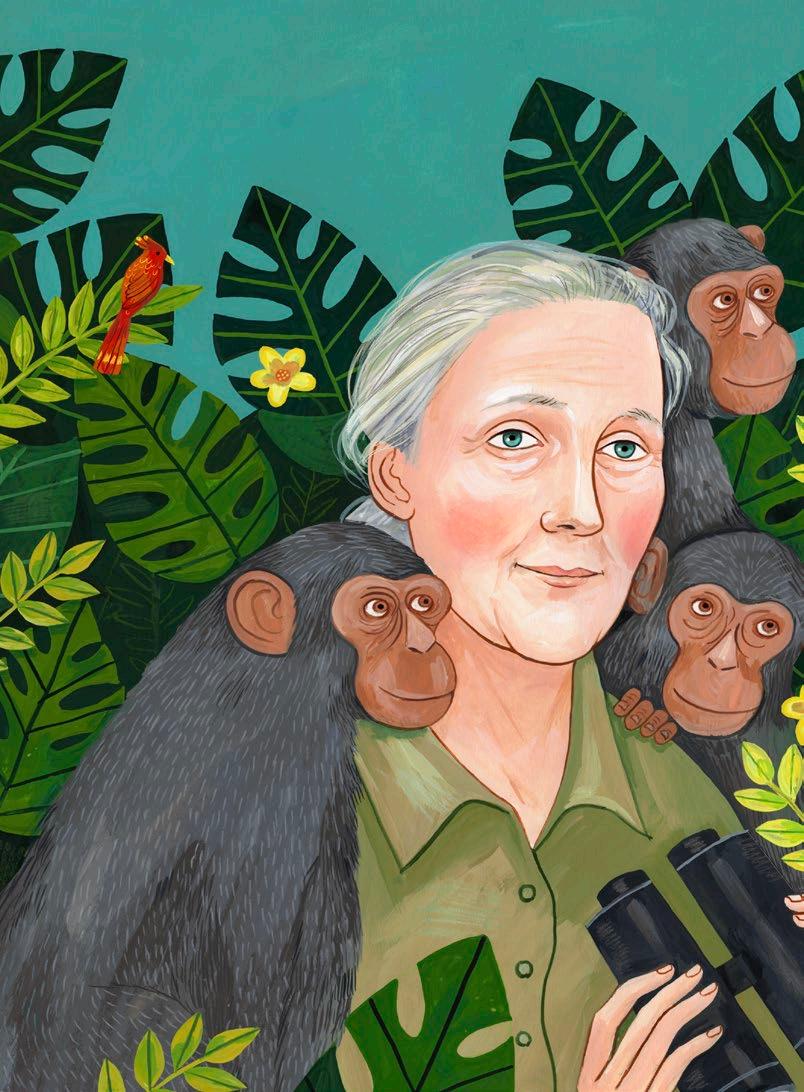
The Winter Blues HEALTH
Seasonal Sadness 6 Ways To Banish
FEBRUARY 2019 £3.79 readersdigest.co.uk
2019 HEALTH • MONEY • TRAVEL • RECIPES • FASHION • TECHNOLOGY READER’S DIGEST | SMALL AND PERFECTLY INFORMED | FEBRUARY 2019
FEBRUARY


Includes Gtech AirRam





Car Accessory Kit
RRP £50 FREE
These products should normally cost £399.98 but this bundle can be yours today for just £299.98
USE CODE FP85 AT CHECKOUT TO GET THIS OFFER




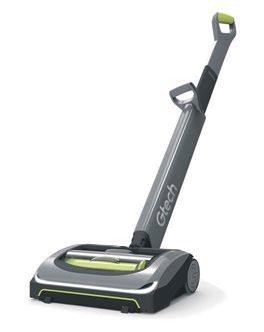
from the surface as you push the vacuum forwards, and locks on the backstroke to suck up embedded dust. Its powerful rotating brush bar makes it ideal for removing stubborn pet hair.
Long run-time and lightweight‡ Powered by a removable 22V lithium-ion battery, the AirRam and Multi give you a combined run-time of up to 60 minutes† on one charge, long enough to clean the average house twice. The Gtech AirRam weighs just 3.2kg and the Gtech Multi is only 1.5kg, making them both ideal for
Compact and cordless
Versatile and robust
6 different cleaning modes
Up to 60 minutes of combined run-time†
LED lights to illuminate dirt and dust
2-year guarantee
downstairs and upstairs cleaning.
Order today to save £100
These products should normally cost £349.98 but can be yours today for a bundle price of just £299.98, and, for a limited time only, Gtech are also giving you a FREE Car Accessory Kit worth £50, that allows you to clean your car’s boot, dash, seats and oor, or your caravan, easily and effectively.
Important: Please use code FP85 at checkout to get this exclusive offer.
EXCLUSIVE LIMITED TIME OFFER* SAVE 25% Our ultimate cordless cleaning solution 0800 030 86 37 24 hour orderline www.gtech.co.uk ORDER TODAY for just £299.98 with FREE DELIVERY Transform the way you clean your home with our award winning cordless vacuum cleaner and compact hand held LONG RUN-TIME AIRLOC TECHNOLOGY PFCKV1 Versatile The combination of the Gtech AirRam and Multi helps you to tackle cleaning your entire home. Transform the way you clean your home with the award winning AirRam, specially designed to glide from carpets to hard- oors with no settings to change. The Multi is a compact hand held vacuum cleaner that puts the attachments from your upright cleaner in the palm of your hand. Cordless convenience The AirRam has an ultra-low pro le handle design, allowing you to reach under tables, chairs and other furniture with no cord to hold you back. You’re free to spend more time cleaning and less time stopping to change plug sockets. The Gtech Multi’s powered brush head is ideal for awkward spaces like the stairs, car interior or sofacushions. It also includes an extension tube that can be used to reach up high or down low with a choice of two different nozzles. AirLOC Technology The Gtech AirRam features the unique AirLOC system that effortlessly picks up large debris
Offer only available directly from Gtech. *Offer ends 09.02.2019. Subject to availability, while stock lasts. 2-year manufacturer’s warranty. †Actual run-times may vary depending on the oor surface and the state of charge. Thick or deep pile carpets may reduce run-time. 40 minute run-time for AirRam + 20 minute run-time for Multi. ∆ Refers to AirRam. ‡Refers to AirRam when in use. Winner of Daily Express Best Retirement Living Solution 2017.
“ The vacuum is easy to assemble and light weight to use. It’s ideal for me as I live in a small flat. Very good.” Evelyn G. - Verified buyer
Features
16 IT’S A MANN’S WORLD
Olly Mann revisits his old university work
ENTERTAINMENT
20 INTERVIEW:
RICHARD E GRANT
The actor opens up about his native Swaziland, friendship and his love of marijuana
30 “I REMEMBER”: DR JANE GOODALL
The famous primatologist on her fascinating life and career
HEALTH
40 WINTER BLUES
How to brighten your mood during the cold winter months
56 THREATS TO HUMANITY
Is it possible for human civilisation to be destroyed?
INSPIRE
64 SAVING TIGERS
How an experimental programme in eastern Russia strives to protect these majestic endangered animals


72 BEST OF BRITISH: BABY IT’S COLD OUTSIDE
Spend Valentine’s Day in one of these enchanting spa retreats
TRAVEL & ADVENTURE
82 GREAT LAKES
Anna Walker discovers the charms and peculiarities of America’s Great Lake region
90 DISCOVERING WARSAW
Delve into the diverse beauty and rich cultural history of Poland’s capital
COVER ILLUSTRATION © HELENA PÉREZ GARCÍA
2019 FEBRUARY 2019 • 1
Contents FEBRUARY
p72 p20
NEW MONTHLY PODCAST DIGESTED
Each month Reader’s Digest will navigate the woes and wonders of modern life, weighing in with leading experts on the everyday tools we need to survive and thrive in 2019.
To subscribe to Digested for monthly episodes—starting with January’s “How to Give Up Plastic”—visit readersdigest.co.uk/podcast or search “Digested” on iTunes.

SUBSCRIBE TODAY FREE


FEBRUARY 2019 • 3 8 Over to You 12 See the World Differently HEALTH 46 Advice: Susannah Hickling 50 Column: Dr Max Pemberton INSPIRE 80 If I Ruled the World: Skin TRAVEL & ADVENTURE 96 My Great Escape 98 Island Getaways MONEY 100 Column: Andy Webb FOOD & DRINK 106 Tasty recipes and ideas from Rachel Walker HOME & GARDEN 110 Column: Cassie Pryce FASHION & BEAUTY 114 Column: Lisa Lennkh on how to look your best 116 Beauty ENTERTAINMENT 118 February’s cultural highlights BOOKS 122 February Fiction: James Walton’s recommended reads 127 Books That Changed My Life: Jacqueline Wilson TECHNOLOGY 128 Column: Olly Mann FUN & GAMES 130 You Couldn’t Make It Up 133 Word Power 135 Brain Teasers 139 60-Second Stand-Up 140 Laugh! 143 Beat the Cartoonist In every issue p96 Contents FEBRUARY 2019

SENIOR EDITORS Anna Walker, Eva Mackevic
EDITORIAL
ASSISTANT Jessica Summers
ART DIRECTOR Richard Cooke
ADVERTISING Jigs Pankhania
MARKETING Sarah Hughes
HEAD OF FINANCE Santwana Singh
FINANCE MANAGER Irving Efren
TRUSTED MEDIA BRANDS INC (USA)
President and Chief Executive Officer
Bonnie Kintzer
Vice President, Chief Operating Officer
International
Brian Kennedy
Editor-in-Chief, International Magazines Raimo Moysa
WE PAY...
£50 for the star letter and £30 for regular letters.
Email readersletters@readers digest.co.uk or go to readers digest.co.uk/contact-us
WE ALSO PAY...
£30 for the true stories, anecdotes, jokes in Laugh! and You Couldn’t Make It Up…, and contributions to end-ofarticle fillers and My Great Escape
Email excerpts@readersdigest.co.uk or go to readersdigest.co.uk/contact-us
SORRY!
We cannot acknowledge or return unpublished items or unsolicited article-length manuscripts. Do not send SAEs. Article-length stories, poetry and cartoons are not requested.
CUSTOMER SERVICES
Contact Customer Services for renewals, gifts, address changes, payments, account information and all other enquiries. Call 0330 333 2220* or email customer_service@readersdigest.co.uk
TALKING MAGAZINES
Reader’s Digest is also available in audio and accessible etext editions from RNIB Newsagent, for blind and partially sighted readers. Call the RNIB Helpline on 0303 123 9999 or visit rnib.org.uk/newsagent
SUBSCRIPTIONS
Annual subscriptions are available to be delivered monthly direct to your door. For our latest offers please visit readersdigest.co.uk/subscribe Or telephone us today on 01778 392461 Gift subscriptions also available. UK rates may vary. Overseas rates: Republic of Ireland €50, Rest of the World €60.
*Calls to 03 numbers cost no more than a national rate call to an 01 or 02 number and will be free if you have inclusive minutes from any type of line including mobile, BT or other fixed line PAPER FROM SUSTAINABLE FORESTS. PLEASE RECYCLE © 2017 Vivat Direct Ltd (t/a Reader’s Digest). British Reader’s Digest is published by Vivat Direct Ltd, 57 Margaret Street, London W1W 8SJ. All rights reserved throughout the world. Reproduction in any manner, in whole or part, in English or other languages, is prohibited. Reader’s Digest is a trademark owned and under license from Trusted Media Brands, Inc, and is registered with the United States Patent and Trademark Office. All rights reserved. Printed by Pindar Scarborough Limited. Newstrade distribution by Seymour Distribution Limited. SMALL PRINT: Ensure submissions are not previously published. Include your name, email, address and daytime phone number with all correspondence. We may edit letters and use them in all print and electronic media. Contributions used become world copyright of Vivat Direct Ltd (t/a Reader’s Digest). Reader’s Digest is a member of the Independent Press Standards Organisation (which regulates the UK’s magazine and newspaper industry). We abide by the Editors’ Code of Practice and are committed to upholding the highest standards of journalism. If you think that we have not met those standards, please contact 0203 795 8886. If we are unable to resolve
complaint, or if
would like more information about IPSO or the Editors’ Code, contact IPSO on 0300 123 2220 or visit ipso.co.uk
all
use the customer services number below
TO US! SEND US YOUR STORIES, JOKES AND LETTERS OR VISIT OUR WEBSITE
your
you
For
subscriber enquiries, please
WRITE
FEBRUARY 2019 • 5
GET YOUR SHAKESPEARE FIX AT THE RSC THIS WINTER



Kathryn Hunter returns to the Royal Shakespeare Company for the first time since she was a member of the 2010-12 Ensemble, when she played Juliet in Ben Power’s A Tender Thing, Cleopatra in Michael Boyd’s production of Antony and Cleopatra, the Fool in King Lear and Gavrilo in The Grain Store.
Renowned for portraying a wide variety of characters through her acclaimed stage career, Kathryn Hunter has played kings, queens, men, women and a monkey. In this adaptation of Shakespeare’s dark satire, Timon of Athens, Kathryn will be playing the titular role. Timon has it all – money, influence and friends. When the money runs out, she soon finds her influence and friends have also gone. Left alone, she flees Athens to take refuge in the woods, cursing the city she once loved.
Kathryn Hunter’s presence on stage portraying strong male characters such as King Lear (1997) and Richard III (2003) show how her personality and creativity can impact the roles she plays. She has also portrayed brilliant women, including Cleopatra and Bernarda Alba (2017), the matriarch of five daughters in an allfemale play which explores repression, passion and conformity.
She has gained distinction for her physical performances: as Red Peter in Kafka’s Monkey (a solo piece based on A Report to an Academy), where she played a monkey who gives a scientific lecture about her transformation from ape to human.

MORE INFORMATION
This is a rare chance to see this engaging and versatile actor give ‘a searing central performance’ (**** Guardian) in Shakespeare’s comic tragedy, which asks us to question our values and consider where happiness really lies. n
Timon of Athens plays in the Swan Theatre, Stratford-upon-Avon until 22 February. For more information and a full performance schedule please visit rsc.org.uk
In This Issue…

Last October I embarked on an American road trip of epic proportions, passing through four US states in just one week. Though the weather was temperamental (in days the 25°C sunshine of Detroit became snow in Wisconsin) the trip offered an insight into the contrasts of life in the Great Lakes. You can read about the journey on p82. The contrast had me thinking about climate change, and the dramatic impact human actions are having on our planet. Earlier this year I spoke to Will McCallum, head of oceans at Greenpeace, about the way excessive plastic consumption is harming mother nature. You can hear our conversation on the first episode of our new podcast, Digested, available through iTunes or at readersdigest.co.uk/podcast This month I had the pleasure of talking to the talented Richard E Grant about his new film, Can You Ever Forgive Me? A number of surprisingly profound topics flowed out of our relatively brief conversation: from his deep loyalty when it comes to friendships to his unapologetic love of marijuana.
Anna

Read all about our encounter on p20 and then head over to p118 to check out our five-star review of Can You Ever Forgive Me?—the incredibly witty, smart, and oddly heartwarming biopic of celebrity biographer, Lee Israel.
Eva
Follow us
facebook.com/readersdigestuk
twitter.com/readersdigestuk
@readersdigest_uk


You can also sign up to our newsletter at readersdigest.co.uk
Reader’s Digest is published in 27 editions in 11 languages
FEBRUARY 2019 • 7
EDITORS’ LETTERS
Over To You
LETTERS ON THE DECEMBER ISSUE
We pay £50 for Letter of the Month and £30 for all others
Letter of

received his monthly copy of Reader’s Digest and I was fortunate to receive his used copies every month.
Unfortunately, when he passed away my supply of this lovely magazine ceased and I didn’t get around to subscribing for myself.
Then, during a conversation with a close friend, I mentioned that I missed all the interesting
Reader’s Digest produced. To my great surprise and pleasure—on my 70th birthday last December—my dear friend gave me a subscription to Reader’s Digest as a gift. I have so enjoyed each and every edition and realised how much I had missed it. I’m over the moon that I won’t be missing any more.
Pamela Loughrey
8 • FEBRUARY 2019

PAPER JOURNEYS
I enjoyed “The Lost Art of Letter Writing” in the December issue. Although I rarely write letters anymore, the article reminded me of my school days in the 1970s when I loved nothing more than writing to my many penpals around the globe. My friend and I competed against each other to see who had the most pen friends and between us we had them in every continent (except Antarctica of course). From New Zealand to New York and South Africa to South Korea I would eagerly “stalk” the postman most mornings to see if there were any letters plopping on to the doormat. I enjoyed stamp collecting too so would save all the envelopes and carefully steam off the colourful stamps for my album. My school friend now lives in Greece and we keep in touch via email but occasionally take the time to send a precious letter to each other.
Melanie Lodge, Yorkshire
I totally agree with Lynn Wallis about the very sad fact that hardly anyone these days actually puts pen to paper to write a letter. Many years ago when I met my husband’s cousin, we instantly clicked and became so very close it was unbelievable. She lived in Buffalo, US, and we had agreed to write to each other. I sent her a letter so that it would be waiting on her mat for her when she returned home. We didn’t look back, and for years—until she very sadly died—we corresponded regularly. I used to start writing again as soon as I posted a letter to her—which were always about eight or nine pages long. Then on receipt of her reply I would answer what she had written. The wrong way around, but she loved it as they were trivial chat letters which I added to every time I thought of something else to say to her. We laughed and cried and confided to each other in our letters and I knew that every two weeks I would have a nice long chatty missive from my very dear and much loved lady. Oh how I miss her and her priceless letters.
Jeannie Holmes, London
READER’S DIGEST
FEBRUARY 2019 • 9
RONAN THE WISE
I agree with Ronan Keating that children should spend less time on their phones and more time talking to each other. I remember the first mobile phones which were the sole privilege of wealthy businessmen and those strong enough to carry them. Then they became accessible to adults in general. Then smartphones arrived and fell into the hands of teenagers on skateboards, who would happily read their Facebook messages as they surfed across several lanes of fast-moving traffic. Even small children in pushchairs have been seen using iPhones.
So where will it end? Will we see the day when a baby’s first words are not “mummy” or “daddy” but “Cortana” and “Alexa”—just before uploading their latest breastfeeding clip to Snapchat? Strange times.
David
Bennett, Staffordshire
NO MORE LURGIES PLEASE

I totally agree with what Ronan Keating said about the need for people to recycle more. This planet is never going to recover if we keep up our wasteful ways. Individuals and businesses alike need to take the need to recycle seriously. Or, better yet, learn not to be so wasteful in the first place. Future generations are going to suffer if we keep destroying our planet.
Owen Hollifield, Caerphilly
Your “Common Cold” article was highly informative and very timely. I’ve had my flu jab but protection against colds and treatment for them is far harder. I will be putting the advice to use, especially the part about taking zinc within 24 hours of onset to possibly reduce the length of the cold by a day. This is why I love Reader’s Digest, not just entertaining but helpful too.
Luke Russell, Yorkshire
Send letters to readersletters@readersdigest.co.uk
Please include your full name, address, email and daytime phone number. We may edit letters and use them in all print and electronic media.

OVER TO YOU 10 • FEBRUARY 2019
From You WE WANT TO HEAR
LOOKING TO GIVE YOUR HOME A MAKEOVER?
You can use the value of your property to fund improvements
Many homeowners are using the wealth tied up in their home to make sweeping changes to their property. If you own your home, then there’s a good chance it has gone up in price over the years, meaning you too could be making the most of your good fortune. This is just one of the reasons why over-55 homeowners have been taking out Lifetime Mortgages in record numbers – with over 38,900 households releasing equity in the first half of 2018.* Taking advantage of your home’s value could be the ideal way to pay for the renovations you’ve always dreamt of.
How does it work?
A Lifetime Mortgage is a type of equity release that is available to UK homeowners, and if eligible, you could convert some of your equity into tax-free cash. Better yet, you remain the owner of your home for life, and there are no required monthly repayments. The mortgage, plus interest,

can be rolled up over time and repaid when your house is sold. If you want to, this can happen after you and your partner have passed away or moved into long-term care.
The two things to remember when releasing equity are: it may reduce the value of your estate in time and could affect your entitlement to means-tested state benefits. An adviser can provide you with a personalised illustration, so you can pick plans that allow you to control how your Lifetime Mortgage affects your estate.
For your free guide to Lifetime Mortgages, contact Reader’s Digest Equity Release today.
PARTNERSHIP PROMOTION
Reader’s Digest Equity Release is a trading style of Responsible Life Limited. Only if your case completes will Responsible Life Limited charge an advice fee, currently not exceeding £1,295. Responsible Life Limited is Authorised and Regulated by the Financial Conduct Authority and is entered on the Financial Services Register (http://www.fsa. gov.uk/register/home.do) under reference 610205. Responsible Life Limited is registered in England & Wales. Company No. 7162252. Registered office: Unit 8 ABC Killinghall Stone Quarry, Ripon Road, Harrogate, HG3 2B. PARTNERSHIP PROMOTION
FOR MORE INFORMATION Readersdigest.co.uk/release Call 0800 029 1233 * Source Equity Release Council Autumn Report
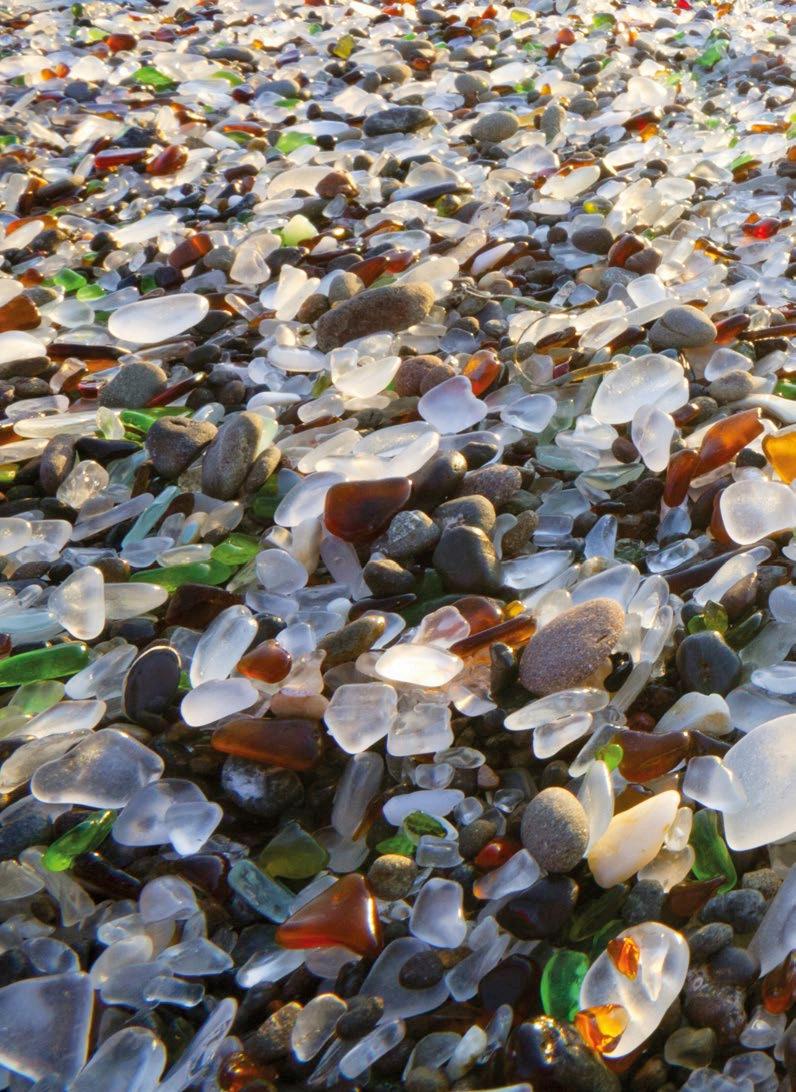
12
PHOTO: © GETTY IMAGES/FLORIS VAN BREUGEL/NATURE PICTURE LIBRARY

the world TURN THE PAGE…
See
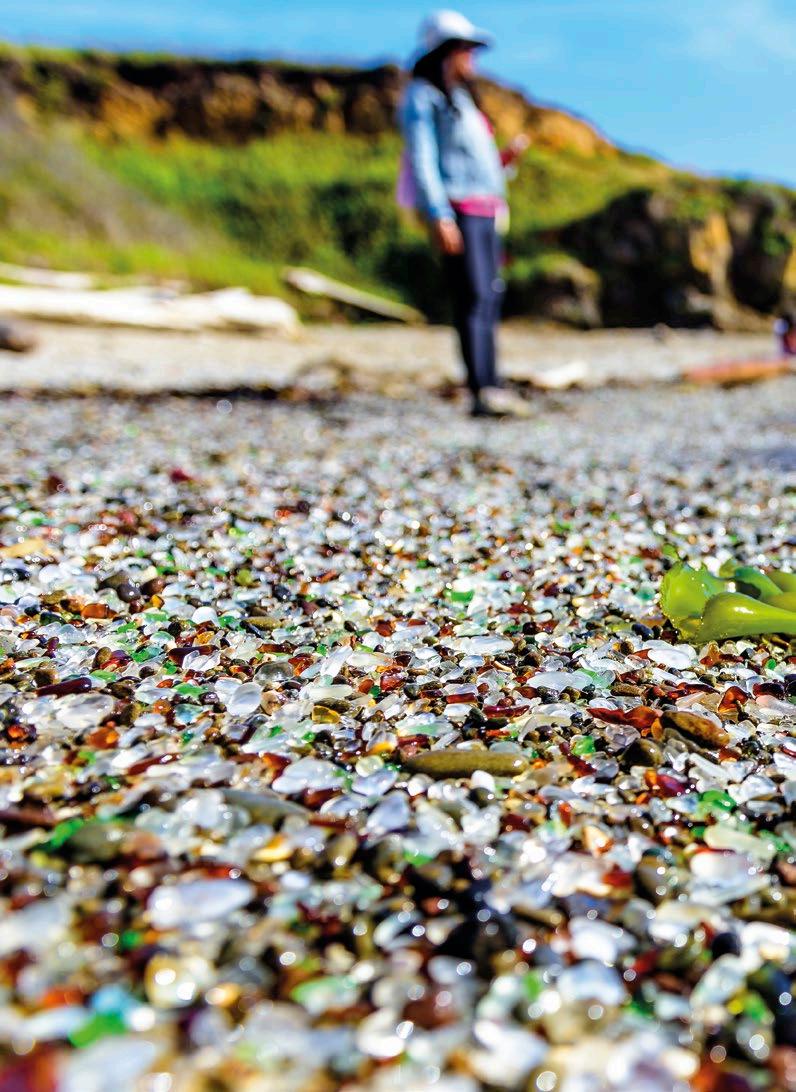
14
PHOTO: © GETTY IMAGES/PRAVEEN P.N
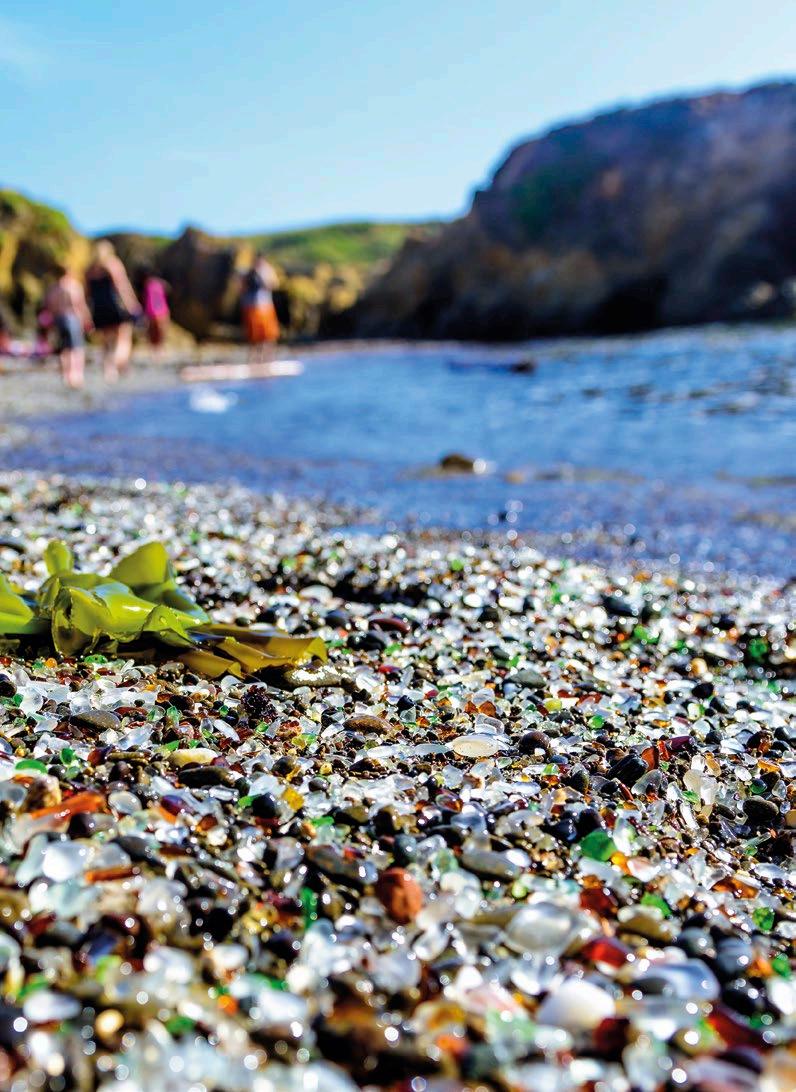
…differently
According to an old seafarer’s legend, the colourful pebbles found on the beach at Fort Bragg in California are the solidified tears of mermaids. In reality, however, they’re nothing more than garbage. At the beginning of the 20th century, it was common practice for people to simply dump their refuse in the ocean, among which were many glass bottles, aquariums and other glass debris. After years in the ocean, the glass was broken into smaller pieces and polished by sand and waves, leaving behind innumerable jewel-like pebbles.
Stash In The Attic
Olly Mann goes stationery shopping but finds himself on an unexpected trip down memory lane instead…
It all started because I wanted a lever arch file. Generally I’m more of a box file man, but a new project is generating a significant stack of notes in sub-categories, thereby screaming out for a chunky folder and colourful dividers. So, off I trotted to WHSmith—relishing not only the distraction, but also the opportunity to snap up a discounted Mary Berry book and two-for-one pack of Sharpies—when suddenly I remembered: Mum’s attic.
Stored away in her ceiling rafters are a dozen lever arch files, most embellished with a gold University of Oxford logo, containing notes from my undergraduate degree. When I shoved them up there in 2002, I

Olly Mann presents Four Thought for BBC Radio 4, and the award-winning podcasts The Modern Mann and Answer Me This!
thought they might be required for my forthcoming literary career; surely, it would only be a matter of months before I again had cause to reference my notes on Chaucerian dialect and the contribution of immigration to mutual intelligibility. (Instead, my first graduate job was researching a show for ITV about gobby estate agents).
But I had also wanted to keep the folders themselves. In the student’s union shop I had shelled out an extra £1 per folder—the equivalent of a pint of Strongbow in the college bar—to get ones emblazoned with the university logo. I’d been the first in my family to go to university, and I was proud to get into Oxford, of all places. I wanted to milk the opportunity for all it was worth: the world-class tutorials, the student media scene, and, yes, the chance to mince around town clutching at stationary inscribed in Latin.
For roughly three years, Mum’s
IT’S A MANN’S WORLD
16 • FEBRUARY 2019

ILLUSTRATION
BY DAN MITCHELL
been hassling me to remove my dusty stash of Oxford merch from her attic. I’ve always refused, because a) she and her house guests can’t see what’s up there anyway, so what does it matter, and b) it’s a really old house that’s pretty draughty in winter, so dumping piles of paperwork up there is basically providing her with insulation, so really she should thank me.
But, finding myself in need of a lever arch file, it seemed silly to go and buy one. As I ventured into Mum’s attic, an Aladdin’s cave of junk revealed itself: a broken bicycle pump, a moth-eaten Santa outfit, 3D glasses for a Sega Master System, gravel for a goldfish bowl, some counterfeit Louis Vuitton holdalls. It was hard to focus on the prize. But, right at the end of the loft,
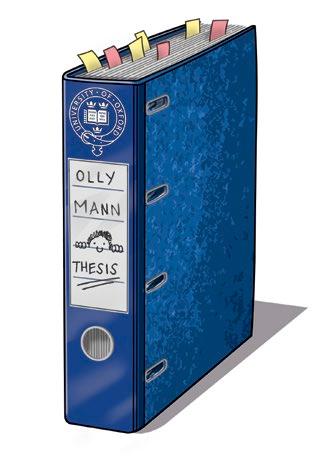
sandwiched between some faded Halloween decorations and a upsidedown Betamax, there it was: my hoard of folders.
I’d envisaged it being pretty straightforward to chuck out the scribbles contained therein. It is painfully obvious I will never again require my teenage thoughts on the travel diaries of Lady Mary Wortley Montagu. But, as soon as I opened up a folder, to rip out the pages, I found myself scanning the content. You know, just to be sure.
Hours flew by. Nostalgia, I guess you’d call it. I’d forgotten so much! Not only the literature I had studied —did I really write three-thousand words on Tennyson’s portrayal of fruit cake? How is that possible?— but the style and tone of my undergraduate writings, too: the footnotes I had to tediously doublecheck after each draft; the anonymised candidate number I was required to print in the header of my thesis; the double-spaced font that (I believed) gave my work the impression of intellectualism… but also, happily, doubled my page count so it appeared that I’d done more work than I actually had.
Reappraising the red marks in the margins, I reflected that the tutor who made them—who seemed scarily omnipotent at the time—was in fact younger than I am now. There was one essay in particular, about Harold Pinter’s presentation of the
IT’S A MANN’S WORLD
“As I ventured into Mum’s attic, an Aladdin’s cave of junk revealed itself: a bicycle pump, a motheaten Santa outfit, gravel for a goldfish bowl…”
past, that he picked apart like a carcass. But, considering his comments now—some phrases I’d employed were too journalistic, some points I’d made were tautologous—they all seemed entirely fair. At the time, I’d thought he was being deliberately harsh on me, because I hadn’t shown up to all his classes. But now I realised: if he had really wanted to punish me, he
wouldn’t have bothered reading my essay at all. He was just trying to kick me up the bum. It worked.
I thought back to my classmates who, the moment they graduated, threw their notes in the bin (recycling didn’t really exist in 2002), or, in one flamboyant example, built them into a massive bonfire. I was glad to have a moment to look again at my archive.
A few hours later, I did throw the notes away. But I couldn’t quite bear to part with the essays. I dusted the files down and, half a bottle of Flash later, repurposed 11 of them. But one now has “University Work” written on its spine, and sits proudly on my office shelf. I probably won’t open it for another couple of decades. But I suspect the fifty-something me will be pleased I held on to it.
MOTION PICTURE MORONS
Reddit users claim some of our favourite films would have been a lot shorter if the protagonists had more brain cells…
The Little Mermaid: “If Ariel could write, why didn’t she just write the Prince a note?”
Jurassic Park: “If John Hammond had just shelled out a bit more money for his IT department…”
Gremlins: “I can’t help but think the instructions were very clear.”
Back to the Future II: ‘Hey Marty, your future kid is an idiot. Fortunately, you have 30 years to change the outcome. Maybe consider moving to a different town, or sending him to a private school, or something?’ The end.
Jingle All the Way: “Had Arnie just purchased the Turbo-Man toy when his wife asked in October, the movie wouldn’t exist.”
READER’S DIGEST
FEBRUARY 2019 • 19
“I’m A Loyal Dog By Nature” Richard E Grant
Known for his flamboyant performances in Withnail and I, Downton Abbey and Francis Ford Coppola’s Dracula, actor Richard E Grant talks to Eva Mackevic about friendship, marijuana, and why he finds it so hard to forgive
In a quiet suite of Claridge’s hotel my blood runs cold as I begin my conversation with Richard E Grant. I gather from the get-go that the actor can be very picky about the things he shares, careful not to reveal too much about himself or tread on any risky territory—a trait which makes him both fantastically charming and frustratingly impenetrable.
We’re here to talk about his new film, Can You Ever Forgive Me? which tells the true story of the American celebrity biographer, Lee Israel, played by Melissa McCarthy. When Israel’s writing career took a turn for the worse, leaving her penniless,
she turned to a life of crime, forging letters of famous deceased writers and selling them for big money to book shops and private collectors. Richard portrays her hedonistic, larger-than-life friend, Jack Hock— a cash-strapped British expat who joined Israel in the pursuit of this risky illegal scheme.
“There was very little to go on [in terms of research], other than that Jack died at the age of 47 in 1994; had a little cigarette holder that he thought would stop him from getting lung cancer, as he was a chain smoker; and that he had been in jail for two years for holding a knife to a taxi driver’s throat, arguing about a
20
• FEBRUARY 2019

ENTERTAINMENT
I wish I could say I was more forgiving but emotionally I’m incapable of that”

fare.” Richard tells me about the role in his mellifluous, plummy voice.
Hock was also an out-of-control but extremely charismatic alcoholic which is very reminiscent of arguably Richard’s most famous character, Withnail, I observe.
“I suppose if you play somebody who’s as alcoholic, verbal and vitriolic as Withnail, inevitably there’s going to be an overlap into this kind of personality, but Jack Hock wanted to be liked, he was like a Labrador who would lick people into submission. A character like Withnail would not have given someone as spiky and misanthropic as Lee Israel the time of day.”
JACK HOCK DID THOUGH, and the result was a deep, sincere friendship
that both found solace in, despite the constant verbal sparring and extortionate pride. When I ask Richard what he’s like as a friend himself, he somewhat unsurprisingly admits that he’s quite rigid and very loyal when it comes to his personal relationships. Having moved to London in 1982, he still remains in touch with school friends from his native Swaziland.
“I place enormous value on friendships. I think that—unlike being married, or blood related— they’re this invisible thing that you have to nurture. I was incredibly lonely when I first moved to London, so the friendships that I formed in the first year really sustained me. I’m a loyal dog by nature so once I’m friends with somebody, that’s it.
22 • FEBRUARY 2019 INTERVIEW: RICHARD E GRANT
AF ARCHIVE / ALAMY STOCK PHOTO
“

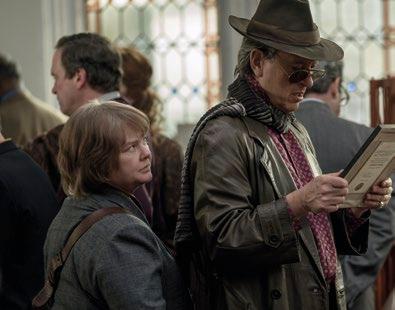

And, equally, if they betray me…” he pauses for a moment. “…I wish I could say I was more forgiving. I understand rationally I should be, but emotionally I’m incapable of that.”
Richard tells me about a time he was inadvertently betrayed by a friend of 30 years, who accidentally copied him into an unsavoury email. “It’s still stuff that I’ve never forgotten and that ended that friendship,” the actor admits.
THE CONVERSATION TURNS TO our shared experience as immigrants in London and what it was like to move our whole lives to a different part of the world.
“Swaziland is physically beautiful. We had a pool, a beautiful garden, an
READER’S DIGEST FEBRUARY 2019 • 23
With Melissa McCarthy in Can You Ever Forgive Me?
(Top left); Withnail is one of Richard’s most iconic roles to date
Fortunately, I have a job where you can—if you’re lucky enough— carry on playing parts until they just don’t want to see your face anymore” “
amazing view down a valley that you could see from 40 miles, monkeys at the bottom of the garden—all the things that you just take for granted when you grow up there. It’s rural and dramatic compared to the urban landscape of London which is flat as a pancake. It’s only when you go away you realise that it was exotic in retrospect, whereas at the time, that was your norm.
“Rudyard Kipling said, ‘What do they know of England, who only England know?’ and it’s that theme of, only when you go away and go back again, are you able to look with fresh eyes at where and how you grew up,” he muses.
If there’s one thing we agree on, it’s that neither of us would ever permanently return to our homeland.
“I can’t earn a living there,”
says Richard. “But it’s very nice to go to. The whole life that I live in England and America, which is show business, is of absolutely no consequence or importance when I go home. And it’s a completely different but refreshing reality.”
“Perhaps a nice place to retire one day?” I ask.
“Oh, I never want to retire!” he laughs. “I love my job too much. Fortunately, it’s a job where you can—if you’re lucky enough—carry on playing parts according to your age until they just don’t want to see your face anymore.”
RICHARD HOPES IT WON’T HAPPEN any time soon though, as the list of directors he’d like to work with (From Spielberg to Tarantino, via Damien Chazelle) is “as long as his arm.” Not that he’s complaining,
24 • FEBRUARY 2019 INTERVIEW: RICHARD E GRANT

READER’S DIGEST FEBRUARY 2019 • 25

though: “I’ve worked with Altman, Scorsese, Coppola, Jane Campion, Philip Kauffman, now Marielle Heller… I’ve had a good run but you know, there’s always somebody new who comes up with an idea or a way of working that is tantalising and interesting.”
Are there any roles that he would straight up reject, I wonder?
“Like, would I play a child killer?” he laughs. “I hope not. But the moment you say that, it comes back to haunt you. I’m sure if you asked Anthony Hopkins when he was doing Shakespeare at the National Theatre, ‘Would you ever have played a serial killer who ate people?’ he’d
go, ‘Maybe not,’ but he portrayed [Hannibal Lecter] brilliantly so I think it’s a kind of trap. Never say never, to quote James Bond.”
BY THIS POINT, RICHARD HAS LET his guard down, and the initiallychilly interview has turned into a mellow chat as we find ourselves giggling about his allergy to alcohol.
“I’ve only been drunk once; I managed to keep alcohol down for nine minutes and then I was violently ill for 25 hours,” he tells me.
As someone who’s intolerant to booze though, he’s certainly played a lot of characters with substance abuse problems. I ask him what his secret is.
26 • FEBRUARY 2019 INTERVIEW: RICHARD E GRANT

I’ve only been drunk once; I managed to keep the alcohol down for nine minutes and then I was violently ill for 25 hours”
“Well, what I’ve observed that’s so acute in drunken behaviour is that the effort that they make to appear not drunk and to get across a room in a straight line thinking that they’re managing it—that in itself is a clue to how to do it. You just try and hope that other people believe that you are,” he says.
When I wonder aloud whether he has indulged in any other vices to make up for his abstinence, Richard gets a bit giddy: “Oh yeah, all of them! I tried every drug under the sun in my youth. You wean yourself off that experimental time of your life. Your social life changes when you get more responsibilities. I still smoke dope but that’s as much as I do now. I love marijuana—it makes me laugh,” he smiles.
AS OUR CONVERSATION COMES to an end, my initial nerves are a distant memory. With a smile, I realise that when Richard described the character of Jack Hock to me earlier, he could also have been easily describing himself: “It’s like dealing with somebody who always has a long face. When you finally elicit a smile out of them, the reward seems much greater than it would’ve been with somebody who’s permanently happy.”
Can You Ever Forgive Me? is out in cinemas across the UK on February 1. Read our review on p118
FEBRUARY 2019 • 27
READER’S DIGEST
“


PARTNERSHIP PROMOTION PULLMANHOTELS.COM AN BRAND


OUR WORLD IS YOUR PLAYGROUND
The global nomad is Pullman’s representation of the new generation of travellers and business leaders. Hyperconnected and sophisticated explorers, every day they invent new ways of doing business around the world. The world is their playground and every moment is an opportunity.
At their service is Pullman, with over 80 hotels conveniently located close to prime tourist destinations and business districts in a some of the world’s most exciting cities, from Europe, Africa, the Middle East, Asia-Pacific and Latin America.
PULLMAN LONDON ST PANCRAS HOTEL

The hotel boasts 312 guestrooms, including 177 Classic Rooms, 41 Superior Rooms, nine Junior Suites and two Deluxe Suites.
The hotel provides guests with a superior culinary programme, taking dining to the next level. Guests can dine at the hotel’s bar and restaurant, which offers a variety of mouth-watering dishes, a selection of fine wines, 300 varieties of whiskey, as well as signature cocktails.
Pullman London St Pancras features a number of meeting spaces, including the Shaw Theatre, The Nobel Suite, The Business Playground and an additional 13 state of the art meeting rooms.
Pullman London St Pancras is one of the city’s premiere upscale hotels, in the heart of London. As the first Pullman hotel in the UK, Pullman London St Pancras is designed to set new standards and is where business meets pleasure. To find out more about Pullman hotels and to discover their locations visit... WWW.PULLMANHOTELS.COM
For your chance to win a stay at the Pullman London St Pancras log on to www.readersdigest.co.uk/lifestyle/ pullman-guides

Doctor Jane Goodall
I REMEMBER…
Renowned primatologist and anthropologist, Dame Jane Goodall, 84, is the world’s foremost expert on chimpanzees and an environmental activist
…BEING BOUGHT A TOY CHIMP AS A TODDLER. It was made to mark the first chimp born at the London Zoo, called Jubilee (right). People said it would give me nightmares, but he became my favourite toy. I took him everywhere. I still have him now, though he’s in his eighties, and rather delicate, so he doesn’t travel.
…MY MOTHER SUPPORTED MY AMBITION TO WORK WITH ANIMALS. She was the only one who didn’t laugh at my ridiculous dream
of going to Africa. She said I’d have to work very hard, take advantage of all opportunities, and never give up. That’s the message I tell young people around the world, particularly in disadvantaged communities. I wish she was alive to know many people have told me that I taught them that because I did it, they could too.
…RUSTY, A BLACK MONGREL, TAUGHT ME ANIMALS HAVE PERSONALITIES AND FEELINGS. I had other pets like guinea pigs and
ENTERTAINMENT
30 • FEBRUARY 2019 © THE JANE GOODALL INSTITUTE/COURTESY OF THE GOODALL FAMILY / STUART CLARKE
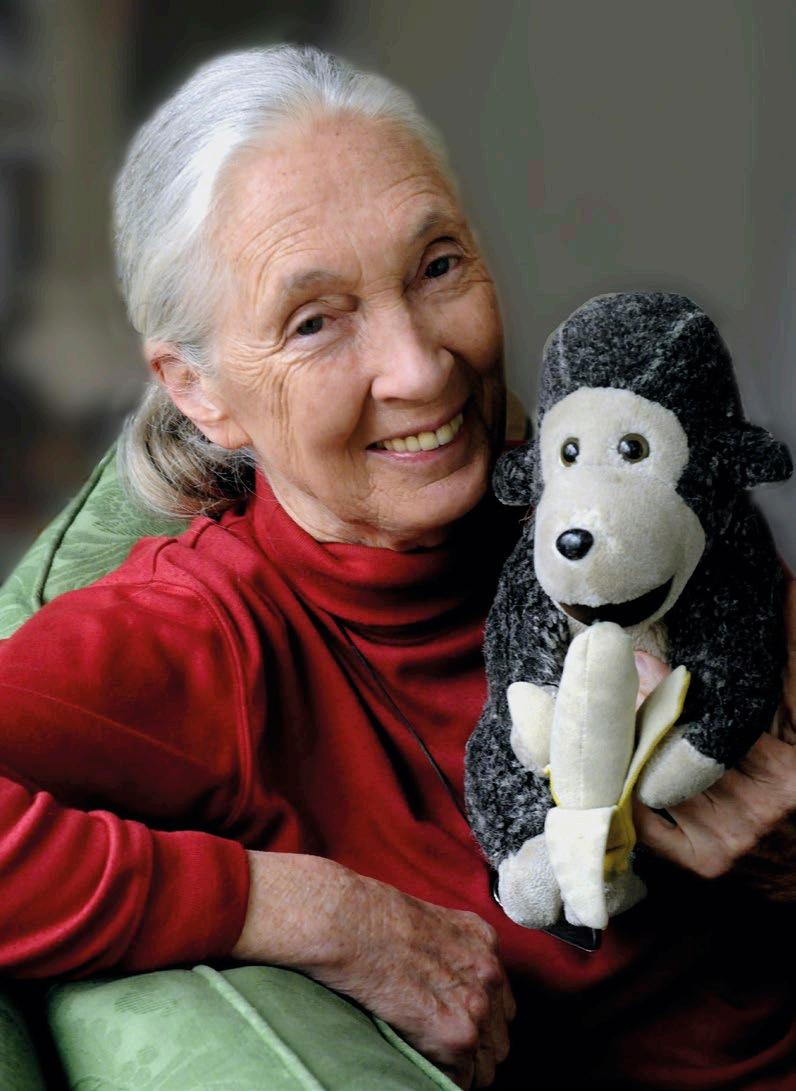
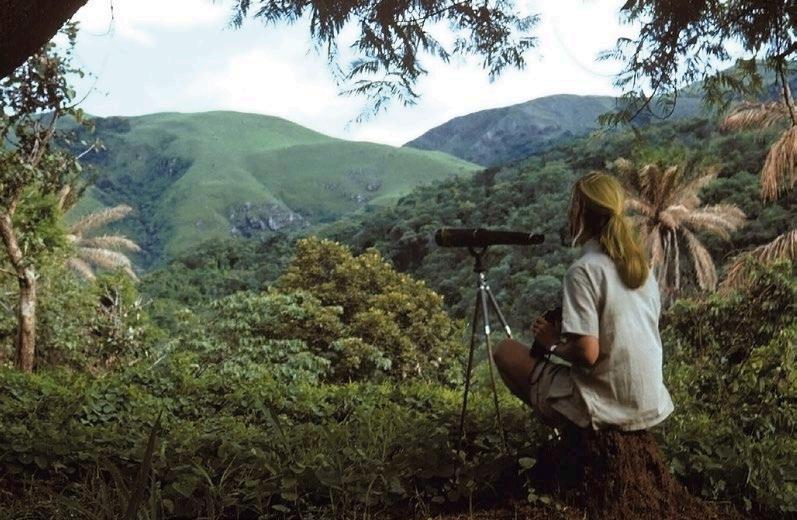

tortoises, and I knew they all had personalities, but Rusty was special. He was highly intelligent, and I thought of him when academics later told me that only humans have personalities, minds and emotions.
…MY FIRST TRIP TO AFRICA IN 1957. A friend invited me to her family’s farm in Kenya. There were no tourist planes then, so I went by sea. It was the time of the Suez Crisis so the ship went all round the Cape and the first town I set foot in was Cape Town. It was beautiful but had “Whites Only” signs everywhere,
which was horrible. On landing at Mombasa, a train took me past herds of wildebeest, which you don’t see now. Then, as a car drove me up towards the farm an aardvark passed ahead of us. There was a giraffe at the side of the road, looking down with those long, curly lashes. The first morning when I woke up, outside my very own window were the fresh paw prints of a leopard. I’d finally arrived in the Africa of my dreams.
…LOUIS LEAKEY GAVE ME MY FIRST WORK IN AFRICA. There wasn’t enough money for me to
32 • FEBRUARY 2019
(Left); Jane poses with her beloved dog Rusty in 1954. (Above and opposite); In her early days at Gombe Jane spent hours sat on high peaks, searching the forest for chimps
© THE JANE GOODALL INSTITUTE/COURTESY OF THE GOODALL
“In Cape Town there were signs saying ‘Whites Only’ everywhere, which was horrible”
attend university, but I went on a secretarial course. A friend said that if I wanted to work with animals in Africa
I should contact Leakey, a distinguished palaeontologist. By chance he needed a secretary, and allowed me to accompany him, his wife and one other English girl, Gillian, on his annual fossil hunting trip to the Olduvai Gorge, Tanzania.
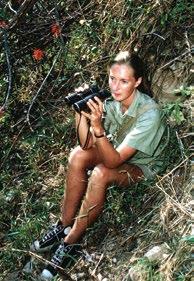

told me I’d done the right thing. I think that convinced him to give me the job of studying wild chimpanzees.
…LEAKEY THOUGHT WOMEN
…BEING FOLLOWED BY A LION. After each day’s work, Gillian and I were allowed to go out on the African plains in the evening. One time we looked round and a young male lion was following us. Scary, but exciting. Gillian said we should head down into the forest, but I said we must stay in the open, because in the thickets he’d know where we were, but we wouldn’t know where he was. The lion eventually gave up, and Leakey
MADE THE BEST OBSERVERS. He also wanted a mind uncluttered by reductionist scientific thinking. He felt that learning about our closest relatives, the chimpanzees, would help him better understand the behaviour of the Stone Age humans whose fossils he was digging up.
…DAVID GREYBEARD SAVED MY OBSERVATION PROJECT. We only had six months’ funding to begin with, and when I first arrived at the Gombe Stream Reserve, the chimps just ran away. They’d never seen a white ape before. It wasn’t until July 14, 1960, an
FEBRUARY 2019 • 33 READER’S DIGEST
INSTITUTE/HUGO
© THE JANE GOODALL
VAN LAWICK
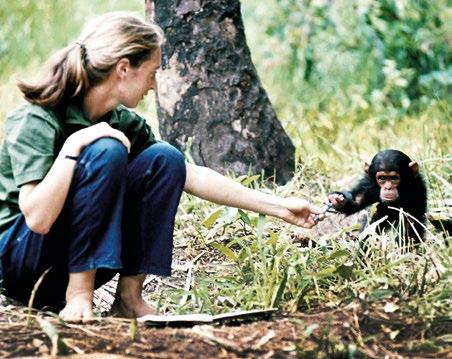
event now commemorated annually as World Chimpanzee Day, that the chimp I’d named David Greybeard became the first one to lose his fear of me, enabling me to observe him making tools to catch termites. If you saw that today, it wouldn’t be remarkable. We know lots of animals use tools, but then it was thought that only humans did it.
(L-R); Young Jane bonds with a baby chimp; With an orphan chimp in Kenya; Observing a chimpanzee shortly after release from an orphan sanctuary; Binoculars are her favourite tool

…NAMING THE CHIMPS WAS DEEMED CONTROVERSIAL IN THE SCIENTIFIC COMMUNITY.
But I couldn’t have imagined calling a chimp by a number. When the proof came back for my first scientific paper on nature—when I finally got a chance to do a PhD—all my “he’s”, “she’s” and “who’s” were crossed out for “it” and “which.” I was furious. I reinstated them all and refused to back down. And I won the argument.
…MEETING HUGO VAN LAWICK. He’d come to film and photograph me on behalf of National Geographic. This took the story of Jane and the chimps into the outside world. We fell in love and married in 1964. We set up the Gombe Stream Research Centre, the first of its type, which is still going strong today and discovering new things about chimps. Sadly, Hugo’s photography took him to the Serengeti while I remained at Gombe, and we drifted apart. We divorced amicably in 1974.
…OUR SON “GRUB” DIDN’T LIKE CHIMPS. He knew they could eat him. Chimps have been known to
34 • FEBRUARY 2019
© THE JANE GOODALL INSTITUTE/HUGO VAN LAWICK / MICHAEL NEUGEBAUER
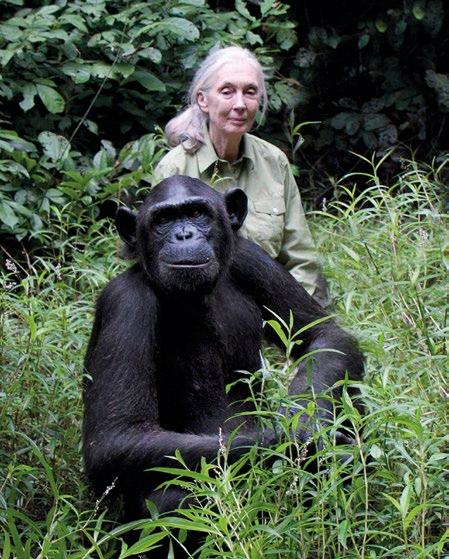
take human babies. Today, he finds them more interesting, but he still doesn’t like them.
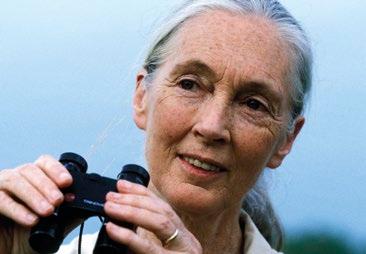
he described as an eagle with one wing male, the other female. Only when the two wings are equal will the tribe fly.
…“FEMINISTS” CRITICISED ME. It annoys me that people despise women if they stop their career to look after children. Chimps teach us that, for the first two years of life, it’s really important to have a nurturing three or four people who are stable, supportive, and always there. It doesn’t have to be the biological mother. But although I never saw myself as a feminist per se, I support women’s rights.
My favourite line came from the chief of a South American tribe, which
…EXPERIENCING A SPIRITUAL AWAKENING IN THE CATHEDRAL OF NOTREDAME, PARIS. I walked in one morning just as the sun was coming through the great rose window. A couple were getting married and the organist was playing Toccata and Fugue. It just hit me. I thought of all the people who’d built the cathedral, who’d worshipped there, and of Bach who’d created that music. The world couldn’t have happened by chance. Interestingly, although mainstream science doesn’t support the idea of God, cutting edge scientists are increasingly backing the idea of the intelligent design of the universe.
…GOING THROUGH A BLEAK PERIOD. It was difficult when my second husband, Derek Bryceson,
FEBRUARY 2019 • 35 READER’S DIGEST © THE JANE GOODALL INSTITUTE / FERNANDO TURMO / BILL WALLAUER

director of the Tanzania National Parks, died in 1992. It didn’t shake my faith, but I was grieving, wanting to be out in the forest. For me, it’s the most healing, rewarding place, where you realise that everything is connected, and that every single species has a role to play.
forest cover they depend upon, the growth of commercial hunting, the bush meat trade, the shooting of mothers to steal baby chimps, and the training of them for entertainment. It was a shocking insight.

…FLYING OVER GOMBE
and realising
that poverty was causing Africans to destroy their own environment. Gombe was once part of a great equatorial forest belt from East Africa to the West African coast, but by 1994 it was an island of forest surrounded by bare hills. There are more people than the land can support, and they’re too poor to buy food from elsewhere so they cut down trees for new farmland.
…MY PRIORITIES CHANGED AFTER THE PUBLICATION OF MY BOOK, THE CHIMPANZEES OF GOMBE. On the back of that, published in 1986, I helped organise a conference in Chicago on the subject. I walked into it as a scientist, and left as an activist. I’d been so isolated in Gombe but getting together with others who were studying chimps elsewhere in Africa was a shock. Each of us had the same stories, of falling chimpanzee numbers, the loss of the
Tanzania now only has about 2,000 chimps left, and the population across Africa is about 300,000. A century ago it was close to 2 million. Through my Jane Goodall Institute for Wildlife Research, Education and Conservation, we run a community programme that helps villages to grow plants and timber, allowing deforested areas to regenerate naturally.
…SCHOOL CHILDREN AND STUDENTS TELLING ME WE’D COMPROMISED THEIR FUTURE, making them feel angry and
READERSDIGEST.CO.UK/CULTURE/CELEBRITIES 36 • FEBRUARY 2019
© THE JANE GOODALL INSTITUTE /
BILL WALLAUER
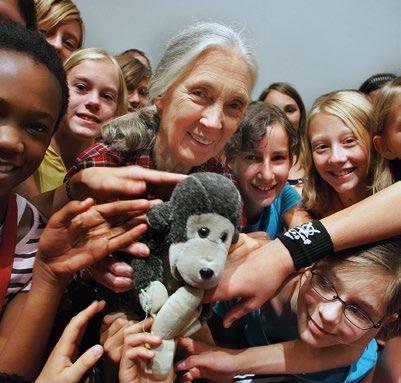
depressed. And [our generation] has. There’s a saying, “we haven’t inherited this planet from our parents, it’s borrowed from our children”. But we’ve been stealing, and we are still stealing. We have a tiny, tiny window of time to do something about it, but if our youth lose hope, that’s it.
“It annoys me that people despise women if they stop working to look after their children”
was five years old. My sister lives there now with her daughter’s family, and in between tours it is my home, my roots and my stability.
© ROBERT RATZER
…A CHAT WITH TEENAGERS IN DAR-ES-SALAAM INSPIRED ME TO SET UP ROOTS AND SHOOTS. It’s now in 80 countries, from nurseries to universities and everything in between. The programme’s message is that every individual can make a positive impact on the environment, animals and people every day. It’s very strong in China, India and North America, and we are in 1,700 school in Britain. But we are short of funds and need all the support we can get.
…CLIMBING
THE BEECH TREES AT MY BOURNEMOUTH HOME. The house has been in the family since I
I am travelling for 300 days a year. I don’t like it. I have no zest for travel, sitting in airport lounges and hotels, but how else can I get the message across? And I know that my words have an impact.
A man recently approached me after I had given a lecture in Hong Kong and told me that he’d intended to buy a sports car, but had given up the idea and was giving the money to Roots and Shoots instead.
It was Gandhi who famously said the planet could provide enough for human need, but not enough for human greed.
As told to Jack Watkins
For more details or to support Jane Goodall’s work, visit janegoodall.org.uk, and rootsandshoots.org.uk
READER’S DIGEST
FEBRUARY 2019 • 37
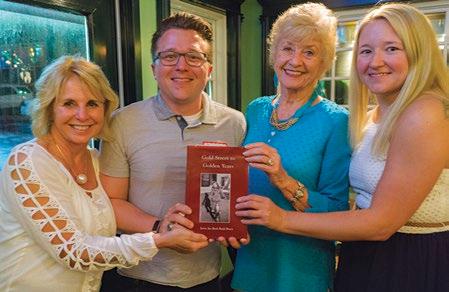






















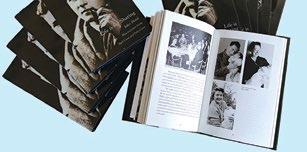


 BY JEFF KULAK
BY JEFF KULAK
If you suffer from seasonal affective disorder—or if the darker, colder months just get you down—there are many ways to brighten your mood
HOW TO BANISH THE WINTER BLUES
BY VANESSA MILNE
ILLUSTRATIONS
HEALTH
WHEN TED JABLONSKI was growing up in Winnipeg, Canada, he could often be found on winter days hanging out in the sun. “I would always sit at the top of the staircase by the window—it was my favourite place,” the 58-year-old remembers. “And even on the most frigid days, I would insist on walking to school.”
As he grew older, what had started as a seemingly benign preference for sunlight took a darker turn. By the time he was an adult, Jablonski began to go into every winter with a sense of dread. “It was a visceral feeling of gloom,” he says. “I’d work longer hours in order to distract myself from my feelings; I just tried to hang on until it passed in the spring.”
Then, in the winter of 2002, Jablonski slid into a depression. He recognised then that he’d been struggling with seasonal affective disorder (SAD)—depression that occurs every year, most often in the darker months—for most of his life. Ironically, Jablonski, who is now a family doctor in Alberta, treated many people with the disorder before he accepted that he suffered from it too. “It took me a long time to admit that this was more than just hating winter.”
binge-watching TV shows. But for the 1-15 per cent of Britons who suffer from SAD, it goes beyond that—they oversleep, overeat, and feel guilty, irritable and hopeless. The symptoms usually come on in autumn, peak in January, and go away in the spring.
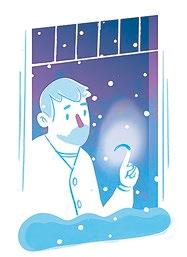
About six per cent of Britons acquire a more severe form of SAD, which can have a devastating impact. Before Diana Lillo, a 54-year-old entrepreneur, sought treatment for her more serious case, the effects of SAD on her everyday life were debilitating. “My life was just falling apart,” she says, explaining that both her marriage and career deteriorated, and she was plagued with overwhelming suicidal thoughts. After the sun went down every day, simply going outside was a struggle; most of the time, she says, “I would get to the door or to my car and just turn around and go back home.”
A lot of us go into hibernation mode every time the cold comes around, socialising less and feeling like we only have enough energy for
IN 1981, THE Washington Post ran a story about a 29-year-old woman who suffered from depression every winter, only to have it disappear in the spring—or two days into a holiday to Jamaica. Researchers explained how they had helped her with light therapy—a treatment during which a person sits in front of a light-emitting box for a set time every day—and invited stories from
42 • FEBRUARY 2019 HOW TO BANISH THE WINTER BLUES
others who experienced a seasonal drop in mood. More than 2,000 people responded, which informed the first paper to identify SAD in 1984.
But while the condition is now widely known more than 30 years later, we still don’t know exactly what causes it. The prevailing theory is that long winter nights throw off your circadian rhythm—the internal clock that regulates when you feel sleepy and when you’re alert. “As the days get very short, some people have difficulty adapting to that change, and the body’s rhythm is thrown out of sync,” says Robert Levitan, a psychiatrist at the Centre for Addiction and Mental Health and professor of psychiatry at the University of Toronto.

hormone that makes you feel sleepy.
SAD may also be hereditary; having a relative with the condition increases your chances of getting it by up to 17 per cent. And a University of Iceland study that screened Winnipeggers in Canada for SAD found that those with Icelandic genes were significantly less likely to have the disorder, suggesting that people whose ancestors are from climates with less sun may have built-in resistance.
That would explain why people who live closer to the equator, where the days are the same length yearround, are much less likely to acquire SAD; only one per cent of people living in Florida have it, for instance.
Another hypothesis is that the lack of sun changes your brain activity. “When light touches your retina, all kinds of chemicals are released that make you behave differently,” says Jablonski. If you don’t get enough light, your body produces fewer neurotransmitters like serotonin, which helps keep your mood stable, and too much melatonin, the
THERE IS LIGHT at the end of the tunnel—and not just spring. For people who suffer from SAD—and really, for anyone made grumpy by 4:30pm sunsets—a combination of lifestyle changes and doctorrecommended treatments can reduce symptoms and provide lasting relief.
LIFESTYLE ADJUSTMENTS YOU CAN MAKE RIGHT NOW
■ LET IN THE LIGHT. Ted Jablonski was onto something with his favourite spot by the window: exposure to as much sun as possible helps. Keep your curtains open all day, and rearrange your furniture so you’re regularly in bright places in your home. Install skylights if you can. Also, while artificial light isn’t as good as the real thing, adding more lamps
FEBRUARY 2019 • 43 READER’S DIGEST
If you can afford it, head to the lands of minimal SAD near the equator. A sunny holiday will offer a welcome, if temporary, respite from the winter blues.
■ RELY ON ROUTINES. Winter’s long nights throw off your sleep cycle, but keeping a regular bedtime and wake time can help regulate it, and prevent both insomnia and oversleeping. Also, dim your lights at night and avoid screens for about two hours before heading to bed.
During the day, regular aerobic exercise can help you manage stress, feel more alert and increase your emotional resilience. “When you exercise, your dopamine and serotonin levels rise,” explains Jablonski. “Just 20 to 30 minutes, five or six days a week, can really change the chemistry in your brain.” A brisk noon-hour walk can do double duty, as you’ll get some sunlight, too.
■ CONNECT WITH OTHERS. “When people become depressed, they also start to pull away from things in life that they like doing, and the more they withdraw, the less pleasure and sense of accomplishment they are able to feel in general. It’s a downward spiral,” explains David Dozois,
who is a psychologist and chair of clinical science and psychopathology at Canda’s Western University in London, Ontario.
He suggests making a point of finding wintertime ways to do whatever brings you joy during the summer, whether that’s socialising, playing a sport or being in a band. “I encourage patients to “fake it ’til you make it.” Just do it, even if you don’t feel like it at first,” he says.
TREATMENTS TO TALK TO YOUR DOCTOR ABOUT
■ GO WITH THE GLOW. Light therapy using an ultraviolet-filtered lamp is the most common treatment for SAD. “Patients prefer it, and doctors like it because it works quickly and it’s very potent,” says Levitan. People typically are encouraged to use their illuminated unit for at least half an hour a day in the morning, which essentially tricks their body into thinking it’s already spring.
“I found immediate relief with my light box,” Lillo says. “When I sit in front of it, my mood changes, I feel more energetic and more at peace. The anxiety and depression seem to just slip away.”
Some people with SAD also find “dawn simulation” helps—this is usually accomplished with a custom alarm clock to dark areas in your home is better than nothing.

44 • FEBRUARY 2019 HOW TO BANISH THE WINTER BLUES
connected to a light that gradually becomes brighter before your set wake up time. Its effectiveness has not been studied as much, but it works for many people and is easier to squeeze into a busy schedule.

■ MAKE A THERAPY APPOINTMENT. Cognitive behavioural therapy (CBT) is an effective way to combat SAD, or any depression, says Dozois. The treatment usually takes between 12 to 16 weeks to complete, and involves setting up tasks that challenge your behaviour—resisting the natural tendency to socialise less during the winter, for instance.
CBT practitioners also coach people to address the negative automatic thoughts that might, for example, keep a person from staying connected. “If someone passes me at work and doesn’t say hello, my thought might be, He doesn’t like me. OK, that’s one possibility, but what’s another? Maybe he’s stressed about a deadline or maybe he didn’t see me,” explains Dozois.
“It’s putting that thought on trial, and coming up with an alternative, more valid one.”
■ FIND EFFECTIVE MEDICATIONS. Antidepressants are also used to treat SAD, often alongside light therapy
and CBT. “Typically we use medications that are activating, rather than those with a sedative effect,” explains Jablonski. He usually prescribes Bupropion—which, unlike many other antidepressants, doesn’t usually cause sleepiness or weight gain—but selective serotonin reuptake inhibitors (SSRIs) are also common. Those people who are already taking these drugs may simply increase their dose starting in the autumn.
COMBINING ALL THREE of the above treatments has turned winters around for Diana Lillo. “My depression will always be with me, but having a toolbox that helps me feel better and deal with my emotions makes a huge difference,” she says.
Jablonski, who swears by his light box and regular exercise, tells his own SAD story often in the hopes that it will inspire others to seek help. In 2010, he even ran and biked all the way across Canada to raise awareness of the disorder.
“The existence of SAD is wellknown now,” he says. “What isn’t as well-known is the extent of how disabling it can be—and that you can treat it. My plea to those with SAD is: you don’t have to dread winter and lose months out of every year. You don’t have to suffer unnecessarily.”
FEBRUARY 2019 • 45 READER’S DIGEST
Pay Your Way Or Stay Away?
Some checks or treatments are available on the NHS, some aren’t, and yet others have a long wait. What care is it worth investing in and when should you keep your hands in your pockets?
PAY YOUR WAY
Eye tests
Having your eyes tested at least once every two years is undoubtedly a good investment. Not only will a sight test tell you whether you need glasses or a different prescription, but it could also stop you going blind by picking up problems such as glaucoma early. What’s more, it can detect health problems such as high blood pressure and diabetes.
You may not have to pay, for example, if you have diabetes or glaucoma—or are at risk of it—or are over 60. Even if you do, many opticians have special offers.
 Susannah Hickling is twice winner of the Guild of Health Writers Best Consumer Magazine Health Feature
Susannah Hickling is twice winner of the Guild of Health Writers Best Consumer Magazine Health Feature
Braces
Above and beyond paying for routine dental treatment—whether private or NHS—it’s worth considering a brace if your teeth are overcrowded, even as an adult. This will help stave off gum disease and tooth decay, helping you keep those pearly whites healthy.
Physio
If there’s a long NHS waiting list for physiotherapy and you’re in discomfort, you might want to fund a few sessions yourself. Sometimes it’s important not to wait too long if you want to regain full mobility or function after illness or injury. Make sure your physio is registered with a recognised body, such as the Chartered Society of Physiotherapy.
Podiatry
Podiatrists treat foot-related problems from flat feet to heel pain, from discoloured toenails to sports injuries. Depending on where you
46 • FEBRUARY 2019

live, you may not be able to see one on the NHS unless your problem is associated with a long-term condition, such as diabetes. And even if you can, it might be hard to get an appointment. In these circumstances you might want to see a podiatrist privately. Some do home visits too.
Varicose veins
If your varicose veins are painful or you have ulcers, then you will probably qualify for NHS treatment. But if you simply hate the look of your bulging veins but they’re not giving you any trouble, then you will have to fork out yourself. Be aware that they could come back.
Talking therapies
Unfortunately, talking therapies can be hard to access on the NHS in
some areas, so going private is one way of getting the help you need. Charities such as Mind or Anxiety
UK may offer free or low-cost counselling, so you may want to explore this option first. Visit mind.org.uk.
STAY AWAY
Body scans
A lot of us receive letters inviting us for a private full-body screening. But it might not give you the peace of mind you were hoping for. A body scan might pick up small abnormalities that never present a problem but will give you a lot of worry. You may even have to selffund further expensive tests. But it’s always worth taking up NHS offers of screening—such as for bowel or breast cancer, or a health MoT offered by your GP surgery.
FEBRUARY 2019 • 47 HEALTH
Cold Weather Myths Busted
As the cold season is in full swing, toss aside these popular myths about the common cold which can bring you more harm than use

Myth 1 You’ll catch a cold because of the cold. Although Swedish research has found that a sudden drop to subzero temperatures often precedes a flu epidemic, it’s not simply the weather that causes you to catch a chill. You actually have to be exposed to a cold or flu virus, whatever the thermometer’s telling you. Wash your hands to avoid transferring germs to your eyes or mouth.
Myth 2 Booze keeps you warm. Whoever put a keg of brandy round a St Bernard’s neck got it spectacularly wrong. Alcohol may give you the impression that it’s warming you up because it dilates the blood vessels near the surface of the skin, making more blood—and heat—rush to them. But it’s only an impression. This process takes heat away from your vital organs and you can get cold very quickly.
Myth 3 You lose most of your body heat through your head. You can
actually lose heat through any part of your body that’s exposed, not just your head. But, overall, it makes sense to wear a hat in cold weather.
Myth 4 Dressing in layers keeps you toasty. Layers make sense if you’re exercising or going in and out of buildings, because you can take off clothes as necessary. But, in general, one nice, warm article of clothing is just as good if you’re out in the cold.
Myth 5 You shouldn’t exercise when it’s parky. Wrong. There’s absolutely no reason not to, as long as you wrap up warm. You may even burn more calories as your body will have to work harder in lower temperatures.
Myth 6 You lose more hair in winter. Not so. A study from Zurich University Hospital in Switzerland found that you’re less likely to lose hair during the winter months. In fact, you might even experience more hair growth.
HEALTH
48 • FEBRUARY 2019

Ask The Expert: Posture And Pain
Henry Barratt
Ex-professional rugby player Henry Barratt is a personal trainer specialising in postural problems and relieving pain
How did you come to specialise in posture and pain relief? My career playing rugby for Harlequins and London Wasps was cut short by injury at 25. There was a logical progression from keeping myself fit to keeping other people fit, so I qualified as a personal trainer so I could help other people with injuries.
Why is good posture important? It’s the foundation for all movement in the body. It means the muscles are working properly, muscles that are overworking can relax and muscles that aren’t working as they should can work and get stronger. Good posture prolongs our ability to avoid injury and our pain-free existence.
What postural problems do people have? The main one I see is lower back pain. We sit for long periods with rounded shoulders and a rounded lower back. Over time this can lead to muscle spasms, disc issues and sometimes sciatica.
How can they improve them?
Avoid sitting as much as possible, add a lumbar support when you’re sitting or driving, and regularly practise a light core-based routine with stretches, like the pigeon stretch. Seek advice from a physio or personal trainer who is used to teaching everyday movement, such as how to sit, stand, walk, reach, rotate, balance. Book two sessions—one to learn what to do and one to be checked.
What other suggestions can you offer to relieve pain? When people have hip pain, I often separate their feet a bit wider when they walk. They use their buttock muscles more and it offloads the pressure going through the hips. For lumbar pain, I use walking techniques, keeping the head up and eyes forward, teaching the person to be more aware of their posture.
Visit henrybarratt.com for more information
FEBRUARY 2019 • 49 READER’S DIGEST
A Boozy Burden
Binge drinkers put a strain on the NHS, and Max Pemberton’s patience for inebriated patients is wearing thin…
It is 1am and the smell of cider is almost overpowering. Several men with beards and dirty clothes are slumped over a chair, while another woman is calling out before vomiting on the floor. “Have you got any change for the bus home?” one of them asks, in my vague direction. I scowl and keep walking. The woman who has just been sick starts screaming in the direction of the nursing station.
“Are you gonna clean that up or what? It’s a health hazard,” she shouts, failing to appreciate—from the looks that her requests are met with by from the nursing staff—that it’s not the vomit that’s the most immediate threat to her health. One of her friends wakes up and starts shouting that they’ve been waiting for over and hour to be seen by a

Max is a hospital doctor, author and columnist. He currently works full time in mental health for the NHS. His latest book is a self-help guide to using CBT to stop smoking
doctor. He loses interest and instead focuses his attention on trying to find his shoe, which judging from the dirt on his foot was lost some time ago. He burps loudly and the assembled inebriates laugh loudly. They are starting to really annoy me.
“Great birthday, Clare,” says one of the men. Clare is 26 today. The two men with her are friends from work. Clare is not homeless. In fact, none of the drunks in A&E are homeless. I look on the computer and count an unbelievable 16 patients in the department whose sole reason for being there is alcohol. I don’t mean that they’re drunk and have fallen over and broken their arm, or hit their head and that’s why they’re in hospital. I mean 16 people for whom the only reason they’re in a cubicle in A&E is that they are drunk. To add insult to injury, most of them have been picked up by ambulance. They have intravenous fluids pushed through their veins over several hours to sober them up so there’s a three-hour wait in reception because these people are taking up the
HEALTH 50 • FEBRUARY 2019
cubicles. The whole scene is thrown into sharp relief by the woman in the end cubicle who is having a miscarriage. Now it’s things like this that the NHS is there for. It’s not there to act as some wetnurse for people who down 15 bottles of alcopop and then pass out. Of course, people get drunk, and that’s fine. Inevitably sometimes people overdo it and end up in hospital. Fair enough. But it’s happening to so many people (in contrast, there were only three people who had a heart attack that evening), which means services already at breaking point are stretched even further.
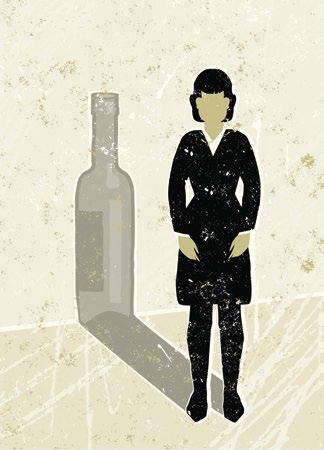
“Just wait till I tell everyone at work on Monday about this”, she says to her friends as they walk out. They all burst out
laughing. They aren’t ashamed. This is something that can be bragged about the next day. And when one of these people have a real emergency, when they or their loved ones really do need A&E, you can guarantee they’ll be the first to complain when they have to wait. They’ll be the ones who will be incredulous that there isn’t enough space. But right now, there’s no reasoning with them. All you can do is sober them up and get them out the door.
As I stood in A&E, the smell of cider being gently wafted around the department by an electrical fan, Clare is medically cleared and discharged and it’s then that the real problem hits home.
FEBRUARY 2019 • 51
The Doctor Is In
Dr Max Pemberton
Q: I experience frequent postmenopausal bleeding and I’m fed up with the stress caused by all the doctor’s appointments, so I’m considering a hysterectomy. I know it’s a major surgery so I shouldn’t go into it lightly—what should I consider before making a decision?- Pam, 53
A: Hysterectomies aren’t something people consider on a whim, so I can only imagine how fed up you are. It certainly sounds as though you’ve been having a difficult time. As you know, a hysterectomy is the surgical removal of the uterus. People have a hysterectomy for various reasons but heavy bleeding (often caused by fibroids) is a major factor. Others include cancer and pelvic pain.
As with all surgery there are risks. These include the risks of general anaesthetic as well as post-operative complications such as bleeding or infection. Because of where the uterus lies, there’s also a risk of damage to the bowel or bladder. This is rare, but serious. People also often
complain of abdominal discomfort that can last for months and full recovery can take up to a year.
My general view of surgery is it’s best avoided if possible. Sometimes when we’re fed up and frustrated, we just want it all over and done with. I think you need to be mindful of not thinking oh, just cut the thing out and then regretting this in the future.
The official guidelines recommend that hysterectomy is a last resort, so do ensure you’ve exhausted every avenue first. If you haven’t already, ask for a second opinion, preferably from someone in a large teaching hospital. Sometimes people feel embarrassed asking for a second opinion in case it seems like you don’t trust your doctor. It doesn’t mean this at all and any decent doctor will realise this. It’s about ensuring you have all the information before making a big decision.

Got a health question for our resident doctor? Email it confidentially to askdrmax@ readersdigest.co.uk
BY JAVIER MUÑOZ
HEALTH
52 • FEBRUARY 2019 ILLUSTRATION



Feeling Tired?
With busy, demanding lifestyles, more of us are looking to support energy release and vitality with an iron supplement that is easy on the stomach and tastes great too!
Feroglobin® Liquid, gentle iron that supports normal formation of red blood cells and haemoglobin and normal energy release in a honey and orange flavour liquid.
Feroglobin® Capsules, slow release iron supplement, in capsule form with zinc and vitamin B12, formulated to deliver an ideal amount of iron to the body while remaining gentle on the stomach.



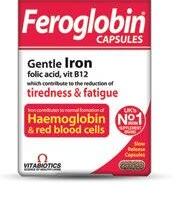
From Superdrug, Holland & Barrett, supermarkets, chemists, health stores & www.vitabiotics.com *Nielsen GB ScanTrack Total Coverage Unit Sales 52 w/e 16 June 2018. 2018-24-07 ADFERCONP E
With iron, folate, vit.B12 which support the reduction of tiredness & fatigue
UK’s No.1 Iron Supplement Brand* The ONLY vitamin company to twice receive The Queen’s Award For Innovation
Make Your Memory Work
Thinking tricks from the workplace can be rewarding for everyone, as our memory expert Jonathan Hancock explains
Sean McVay coaches the LA Rams American football team, and he’s got an incredibly good memory. He can recall in detail every single “play” his team has ever made. Just like waiters who remember large orders or teachers who quickly learn new children’s names, Sean has developed remarkable powers of “professional” recall. When people develop memory skills that match their jobs, four key principles are at work: Connection. They’re involved with the things they’re remembering: they’re seeing, doing and reacting emotionally.
Necessity. Problems arise if they don’t remember, so they make sure they do. Motivation. They’ve got lots to gain from remembering well.
Repetition. If you reinforce anything again and again you’re much more likely to remember it. You can make these factors work in your favour—in your own work, and in life in general. Find your connection with the things you want to learn. Give it a go. The next time you’re eating out with friends or family, take charge of the order. Repeat each person’s choice back to them, think about how impressed they’ll be, risk doing it all from memory and then make some strong mental connections to help you pull it off.
Follow @ReadersDigestUK on Twitter and Facebook for a memory exercise from me every day!

THE CHALLENGE
See if you can link the following celebrities with their chosen lunch. Maybe Lady Gaga is wearing a flamboyant hamburger costume. Tim Peake could be struggling to eat spaghetti in space. Picture a tennis ball in Billie-Jean King’s soup.
Donald Trump: fish & chips
Billie-Jean King: soup
Lady Gaga: hamburger
Meryl Streep: salad
Harry Kane: pasta
Tim Peake: spaghetti
Tom Cruise: jacket potato
Richard Branson: pie
Give yourself a few minutes to learn the list, then see how many of their orders you get right. Build the confidence to try out the same technique with your friends, and then take every real-life chance you get to challenge yourself. Do all the things your brain needs to work well—and you too can start thinking and remembering like a pro.
54 • FEBRUARY 2019 HEALTH

FREEDOM AND CONFIDENCE FOR COLOSTOMATES
Over the years, we’ve all encountered challenges that we never thought we would, whether these are relatively minor, or hold the potential to be life-changing, they all disrupt our routine in their wake.
When Vicki was diagnosed with cancer, she not only had to mentally prepare for surgery, but also had to come to terms with the prospect of living with a colostomy pouch. Her shock at having cancer was paired with her fear of having her full and busy life restricted – so much so, that she even considered not going through with the lifesaving operation.

She initially struggled to adjust to living as a colostomate. However, this all changed when she discovered a di erent kind of colostomy pouch which was flushable, meaning it could be flushed away in the toilet. The way her new pouch works gives Vicki freedom and allows her to indulge her love of travelling and socialising with comfort and ease. It has been a critical point in her process of accepting her diagnosis.
Vicki explains, “Aura Flushable are brilliant. They enable me to do all that I want to do these days – all the things I could do before I had a colostomy.” She continues, “Life with a colostomy doesn’t have to be sitting at home, not going anywhere, not visiting people. The flushable pouches give you the freedom to be you again.”
Vicki has shared her incredibly moving and inspiring story in the hope that it can help other colostomates find their freedom again too. To watch Vicki’s inspiring story as shared with Reader’s Digest visit:
www.readersdigest.co.uk/health/health-conditions/finding-freedom-and-confidence-for-colostomates
To see Vicki’s full story, or to hear more stories told by colostomates like Vicki, visit www.flushablefreedom.co.uk
For more information about Aura Flushable, or to order your free sample, Visit www.clinimed.co.uk
Call the Freephone Careline on 0808 301 3255
Email info@clinimed.co.uk
PID 6860
THE RESEARCHERS BATTLING TO SAVE HUMANITY
BY CHRIS MENON

Threats to the very existence of a dominant species on Earth are nothing new: as the extinction of the dinosaurs by an asteroid impact 65 million years ago testifies.…
Fortunately, humanity has survived numerous risks and natural threats over millennia. What is new is that we, ourselves, now have the ability to destroy human civilisation.
Around the world, academics and entrepreneurs are trying to wake us up to self-inflicted potential disasters that could lead to human extinction or civilisational collapse. Chief among these hidden heroes are members of the Future of Humanity Institute (FHI) and the
Centre for the Study of Existential Risk (CSER), who are dedicated to promoting investigation and a better understanding of these threats.
Both these research centres are in the United Kingdom: the CSER within the University of Cambridge and the FHI at the University of Oxford. The CSER founded in 2012 has 12 full-time staff and can number among its supporters Jaan Tallinn the co-founder of Skype and Elon Musk—founder and Chief Executive of both Tesla and Space X.
56 INSPIRE

57
PANDEMICS
Professor Martin Rees, the Astronomer Royal, was a founding member of the CSER and his latest book, On the Future: Prospects for Humanity discusses these threats. In an exclusive interview he told Reader’s Digest: “The kind of existential threat with the potential to wipe out every human, is most unlikely. But I do worry about devastating setbacks to our civilisation that could cascade globally. In the short run I worry most about pandemics, bio-terror, or cyber attacks. I worry particularly about these because our society is fragile, and there could be a breakdown in
our order of life if it were disrupted or hospitals were overwhelmed.”
Cyber sabotage—for example, the malicious software virus dubbed "Stuxnet" that crippled Iran’s nuclear facilities in 2010—if applied to critical infrastructure, such as an electricity grid, has the potential to bring an entire country to a standstill.
Even more worrying is the potential for physical harm from a man-made pandemic, argues Haydn Belfield, Academic Project Manager at the CSER. “While, a natural pandemic could kill hundreds of millions of people," he explains. “An engineered pandemic could kill many more and threaten civilisational collapse.”

SAVING HUMANITY 58 • FEBRUARY 2019
WHILE A NATURAL PANDEMIC COULD KILL HUNDREDS OF MILLIONS OF PEOPLE, AN ENGINEERED ONE COULD KILL MANY MORE, AND EVEN THREATEN A CIVILISATIONAL COLLAPSE

Belfield continues, “It may soon be possible to engineer pathogens to be more infectious, more fatal, and to have a delayed onset—and so be far more dangerous. This is because new breakthroughs like the targeted genome editing tool CRISPR-Cas9 are increasing our capabilities and the cost of DNA sequencing [the method used to read DNA code]/ synthesis [the process of replicating that code] and the hurdle of expertise are rapidly decreasing.”
Belfield warns: “An engineered pandemic could escape from a lab, or it could be deliberately used as a weapon. During the 20th century several countries had state-run bioweapons programmes, and we know of several non-state groups that have attempted to acquire bio-weapons in the past. Almost single-handedly, one researcher was recently able to recreate horsepox (a similar disease to smallpox, which killed 300 million people in the 20th century) from scratch in only six months. Capabilities that were once only in the hands of governments will soon be within reach of non-state actors.”
Worryingly, Rees estimates: “Bioterror is possible in the near future— within ten to 15 years.”
Still, not everyone agrees about the magnitude of the threat. Wendy Orent, a US-based science writer specialising in the evolution of infectious disease, has long believed such fears to be overblown. “I am
FEBRUARY 2019 • 59
READER’S DIGEST

KEEPING OURSELVES SAFE IN THE FUTURE WILL INVOLVE A COMPROMISE BETWEEN FREEDOM, PRIVACY AND SECURITY
extremely sceptical that any pandemic, natural or man-made, could kill hundreds of millions of people at this point,” she says.
In particular, she discounts the likelihood that it's possible to create new genetically-engineered pathogens to which humans have no genetic resistance, saying: “That is the most unlikely scenario of all. Organisms that cause pandemics such as the Black Death, the 1918
influenza or smallpox have a long evolutionary history. Unless a germ has been through the sieve of natural selection, it isn’t going to function as an organism able to infect cells. Genes you stick together will not have that capacity.”
In any case, how can we minimise the risks? Rees believes regulation can help but admits, “In the case of bio and cyber [terror] it will be impossible to enforce the
60 • FEBRUARY 2019 SAVING HUMANITY
regulations globally—they don’t require elaborate or conspicuous facilities.” Consequently, he admits, “keeping ourselves safe will involve a compromise between the three desirable realities of freedom, privacy and security.”
Rees holds out some hope that well-controlled Artificial Intelligence, could help contain these threats, with the caveat that “a rogue AI could also be an existential threat in itself.”
ARTIFICIAL INTELLIGENCE
The dangers of rogue AI is something that has kept the bright minds at Oxford’s Future of Humanity Institute occupied since its inception in 2005. One of 23 full-time researchers, FHI Research Fellow Ben Garfinkel, strives to help capture the benefits and mitigate the risks of artificial intelligence. He explains the danger of unregulated AI development thus, "In the relatively near-term, there are concerns around autonomous weapons systems, job loss from automation, and new forms of cyber attacks. In the long run, as AI systems become more capable or even smarter than humans, it might also be hard to ensure that the methods they use to achieve their goals are aligned with our own moral values."
For example, imagine autonomous battlefield AI machines that decide the goal of wiping out terrorists necessitates wiping out the civilian
THREATS OF OUR OWN MAKING

Until relatively recently, most existential risks, which have the power to wipe out most or all of humanity were natural, such as the supervolcanoes, asteroid impacts and global pandemics like the Black Death.
The technological advances of the last century, while responsible for great progress and achievements, have also created new existential risks, such as:
• Catastrophic climate change due to global warming
• Nuclear war
• Artificial Intelligence leading to super intelligent killer robots
• Bioengineered warfare that creates a global pandemic
• Cyber attacks that could destroy critical infrastructure
• Weather chaos caused by attempts to deliberately engineer changes in the Earth’s climate system.
population that supports them. On a grander scale, the futurologist Ray Kurzweil has forecast the arrival of "the singularity"—the creation of a super intelligent AI—by 2045. This machine could have the ability to self-improve and set itself goals.
Some highly regarded scientists like the late Steven Hawking and entrepreneur Elon Musk, have
FEBRUARY 2019 • 61 READER’S DIGEST

Many assume that because we’re still here there's nothing to worry about. However, history tells us there have been numerous instances where humanity came close to catastrophe.
• 1983 Soviet false alarm incident: Stanislav Petrov was on duty at a Russian nuclear early warning centre when computers wrongly detected five incoming Minuteman intercontinental ballistic missiles from the US. He made the decision that it was a false alarm and didn’t report them to his superiors who could have triggered nuclear retaliation. His actions possibly prevented nuclear war.
• 1346-53 The Black Death: The bubonic plague is estimated to have killed between 30-50m people, roughly 33-60 per cent of Europe’s entire population.
• 1908 Asteroid impact: one of the best-known recorded impacts in modern times was the Tunguska event, which occurred in Siberia, Russia, on 30 June 1908. This incident involved an explosion that was probably caused by the airburst of an asteroid or comet 5 to 10 km above the Earth's surface, felling an estimated 80m trees over 1335 sq miles.
expressed concern that a superintelligent AI could escape our control and do things we won’t like or be able to stop.
Indeed, Musk recently warned that “AI is far more dangerous than nukes. So why do we have no regulatory oversight? This is insane."
The problem of keeping control of such AI, is why experts are keen to insist that computers that can think for themselves should have an off switch. Yet by the time designers realise the necessity of this, it may no longer be possible.
STILL, THERE ARE THOSE who think these fears are overblown. Richard Socher, chief scientist at US software company Salesforce has written, “We face major issues around bias and diversity that are much more human and much more immediate than Singularities and robot uprisings: training data with embedded biases for example, and a lack of diversity both in the field and our datasets.”
Even so, it's clear that we're moving inextricably towards dependence on intelligent machines. Whether it happens in 40 or 100 years, these are issues we will have to face sooner or later.
“The more of the control problem we solve in advance, the better the transition to the machine intelligence era will go,” advises FHI Director Nick Bostrum, who has written extensively about the dangers of AI.
62 • FEBRUARY 2019 SAVING HUMANITY
THREE CLOSE CALLS FOR HUMANKIND
ARTIFICIAL INTELLIGENCE IS FAR MORE DANGEROUS THAN NUKES—SO WHY DO WE HAVE NO REGULATORY OVERSIGHT? IT'S INSANE
In the case of all of these technologically driven existential threats, it must also be remembered that just because a disaster hasn’t yet happened doesn’t mean the risks of it occurring aren’t increasing. Indeed Martin Rees warns that “the probabilities of catastrophes caused by misuse of technology, and of ecocatastrophes, are rising year by year”.
The worrying thing is that given
the enormity of the threat that these technologies pose, relatively little resource is being deployed to investigate how to deal with these risks effectively.
As Martin Rees points out, “There's a huge effort aimed at analysing and trying to reduce familiar risks—carcinogens in food, plane crashes, low radiation doses and so on. But there can't be even 100 people worldwide whose main focus is on really extreme risks. Given the huge magnitude of the devastation at stake, even if these academics reduce the probability by one part in 1000 they will have more than earned their keep.
The hope must be that soon many more smart minds will unite to focus on how best to prevent humanity destroying itself.
ALWAYS LOOK ON THE BRIGHT SIDE…
These heart-warming facts will lighten up your day:
MRI scans have shown that the pleasure centre of the brain lights up in dogs when they see humans—the same way humans' do when they see dogs
In 2008, Norway knighted a penguin named Brigadier Sir Nils Olav. He lines up the guards to inspect their uniforms
Sheep can discern human emotions, and prefer approaching happy people
A wild turkey that terrorised the town of Ashwaubenon in Wisconsin is now such a beloved figure that they've adopted it as their unofficial mayor
Although Volvo invented the seatbelt, they opened up the patent in order to save as many lives as possible
SOURCE: BUZZFEED.COM
READER’S DIGEST FEBRUARY 2019 • 63
An experimental programme in eastern Russia raises hope that one of the most endangered animals on earth may once again thrive
Back Wild to the O
BY MATTHEW SHAER
N A FRIGID AFTERNOON in February 2012, a pair of hunters stalking sika deer along the Krounovka River in Russia’s remote Primorsky Province were halted by an unusual sight: a four-month-old Amur tiger cub lying on her side in the snow. Her eyes were glazed and distant, her breathing shallow. The cat clearly had not eaten in days, and the tip of her tail was black with frostbite. The hunters carted her to the home of Andrey Oryol, a local wildlife inspector.
64 • FEBRUARY 2019
MARK CARWARDINE
PHOTO: ©
 A male Amur tiger rescued from poachers recovers at Utyos Wildlife Rehabilitation Center in Kutuzovka, Russia
A male Amur tiger rescued from poachers recovers at Utyos Wildlife Rehabilitation Center in Kutuzovka, Russia
Oryol made an enclosure for the tiger, who was eventually given the name Zolushka, and fed her meat, eggs and warm milk. After a few days, the tiger cub’s vitals had stabilised; after two weeks, she was pacing restlessly. Heartened, Oryol reached out to Dale Miquelle, the director of the Russia’s Wildlife Conservation Society (WCS), an American nonprofit.
Miquelle arrived at Oryol’s house with Sasha Rybin, a WCS colleague. Immediately, Zolushka began to snarl. Adolescent tigers, despite their relatively small stature—Zolushka was about the size of a Golden Retriever—are dangerous animals, with sharp claws and teeth. Miquelle used a stick to distract her while Rybin jabbed her with a tranquiliser dart. Once she had collapsed, a pair of local veterinarians amputated the necrotic tip of her tail. Bandaged and
sedated, Zolushka was moved to the Centre for the Rehabilitation and Reintroduction of Tigers and other Rare Animals, some 40 miles to the south in Alekseevka.
Opened months earlier by a coalition that included the Russian Geographical Society and the government-funded group, Inspection Tiger, the Alekseevka Centre spilled over eight acres thick with brush and vegetation. “There were two main goals,” Miquelle recalled. “Don’t let the animal get acclimatised to humans. And teach them to hunt.”
If orphaned cubs could be rehabilitated to the point of mating with wild tigers, they would not only provide a boost in the local population but, in the aggregate, perhaps reclaim regions that hadn’t seen healthy tiger communities in decades. Beyond that, the hope was

66 • FEBRUARY 2019
PHOTO: COURTESY WCS RUSSIA
BACK TO THE WILD
Zolushka after her tail surgery in 2012
to establish a model that scientists in other countries could perhaps one day duplicate.
Zolushka was the first tiger to arrive at Alekseevka. In the early months, she was fed primarily meat, dumped into the enclosure through one of the slots in the fencing. In the summer of 2012 Zolushka was presented with rabbits—fast, but ultimately defenseless. The next step was wild boar. It seemed at first to confuse her. “It was like a kid trying to figure out a puzzle,” says Miquelle.
Three boars in, and Zolushka was driving the animals to the ground with grace and skill. She did the same with much larger sika deer.
In May 2013, a little more than a year after she arrived at the Alekseevka Centre, the decision was made to set Zolushka free.
THE AMUR TIGER—also known as the Siberian—is, along with the Bengal, the largest in the tiger family. An adult male can measure as long as 11 feet and weigh 450 pounds; the average female is closer to 260.
In the not-so-distant past, tigers roamed the shorelines of Bali, the jungles of Indonesia and the lowlands of China. But deforestation, poaching and the ever-widening footprint of man have all taken their toll, and today there are few wild tigers in China and none in Bali. At the turn of the 20th century, it was estimated that there were 100,000
tigers roaming the wild. Now, according to the World Wildlife Fund, the number is probably much closer to 3,890.
In a way, the area comprised of Primorsky and neighbouring Khabarovsk Province is the tiger’s last fully wild range. Just 2 million people live in Primorsky Province, on a landmass of nearly 64,000 square miles.
In the autumn of 2014, I flew to Vladivostok to meet with Dale Miquelle, who had agreed to show me around his ward, which extends from the southern lip of Primorsky to the easternmost reaches of Siberia. At 7am on a dark morning in late October, a forest-green Toyota Hilux squealed to a stop in front of my hotel, and Miquelle piled out.
As animals go, he’s more bear than tiger—broad-shouldered, shambling, with meaty paws and unruly blackand-white hair. Now 63, Miquelle was raised outside of Boston and studied at Yale. He received his doctorate in biology at the University of Idaho. In 1992, he was part of a small delegation of Americans dispatched to the Far East to work with Russian scientists to study the habitats of the dwindling Amur population. He has never left.
Miquelle oversees what is generally agreed to be the longest-running field research project on the Amur in history. Using GPS collars and other tracking techniques, he has
FEBRUARY 2019 • 67
READER’S DIGEST
established an unrivaled library of data, from the size of the territory a male Amur might mark for his own (averaging nearly 500 square miles) to its preferred prey (red deer and wild boar). That information has allowed Miquelle to advise the government on what areas need to be protected, and to help establish new reserves in Russia and China.
That morning he had an itinerary ready for me: a ten-hour drive north to an old mining village called Roshchino, where we would catch a ferry across the Iman River and drive another hour to Udege Legend National Park. There we would set up camera traps: the combined infrared and photographic lenses stir to life at the first sign of motion or heat and provide imagery and data that might otherwise take months of backbreaking work to obtain. A few cats had been seen in Udege Legend,
Miquelle told me, and he wanted to get a grip on their numbers.
As we barrelled across a great, gray plain, Miquelle explained that in the 1940s it was believed that there were as few as 20 Amur tigers left in the Far East. During the Soviet era, the borders were tightened, and it became difficult for poachers to get the animals into China, the primary market for tiger pelts and parts. After the Soviet Union collapsed, the borders opened again. “There was a massive spike in tiger poaching,” Miquelle explained.
A 2005 census of the Far East’s Amur population led by Miquelle and his team concluded that there were between 331 and 393 adults in the region and 97 to 109 cubs. Miquelle believes that heightened conservation efforts, a more energetic defense of protected lands and improved law enforcement have
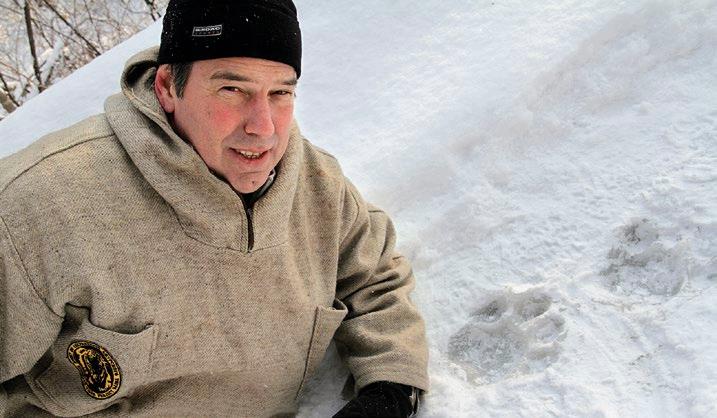 PHOTO: © PATRICK EVANS
PHOTO: © PATRICK EVANS
BACK TO THE WILD
Dale Miquelle tracks tigers using radio collars and traditional bushcraft methods such as “pugmarks” in the snow (pictured) and scent-marking on trees
stabilised the population. A 2015 census found 520 Amur tigers.
But stabilisation is different from growth, which is what makes the Zolushka experiment so intriguing.
NEAR

VLADIVOSTOK, the air had been clear and mild, but as we made our way north, the temperatures dropped and the skies filled with snow. We spent the night in Roshchino. Over a bottle of flavoured vodka, Miquelle booted up Google Earth on his laptop. Beginning in late 2012, five new orphaned cubs were brought to the Alekseevka Centre: three males and two females. In spring 2013, they were outfitted with GPS collars and reintroduced into the wild at two different locations in the Russian PriAmur region. The coloured lines on the Google Earth display represented their tracks.
Range of the Amur tiger in the late 19th century Modern range MAP

displayed data from Zolushka’s collar. Zolushka was released in May 2013 in Bastak Zapovednik, some 300 miles north of Alekseevka. “The thinking was that Bastak had plenty of boar and red deer,” Miquelle told me. “But most importantly, this was an area where there were once tigers, and now there weren’t. It was an opportunity to recolonise a tiger habitat. That’s totally unheard of.”
Two of the male cats ranged hundreds of miles from their drop site across mountain ridges and soggy marshland. The third male and the females staked out an area and remained near it, making shorter trips to hunt for prey. Miquelle brought up a second map, which
From his home, Miquelle watched the GPS data for evidence of Zolushka’s first kill in the wild. Five days after her release, her GPS signal went stationary—often an indication that a tiger has brought down prey and is feasting on the carcass. After Zolushka had moved on, rangers found the remains of a sizable badger at the site. In the ensuing months Zolushka killed deer and boar.
Then, in August, Zolushka’s GPS collar malfunctioned. “I was really
FEBRUARY 2019 • 69
JAPAN
CHINA CHINA BASTAK
PARK
Scientists hope that reintroducing orphaned tigers will help restore the endangered predator’s formerly vast range
Sea of Japan Sea of Japan
JAPAN RUSSIA
NATURE RESERVE UDEGE LEGEND NATIONAL
BY GUILBERT GATES

freaked out,” Miquelle told me. “She’d survived the summer, but winter is critical. A cat has to be able to eat and stay warm.” If it can’t, it will often approach villages to search for easier pickings, like cattle or domestic dogs. Humans are put in danger, and the cat is often killed.
In September, the team was able to use the radio signal from Zolushka’s collar to roughly pin down her location near the Bastak River. That winter of 2013, Miquelle travelled to Bastak. He and a pair of Russian scientists found a set of recent tracks, which met at several points with boar prints. Curiously, there was a set of larger prints, too: another tiger. Camera trap images soon proved what Miquelle and others had previously dared only to hope: the second tiger was a healthy male.
IN THE MORNING it was still snowing. Three miles out on the ferry road and we started to see cars in the undergrowth, stuck. The desolation was complete.
Battling poaching in the Far East has always been a difficult proposition: people are poor and often desperate, and the sheer size of the area makes law enforcement difficult. WCS has teamed up with other organisations to educate locals about the importance and fragility of the Amur population. But Miquelle remains under no illusions that he will get through to everyone. “Sometimes, poachers are poaching because they’re starving, and they need food for their families.” In the Far East, a dead tiger can go for thousands of pounds.
Yet there has been progress. In
70 • FEBRUARY 2019 PHOTO COURTESY BASTAK NATURE RESERVE
BACK TO THE WILD
Zolushka was photographed by camera traps after she was returned to the wild
2010 Vladimir Putin presided over an international tiger summit, in St. Petersburg, where 13 countries pledged to double the world’s tiger population by 2022. And in 2013, the Russian president spearheaded the enactment of a strict anti-poaching law that made possession of tiger parts a criminal offence punishable by a lengthy spell in prison. In addition, at the end of 2015, the Bikin National Park was created by the Russian Federation. Covering more than a million hectares, it will be the largest protected area for Amur tigers in the world.
But as old threats are addressed, new ones arise. Miquelle is particularly concerned about the arrival of canine distemper disease in tigers. “With conservation, you win battles, but not the war. You’re in it for life, and all you can do is do your best, and hand it over to the next generation.”
At the Udege Legend ranger station, we were joined by a squad of inspectors and two WCS team members: David Cockerill, an American volunteer, and Kolya Rybin, Sasha’s older brother. We piled into two trucks and made our way into the hills. The staff estimated that there were close to ten tigers in the area, so Miquelle had arranged to lend them 20 camera traps.
We drew to a sudden halt in the shadow of a high ridge. Tigers often
frequent the bottom of cliff faces, where there is shelter from the driving winds. It was a good place for a trap, Miquelle said.
Rybin strapped up two cameras about ten feet apart. To test the first lens, a ranger crouched down and passed in front of the camera. A red light blinked; motion had been detected. The rangers cheered.
ONE EVENING, Miquelle invited me to his home to look at pictures captured on camera traps in Bastak. Zolushka was strong, selfassured, completely at home in the wilderness. Finally, we came to the other tiger: a thickset male who had been given the name Zavetny.
Zavetny and Zolushka seemed to be sharing a range. Miquelle was hopeful that one day he would see a photo showing Zolushka, who was then of breeding age, with cubs. Two years after her release, the team received a photograph from a camera trap showing two cubs trailing behind Zolushka. “Zolushka has made history and made us all feel like godparents,” says Miquelle, with a smile.
Photographs have documented the growth of her two cubs, who will soon be dispersing into the wilds of Bastak Reserve to find a home of their own, continuing the recovery process that began with Zolushka’s arrival some five years ago.
FEBRUARY 2019 • 71
SMITHSONIAN MAGAZINE (FEBRUARY 2015), © COPYRIGHT 2015 BY SMITHSONIAN INSTITUTION, SMITHSONIANMAG.COM READER’S DIGEST

ROMANTIC SPAS
February is the month of romance, and nothing says “us time” like a trip to a secluded spa…
BY ANNA WALKER
British BEST OF
72

Pennyhill Park and Hotel SURREY
Surrounded by a leafy park, this stylish Surrey spa offers real variety, making it a great choice for first timers who wish to try a little of everything. With both indoor, outdoor and hydrotherapy pools, visitors are spoiled for choice when it comes to taking a dip and the ice cave, herbal sauna, outdoor hot tub and ballroom pool with underwater music keep things exciting.
From the outside, the 19th-century house looks more like something from a Brontë novel. With a gorgeous ivy-covered exterior and surrounding gardens, taking a turnabout the 123-acre grounds could prove just as relaxing as the spa experience itself.
The nearby Michelinstar restaurant, The Latymer, offers a finedining accompaniment to a day of romantic relaxation, but be sure to book, it’s a popular spot.
exclusive.co.uk/the-spa
INSPIRE
FEBRUARY 2019 • 73

Spa Themes MANCHESTER
The steamily-named Fifty Shades of Spa Couples’ Retreat is great for those seeking a weekend focused on privacy. The intimate package includes a 45-minute couples’ massage as well as an hour of private access to a romantically candle-lit, salt-infused cave spa complete with infinity jacuzzi.

Spa Themes is known for its immersive, themed spa days so it’s also ideal if you’re looking for a change from the more traditional schmaltzy Valentine’s. You could sample the Willy Wonka Chocolate themed spa, which includes a chocolate chip body scrub treatment alongside a host of sweet treats, or escape the February chill with the Paradise Beach package, which will have you unwinding in a piña colada scented steam room.

With so much to explore in Manchester, why not extend your spa trip to a romantic weekend and take in some of the sights of the city. spathemes.co.uk
74 • FEBRUARY 2019
Corran Resort and Spa WALES
As you float in the large, blue pool, head tipped back to look at the twinkling star-like lights above, that “aah” moment will sink in at this charming Carmarthenshire country getaway.
With cosy fireplaces and snug accommodations, this is the ideal spa for couples in search of a dose of rustic charm. It’s a must for history lovers too, as the 16th-century building at the heart of the hotel has been expertly restored and is
surrounded by the scenic Towy estuary and marshland.
The focus at the Corran Spa is on aromatherapy, but pausing between treatments for a relaxing dip in the pool, a few rounds in the gym or unwinding with a polished manicure is always encouraged.
Overnight stayers are greeted with a bottle of prosecco in their room—a surefire way to get the romance started. thecorran.com

READER’S DIGEST FEBRUARY 2019 • 75

Royal Crescent Hotel and Spa BATH
Bath is one of the spa capitals of the world thanks to the ready supply of thermal spring water which once made it so popular with the Romans.
Combining the fame of Bath’s spa waters with the fame of its Royal Crescent—an iconic row of 30 Georgian terraced houses near the city’s centre—is the Royal Crescent Hotel and Spa, which sits directly in the middle of the picturesque terrace.

The five-star hotel is a sanctuary away from the city and their Romantic Hideaway package includes a 60-minute couples’
massage, delicious three course champagne dinner and use of spa facilities including Himalayan saltinfused sauna, blossom steam inhalation room, a vitality pool and a 40ft candlelit pool—the height of luxury relaxation, the way our Roman ancestors intended.
royalcrescent.co.uk
BEST OF BRITISH 74 76 • FEBRUARY 2019
Spa Verta at the Crowne Plaza
LONDON
The Crowne Plaza’s Couples’ Refinery Package is an underground haven of relaxation, tucked away in London’s busy Battersea district. With a spacious, dimly lit poolcome-jacuzzi, several steam rooms and experience showers, it’s ideal for those looking for a simple yet luxurious day of relaxation away from the hustle and bustle of the capital.
The 55-minute couples' massage treatment offers just the right length of time to fully unwind, and experienced masseurs are able to
ease even the tightest of knots—great news for those who spend all day sitting at a desk.
A surprising highlight is the twocourse lunch. With unexpectedly fine dining and an included glass of prosecco, we’d recommend the delicious vegetable pithivier or Thai green curry. The restaurant looks out over a riverside helipad, which adds a sense of James Bond glamour to the occasion. Check out spabreaks. com for a thorough review of the Plaza experience.
crowneplaza.com

READER’S DIGEST
The Scarlet NEWQUAY
There are few sensations more relaxing that sitting in the sunshine and closing your eyes to listen to the gentle lapping of the sea. At the Scarlet Hotel in Newquay, spa visitors can do just that during breaks between relaxing treatments.
For a mind and body experience, we’d recommend sampling one of the unique “Scarlet Journey” treatments. The Rediscover Couples' Journey includes a two-person synchronised massage, bathing ritual, clifftop hot tub session and the option of a massage lesson, perfect for couple bonding—and possibly a few giggles—during your romantic escape.
For those averse to the traditional spa environment, there’s also a range of “Set the Spa Free” treatments on offer, which bring massage and manicures into the stunning surroundings of the Cornish countryside, perfect for getting back to nature.
scarlethotel.co.uk


BEST OF BRITISH

Jetty Spa at Gilpin Hotel and Lake House LAKE DISTRICT
Nestled away in the Lake District’s tree canopy are cedar-clad cabins, elevated six feet above ground, with their own personal spas. This Swedish-inspired experience has been designed specifically with couples in mind and the floor to ceiling windows of the cabin overlook a tranquil private lake.
The Jetty Spa’s treatment menu is extensive, and couples can book in for all manner of massage techniques as well as facials, manicures and pedicures.
For even more luxury, the hotel’s five-star individually themed spa lodges have wonderful views of the Lake District moors as well as private outdoor hydrotherapy hot tubs surrounded by walled gardens. And after a hard day of pampering yourself, what better than to fall into one of the lodges' king sized beds? thegilpin.co.uk
For the ultimate guide to Britain's best spas and an array of special offers, visit spabreaks.com.
FEBRUARY 2019 • 79 READER’S DIGEST
Musician Skin is the lead singer and guitarist with British rock band Skunk Anansie, who are celebrating their 25th anniversary with a new live album. She has also released solo albums and has been a judge on the Italian X Factor

IF I RULED THE WORLD Skin
Women and men would be equal. If you call yourself a feminist it’s simply because you want women to have the same rights as men. It’s an issue that’s become overly complicated when it’s actually quite simple: if you’re going to choose the best person for the job, go with the best person whether they’re male or female.
You’d need to be more qualified to become the US President. Having
been on a reality TV show is not a good enough criterion for you to be the leader of the biggest free country in the world. There should be more depth to the person who’s chosen to run America. The President should be well-read, well-informed and intellectually competent.
I’d change attitudes towards motorbike riders. As a rider myself I think we should be allowed to use bus
80 • FEBRUARY 2019
lanes all the time because it would be much safer. It’s a really cool form of transport but there’s so much negativity towards it, with this idea that, “riding a motorbike is really dangerous.” That’s because we’re not looked after on the streets but I still think it’s a fun, edgy way to get around a place.
I’d bring back youth clubs. Nowadays, with the erosion of youth clubs, teenagers have nowhere to go and nothing to do so it’s easier for them to get into gangs and be out on the streets. It’s really sad when you see statistics about how many youth clubs have closed and you think, What are those kids doing now? They’re still out and about with their mates but instead of doing activities that are productive, such as playing table tennis or making music, they’re being unproductive.
Everyone would play table tennis. And not just teenagers. I played it when I when I was young, I play it now and it’s a really fun competitive game. It’s great exercise too and the more you play it the better you get. I absolutely love it.
There’d be no genetically modified food. It hasn’t been tested for long enough and I don’t think it’s healthy or good for your system. There are lots of chemicals in it and I wonder if in 20 years’ time we’ll be going, “Oh,
we shouldn’t have done that”—the same way we were about, let’s say, silicone breast implants. At the very least, if something is genetically modified, it should say it on the packet so people have the choice.
There’d be no blame culture. It holds people back from making mistakes and experimenting, especially with the rise of social media where everyone’s a critic. Making mistakes is the path to truly great art. It doesn’t come out of getting everything right all the time and never annoying anybody, it comes out of being edgy, finding your way and learning.
People would be less easily offended. It kills discussion. If you have to be careful about what you say and you worry about speaking your truth then you’re not being honest. Argument and discussion are where you build your philosophies on life. Coming back to social media, I’d do away with fake names and fake accounts because if there weren’t trolls it would cut down on the negativity. You should be able to say what you like but transparently. Plus, if they had to own up to their opinions, [online bullies] would think twice before posting stuff.
As told to Simon Button
Skunk Anansie’s new album
25LIVE@25 is out on January 25
FEBRUARY 2019 • 81
INSPIRE

CHANGING Tides
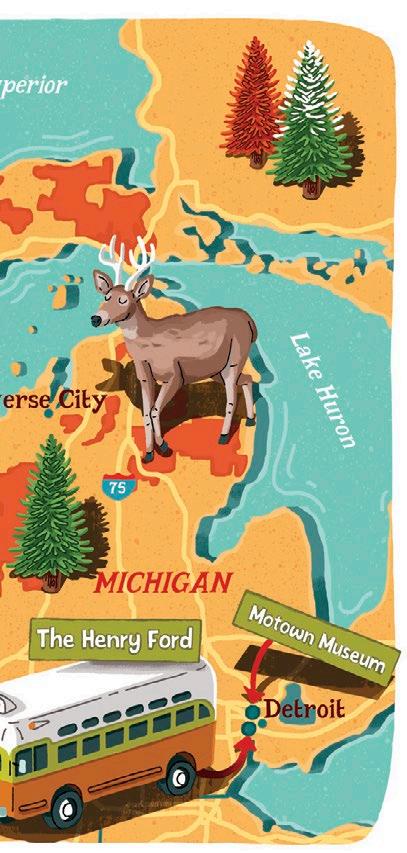
The passport control agent peers down from his desk, taking in my colourful t-shirt, unscuffed white trainers and my nervous, smiling expression.
“What are you doing in Detroit?” he asks, bushy eyebrows raised in incredulity.
I stutter something about my desire to travel through the Great Lakes region, joining international journalists from as far afield as China on a road trip that will begin in Motor City and end in Minneapolis.
“Well, don’t stay out after 5pm. And don’t venture away from downtown,” he barks. “You’re in a big American city now. We have guns here.”
I’m in the States to experience the great American road trip in a destination frequently touted as the new New England. The Great Lakes region is transformed in the autumn, with the expansive scenery (some lakes are so vast it feels more like standing on the ocean edge—Lake Superior alone is larger than the country of Switzerland) surrounded by the orange, yellow, white and cherry reds of the fall leaves. We plan to complete the tour in just one week, stopping each day to take in the diversity of this extraordinary region, where tourists flock to experience the “real America”.
Anna Walker takes a road trip through America’s Great Lakes, a region that confounds as much as it delights
TRAVEL & ADVENTURE 83

DETROIT IS UNDERGOING
something of a renaissance after making history in 2013 as the largest US city to file for bankruptcy. At this point the city’s population had declined from 1.8 million in the manufacturing heyday of the 1950s to just 700,000 and streets of once-magnificent buildings lay abandoned, falling into dramatic disrepair. Stylising itself now as the great “comeback city”, billions of dollars have been pumped into its renovation with hundreds of restaurants and hotels opening each year to tempt tourists back to the area.
To really comprehend the riches to rags story of Detroit, it’s imperative to visit the Henry Ford Museum. Michigan’s most frequented attraction, it explains how transportation transformed America through a museum, village (the main street of which inspired Walt Disney to create Disneyland) and the Ford factory itself.
There are some 26 million artefacts here, 90 per cent of which were collected by Ford himself. Amidst rows of world-changing cars (including the limousine in which JFK was shot) we see the Rosa Parks bus, the chair in which Abraham
AMERICA’S GREAT LAKES 84 • FEBRUARY 2019

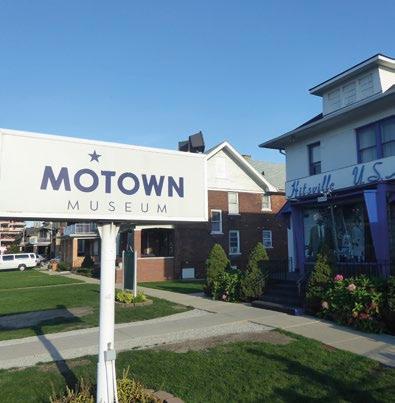

Lincoln was assassinated (complete with blood and hair oil staining) and a replica 1950s drive-thru burger joint. There’s even a 128-year-old doughnut—that’s how random and expansive this dizzying collection of Americana is. It’s a shock to the system to be transported back to the 21st century when we visit the Ford Factory, wide-eyed as we observe a futuristic, semi-robotic production line which churns out an F150 truck every 53 seconds.
Of course, it’s impossible to visit to Motor Town without dropping in on the Motown Museum, the musical heart of Michigan. Berry
FEBRUARY 2019 • 85 READER’S DIGEST
Gordy dreamed of producing artists in the same way that Henry Ford produced cars: a production-line approach to grooming young teens into superstars by teaching them etiquette, style, dancing and singing.
As we drive back through the balmy evening, I notice the final stragglers from a protest. Held limply aloft, their boards read, “One Job Should Be Enough”. As hard as Detroit tries to shake off its past, it seems unrest still remains.
THERE ARE MORE DECIDUOUS trees in the Great Lakes region than in all of New England, and as we move further north, the colours intensify. The autumn hue begins in the north in early September and can last as late as November in Illinois.
We’re headed to Traverse City, where farmland and vineyards have moulded the region into a verdant oasis. Some parts could be mistaken for the sunny climbs of Italy or Southern France rather than the now-freezing reaches of Michigan. When I arrived in Detroit I was met with 25°C heat and sweltering sunshine. Now the temperature has dropped to a coat-tightening -2.
Our group spends the next few days touring quaint harbour towns. Though I’d eagerly anticipated a trip to the Pictured Rocks—beautiful mineral formations that look as though somebody has taken a paintbrush and streaked them with
colour—the weather has turned against us and whipped the waves on the lake up to a frenzied 10ft. We drive on.
Although the winds shake the walls of our van as though it were made of cardboard, the lakes remain a deep Mediterranean blue. A rainbow arches gently over us as we cross the five-mile Mackinac bridge and the trees on the land beyond the passage emit a faint amber glow.
THE UPPER PENINSULA
REPRESENTS a very different way of life to the rest of the region. There are more deer here than people and the land has a wild, unspoiled air. One local couple—who moved from urban Minneapolis to raise their young daughter in a more pastoral landscape—introduce themselves as “uppers” and raise both hands in the shape of their state to tell me they live “just above the knuckle of my ring finger.”
We awake the next morning to a thin blanket of snow and find the temperature has dropped even further. The hotels in this region are far from five star, but they’re homely, and run by affable locals. I breakfast with a group of rosy-cheeked men who are here for the winter sports season. They’re dressed far more weather-appropriate than me.
As we drive through Marquette, a pretty, popular overnight city stop on the waterfront of Lake Superior,
86 • FEBRUARY 2019 AMERICA’S GREAT LAKES

THE AUTUMN HUE BEGINS IN THE NORTH IN EARLY SEPTEMBER AND CAN LAST AS LATE AS NOVEMBER IN ILLINOIS
the fusion of winter and autumn is disorientating. The trees along the roads here look as though they’ve been dusted with icing sugar, evergreen pines nestled between the bursts of autumn oranges, yellows and fiery cherry reds.
Each home that we pass, isolated and surrounded by fields, tells a story. One dark, wooden house is encircled by an eerie cemetery, while another spacious farmhouse is boxed in on all four sides by tall, neatly planted firs.
It’s easy to imagine the history of these homes, to picture ancestors planting the trees, passing their lives in the house, then being lowered to rest in the grounds outside.
FEBRUARY 2019 • 87 READER’S DIGEST
The Manistee River High Banks, known by locals as the "High Rollaways" near Traverse City, Michigan

WISCONSIN'S COPPER FALLS
State Park is ideal for stretching car-stiffened legs. Known for its spectacular waterfalls, autumn carpets it with a thick layer of golden leaves. A vicious waterway dubbed the “Bad River” by Native Americans courses through the park, clashing with the Tyler tributary to create spectacular, if ferocious, waterfalls. There are wolves, deer and bear in the surrounding woods, and although the trail is carefully cultivated, the distinction between civilisation and the natural world feels hazy. It’s hard to conceal my shock when our thick-accented guide proudly boasts that her son killed a bear just that morning.
Freezing but invigorated, we drive
on to the traditional Mogasheen Resort, where we’re ushered into a charming log cabin which smells of sweet burning wood.
Thermoses of hot cocoa with crème de menthe are thrust into our cold hands and warm brownies are stowed in our pockets as we clamber aboard a pontoon to take a bracing ride across Jackson Lake. The kindly couple who own Mogasheen (which translates as “Little Moccasin”) inherited it from their parents, who bought the land from Native Americans some 56 years ago. Their son and his wife will take over soon, marking three generations of hospitality.
The on-the-road lifestyle is what
88 • FEBRUARY 2019 AMERICA’S GREAT LAKES
The Cascading Waterfalls of the "Bad River" at Copper Falls Park
THERMOSES OF HOT COCOA WITH CRÈME DE MENTHE ARE THRUST INTO OUR HANDS, AND WARM BROWNIES ARE STOWED IN OUR POCKETS
of Sunday bells. I’m transported to Bedford Falls as we meander down the thriving theatre street and watch locals enjoying the snow.
For our final day we head to Paisley Park. Once the home of Prince, it’s been transformed into a site of musical pilgrimage by the team behind Graceland. Phones are banned, and the property takes on the air of a sacred space with the musician’s ashes housed in the rafters, looking down on the visitors to his former fortress. Our young tour guide narrates the musician’s life and his emphasis on the theme of universal love in hushed, reverential tones,
Prince’s iconic symbol pinned to his bright purple tie.

makes this trip so special. Everyday activities like stopping for petrol become an adventure as we rummage through racks of brightly coloured candies and leaf through the colourful pages of American magazines. Each day brings a change of scene, temperature or time zone and new, welcoming faces.
AFTER
A WEEK ON THE ROAD, WE
arrive in Minneapolis. It’s a vibrant, young city with 11 miles of sky walkways between the buildings, so the residents never have to venture outside when it’s cold. As the snow falls in fluffy flakes, the city takes on a dreamy quality and the nearby Basilica of Saint Mary rings out a peal
Prince’s message of unity follows me to the airport as I reflect on my time in this disparate region. Quiet, yet bustling. Cold but vibrant. Friendly but happy to be left alone, it’s a province of contrasts.
Just as you try to pin the Great Lakes down to a series of words or pretty descriptions, they morph and change before your eyes. Those striking fall leaves become hidden beneath snow. That lilting open water is whipped into a frenzy. A born-again city reveals unresolved tension. Deer that pose for photographs suddenly flee into woodland. And a week on the road becomes a day on the plane, becomes an hour on the train, becomes a long, hard-earned sleep.
READER’S DIGEST FEBRUARY 2019 • 89

Modern-day Warsaw wavers between socialism and conservatism, modernity and tradition…
City
Edge on
BY HÉLÈNE DE BILLY
ELEVEN O’CLOCK AT WARSAW’S LEGENDARY A. BLIKLE CAFÉ. As I
sit down, dazzled by my sumptuous plate, I find my phone and snap the assortment of wonderful rolls, scrambled eggs, ham, cheese, and irresistible paczki (Polish doughnuts) laid out before me.
The Warsaw mermaid, symbol of the city, bandishes a sword and shield.
An hour goes by, and I ask for the bill. Dressed in livery, the waiter suggests I put away my wallet. The man at the table behind me has taken care of it. I turn my head. My benefactor has left, preferring to remain anonymous. A Polish gentleman.
Such is Warsaw, a city of exquisite food and enduring courtesy. For those who return after an absence, the city exudes a sort of poetry, an art de vivre that arises from the past. “Something undefinable,” confesses Elizabeth Gdulewicz-Jelen, a sculptor who fled the communist regime and settled in Montréal 40 years ago.
When in Warsaw, Elizabeth lingers on the Chopin benches. An initiative to mark the 200th anniversary of the Polish composer’s birth (1810–1849), the 15 benches play excerpts of Chopin’s works. At the touch of a button, passersby can listen and gaze at the Royal Castle or the ramparts along the Vistula.
Warsaw wavers between withdrawing and opening itself to the world.
In October, on the eve of my arrival, the Rosary at the Borders procession brought together demonstrators along the country’s borders and airports. Armed with rosaries and holy images, the faithful reaffirmed Poland’s catholicism and the need to “protect” it from secularisation and Islam. But the ruling conservative government effectively shut the door to asylum seekers quite some time ago and many observers claim that the threat foreigners pose is largely imaginary.
The conservative government effectively shut the door to asylum seekers quite some time ago
Known as the “Phoenix City” for rising from its ashes after being virtually annihilated during the Second World War and ravaged by four decades of communist dearth,
Poland is in the midst of a crisis. Since 2015, the conservative Law and Justice (PiS) party has stepped up measures to restrict judiciary powers and gag the press. Week after week, Warsaw is the stage of demonstrations and counterdemonstrations. A nation divided.
TRAVEL & ADVENTURE
PHOTO: ©ROLANDAS MISIUS/ALAMY STOCK
FEBRUARY 2019 • 91
KRZYSZTOF
MATERNA, AN OPPONENT of the regime during the communist era and the coauthor of a popular Nineties TV series recently resurrected online, sees the current government’s actions as a menace to democracy. “The state-inspired patriotism has extremely corrosive effects on society,” he tells me.
At nearly 70, Materna continues to condemn the government’s abuse of its power. The play he directed in a Warsaw theatre in the autumn of 2017 voiced hostility toward right-thinking racism and the fossils who manage to breathe new life into the dark demons of the past.
Behind the wheel of his well-appointed Audi, Materna is far from a sentimental hippie. He believes that freedom is also market freedom and the freedom to get rich. But, as he explains, the collapse of the Eastern bloc left many in dire straits, and that very gap between rich and poor is partially responsible for the problems shaking Poland today.
bookstores are treasure troves for book lovers (not trinket lovers, as they are at home), churches are full on Sundays and most couples have a stroller in tow. Like all the world’s capitals, Warsaw is home to jazz, punk, rock, and gay bars. But freedom isn’t always a given. On the night I happened on a lesbian bar, the location was secured by hulking bouncers—evidence that this type of event isn’t without risk.
Downtown, stylish restaurants have popped up where locals once queued for basic necessities. Where there were back-alley dealings, there’s now an urban centre with financial institutions, glass skyscrapers and shopping districts.
Still, Warsaw remains a welcoming city, relieved to have survived the cruelty of the 20th century
The subway stations are like galleries; the cemeteries like public gardens, and the public gardens like enchanted forests.
Like her former compatriots, Jelen is proud to see the nation’s economic growth, driven by the strength of its manufacturing sector.
Still, Warsaw remains a welcoming city, openly relieved to have survived the cruelty of the 20th century that ushered Hitler and Stalin into this world (and Poland).
Few vagrants roam the immaculate streets. Women are elegantly dressed,
It has been nearly 30 years since the fall of communism. In many ways, Varsovians have turned their backs on this chapter in their history. Case in point is the mammoth Palace of Culture and Science, spurned symbol of Stalinist architecture that, after much debate, citizens decided
PHOTOS, CLOCKWISE FROM TOP LEFT: ©JACEK KADAJ/GETTY IMAGES; COURTESY OF A. BLIKLE CAFÉ; ©RAGA/GETTY IMAGES
CITY ON EDGE 92 • FEBRUARY 2019


 Clockwise from top left: the Museum of the History of Polish Jews, built on the site of the former Warsaw Ghetto; doughnuts from the A. Blikle Café; the 755ft Palace of Culture and Science, a gift from the Soviet Union
Clockwise from top left: the Museum of the History of Polish Jews, built on the site of the former Warsaw Ghetto; doughnuts from the A. Blikle Café; the 755ft Palace of Culture and Science, a gift from the Soviet Union


 Clockwise from left: The historic Royal Castle, rebuilt after it was destroyed in the Second World War; one of the lavishly decorated rooms in the castle; a Warsaw metro station, modern, clean and efficient
Clockwise from left: The historic Royal Castle, rebuilt after it was destroyed in the Second World War; one of the lavishly decorated rooms in the castle; a Warsaw metro station, modern, clean and efficient
Paradoxically, those hellbent on erasing all traces of the regime have embraced a revisionist history worthy of Cold War-era Stalinism itself. Claiming that John Lennon’s “Imagine” is a communist manifesto, a right-wing city councillor sought to change the name of the street named in the Beatle’s honour.
Fun and colourful reminiscences of the dark years.
There’s a similar sense—minus the humour—in the capital’s last milk bars, sparingly decorated cafeterias that serve old-world dishes (Polish borscht and breaded pork chops) that perhaps only locals could love. Bambino milk bar on Krucza Street is one of the rare canteens that outlasted the Soviet years, where straight-faced government employees hand customers their plate from behind the counter.
First-time visitors rarely perceive the ghosts, whose presence is palpable in ancient cities like Warsaw
Today, with authorities effectively threatening to wipe out all the street names with a communist connotation, one clothing label lightheartedly flaunts the past. Pan Tu Nie Stał recalls the long lines of customers who spent hours in front of empty storefronts waiting for shops to open. Elizabeth provides the translation: “When someone tried to cut the line, they were rebuffed with, ‘You weren’t there, Sir!’ ” The Koszykowa Street boutique is inspired by the iconography of the communist period: socks that evoke the unheated apartments, vintage mugs and more.
FIRST-TIME VISITORS usually take away a city’s sights, photographs of monuments, theatres, churches, fountains, delicious meals. But as they amble through the Old Town, linger on a park bench, or attend a baroque music festival, they rarely perceive the ghosts, whose presence is palpable in ancient cities like Warsaw.
While some carry the names of terrifying dictators, others, like the Warsaw mermaid, are the stuff of dreams. Symbol of the city, she emerged from a dragon brandishing a sword and shield. Across the modern city, she is ubiquitous, a tiny refugee carried by the river, a tiny saint that has transcended all religions, political parties and governments. to preserve. “I think we ended up laughing about it,” observed Elizabeth. She is proud to see the nation’s economic growth driven by the strength of its manufacturing sector. “We cannot forget what the country went through but we can tackle it with humour.”
READER’S DIGEST FEBRUARY 2019 • 95

Dazzled by Dubai My Great Escape:
Esther Newton from Berkshire has her expectations turned on their head when she visits a friend in the UAE
For two years a good friend had been urging me to visit her in Dubai, where she was working as a teacher. But I have to admit I really wasn’t keen. Perhaps I’d read too many negative newspaper reports about the city’s rules and regulations. Or perhaps I simply thought the architecture too modern and ugly.
Eventually I gave in to the pleas and travelled to Dubai to stay with my friend for five days. At the airport, I was given a warm welcome and instantly I knew my insticts about the city were to be proven wrong.
It really is a place of wonder and opulence. I thought I’d been to a big shopping mall before, but never have I been to one with an underwater zoo, ice rink, fountains, flight simulators, or the entrance to the world’s tallest building, the Burj Khalifa.
When I stepped out of the elevator and took a first peek out the window of the building, on level 148, all I could think was, Wow, wow, wow! The hotels and towering skyscrapers that had looked huge from ground level,
suddenly appeared miniscule. I felt as if I was looking down at a model village. Yet, I’d stood near some of those buildings earlier and marvelled at their structure and presence. As I walked onto an outside viewing platform, the wind whipping around me and the stifling scorch of the heat assaulting me, I felt as if I’d been taken to a whole new world. It’s a moment
I’ll never forget.
Though tempted, I didn’t remain at The Dubai Mall for my entire stay. There were plenty of other sights to enjoy. My friend took me to the soft golden sands of Jumeirah Beach, to a lavish brunch brimming with tasty treats, as well as to a traditional and vibrant Arabian market (a souk).
There were also other trips planned —to Atlantis Aquaventure Waterpark and to a mosque, but there’s only so much you can pack into five days. It looks like I may well have to go back…
Tell us about your favourite holiday (send a photo too) and if we print it we’ll pay £50.
Email excerpts@readersdigest.co.uk
98
96 • FEBRUARY 2019

TRAVEL & ADVENTURE 97
ISLAND GETAWAYS
FOR CASTAWAYS: PRINCIPE
West of Africa’s mainland, small Principe offers paradise—jade seas, yellow beaches, jungly peaks, whalewatching—but also authenticity, with revived cacao plantations to visit and locals to meet. Luxury eco-resorts help, too (rainbowtours.co.uk).
FOR STAYCATIONERS: BRYHER
The handsomest of the Isles of Scilly, 25 miles from Land’s End, Bryher accompanies the archipelago’s wondrous beaches and subtropical gardens with a windy, wild coast path. The upmarket Hell Bay hotel does acclaimed food (hellbay.co.uk).
FOR THE CLEAR-LUNGED: ASTYPALEA
Turns out there are still unspoilt Greek islands out there. Butterflyshaped Astypalea, which banned cigarettes in 2019, boasts pretty shingle beaches as well as sugarcube houses and blue-domed churches in main town, Chora (visitastypalea.com).



FOR THE SYMPATHETIC: DAYDREAM ISLAND

Hugging the Great Barrier
Reef, Australia’s Whitsundays were badly hit by 2017’s Cyclone Debbie. Recovery has been hard, but the escapist, turtle-protecting Daydream Island Resort will thankfully reopen in April (daydreamislandresort.com).
FOR FLY-AND-FLOPPERS: DOMINICA
Waterfalls, boiling lakes and tropical gorges render Dominica the Caribbean’s most outdoorsy isle. But it also does languor: if mass-market resorts aren’t your bag, the six-villa Secret Bay is close to fabulous coves (secretbay.dm).
by Richard Mellor
Travel app of the month
GATEGURU , FREE, ANDROID, IOS & WINDOWS
Airport stress? Long gone. GateGuru not only stores boarding passes, but lets you know the gate number, security waiting times and flight status, and recommends restaurants.
TRAVEL & ADVENTURE 98 • FEBRUARY 2019
MEADOW


GREEN A collection of one & two bedroom luxurious retirement living apartments opening early 2019 Reservations are now open for Anchor’s latest development. Visit our stylish show homes for more information.










Relive the memories of buying your first home ESTABLISHED 1968 PROUDLY NOT-FOR- PROFIT 0800 117 0269 | mcsales@anchor.org.uk Show Suite NOW OPEN Monday-Friday, 10am-4pm. Sat by appointment only. 15 Hamilton Road, Sarisbury Green, Southampton, SO31 7PU (Sat Nav SO31 7ZS)
COURT, SARISBURY
Cut The Cost Of Your Council Tax
If you pay your council tax over ten months rather than 12, then in February and March you’ll have a break from payments. But wouldn’t it be nice to see a reduction every month?
Well, depending on your situation, you might be entitled to a discount or cashback on your bill. And if not, there’s a chance you can challenge your council tax band. Last year, 25% of appeals were successful, that’s a whopping total of more than 10,000 households.
Check for a discount
If you live alone, your council tax can be cut by 25%. You get the same discount if you’re the only adult— and that can be the case even if there are under 18s, students and anyone with a severe mental impairment living with you.

Andy Webb is a personal finance journalist and runs the award-winning money blog, Be Clever With Your Cash
You might get a discount if you are on a low income, are disabled, receive certain benefits or are a live-in carer for a non-relative who is disabled, though these are all dependent on different factors.
There’s also a discount for second or empty homes, though that does depend on where you live as each council has a different policy.
Spread out your bill over 12, not ten payments
This won’t reduce how much you pay in total, but it will cut the amount you pay every month. Most councils automatically divide the annual bill over ten months, with no payments due in February and March, but you can request for it to be split over 12 months instead. This can really help with budgeting.
Earn cashback on your bill
If you open a Natwest Reward or
100 • FEBRUARY 2019

Santander 123 Lite bank account you can earn money back on your council tax, as well as other household bills such as energy, water and telecoms. Both accounts come with a fee—£2 for Natwest and £1 for Santander, but the best one for you depends on the size of your other bills as the cashback varies between 1% and 3%.
You don’t have to switch bank to get one of these accounts, though you will need to transfer each Direct Debit yourself if you don’t.
Challenge your council tax
If you’re in the wrong tax band you could save a huge amount of money.
Most properties in England and Scotland were assessed in 1991. Every home had to be quickly rated, and that meant the assessors couldn’t properly check each one. It could even have been just a fleeting look at the outside as they drove by. So mistakes could have been made. However, in Wales the data is from 2003 so errors are less likely, while it’s a totally different system in Northern Ireland.
Finding out if you are overpaying isn’t an exact science, but it’s worth a try. The best indicator of whether you’ve got a case is using the council tax valuation websites for England and Scotland. Enter your postcode and you’ll get a list of your and
FEBRUARY 2019 • 101 MONEY

neighbouring properties, and more importantly, what band they are on. If properties you know as similar to yours are on a lower band, then you might have a case.
The next step is to check the valuation of your property in 1991. First get an idea of what it’s worth now or the most recent sale price.
USEFUL WEBSITES TO HELP YOU CHALLENGE YOUR BILL
You can use sites like Rightmove and Zoopla for this. Then use this figure to estimate the 1991 price using Nationwide’s House Price Calculator. Do the same for a neighbouring property or two in the same band as you. Is there a big difference to the 1991 price?
If both of these tests indicate that you are indeed in the wrong band, you’ve got a good case to appeal to the Valuation Office Agency and you can ask for your council tax band to be reassessed.
A successful appeal means you’ll not only pay less in the future, but you’ll get the money back dated since you moved in, but only after 1993. Of course, it’s a two-way street and there’s a risk you could end up not only pushing your band up higher but everyone on the street too!
Check neighbouring property council tax rates in England cti.voa.gov.uk/cti/
Challenge your council tax band in England gov.uk/challenge-council-tax-band
Check neighbouring property council tax rates and challenge your band in Scotland saa.gov.uk/
Work out what your property might have been worth in 1991 nationwide.co.uk/about/house-price-index/house-price-calculator
102 • FEBRUARY 2019
MONEY
Apps Of The Month
SHOPMIUM
CHECKOUTSMART GREEN JINN
IF YOU’VE GOT A SMARTPHONE
then it’s worth downloading a series of apps which could get you some money back on your supermarket shopping. They work a bit like coupons, but rather than the money coming off at the till, you claim it back after you’ve paid.
The three main apps are Shopmium, CheckoutSmart and Green Jinn. Each one will have offers on selected products which tend to change every few weeks. There could be money off a new brand of biscuits, or cashback when you buy broccoli. Offers are usually specific to one supermarket or another, though some can be picked
up at more than one.
You can filter the deals based on the supermarket you use. Shopmium and CheckoutSmart can be used at all the major supermarkets, while Green Jinn currently only has Waitrose, Sainsbury’s and Tesco.
Claiming your money back is really easy. You simply select the offers you’ve purchased and take a photo of the receipt via the app. Shopmium also requires you to scan the product’s barcode via the app.
Once your request been processed you’ll get your money either added to your app account, or paid straight into your bank. Only CheckoutSmart has a minimum payout (£20), though you can take money out sooner if you accept a 5% deduction.
Of course, it’s not worth buying something to claim some money back if you’re not going to eat or drink the item, though from time to time there are freebies where there’s no harm giving something new a try.
SINGLE AND FREE
These anti-Valentine’s facts could put you off the day of love for life:
33 per cent of divorce cases filed in 2011 mentioned Facebook
Each year Las Vegas issues over 122,000 marriage licenses
35 per cent of people have watched a film or TV show that affected them so much they considered breaking up with their partner
British couples spent a whopping £130m on Valentine’s Day in 2017
SOURCES: AMERICAN ACADEMY OF MATRIMONIAL LAWYERS, BUZZFEED, THE DRINKS BUSINESS
FEBRUARY 2019 • 103 READER’S DIGEST

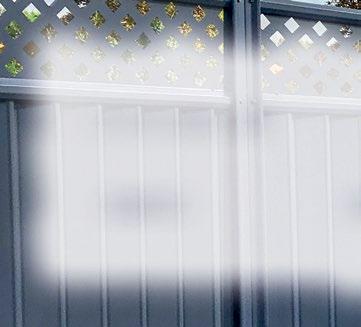

Resolve all your fence problems for the next 25 years! †
PREVENTION IS ALWAYS BETTER THAN CURE.
The moment a fence falls or breaks, you have to deal with third party damage, security and privacy issues, neighbours, quotes, the expense and inconvenience – all at once. Alternatively, a simple call to ColourFence can head off all your problems for the next 25 years! Virtually maintenance-free, before the Spring growing season starts, now is the best time to see our great value, colours & designs. Freephone today.

Even with care Timber fences will perish
“



No painting or repairs for 25 years†

Guaranteed† not to warp, crack, shrink, rot or peel
Withstands wind gusts of up to 130mph
Saves maintenance, time and money –no annual treatment required
Guaranteed to look good for up to 25 years†
Unbeatable value compared to other fences
Create your look with a choice of colours, designs and sizes
No risk professional installation








Despite many coats of preservative, the structure of the wooden fence in our front garden rotted pretty rapidly, and a recent autumn storm sent it off down the road, thankfully missing the neighbour’s car. However, every cloud has a
silver lining, and we now couldn’t be more pleased with the ColourFence replacement which was erected a few days ago. As well as looking good, we are looking forward to years of summers without the burden of cleaning and treating this fence.
Mr & Mrs P. Glam.
“


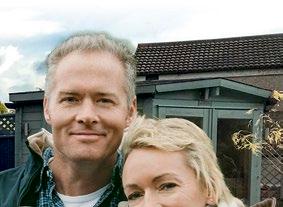

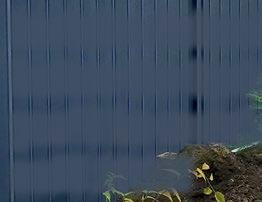























Install a ColourFence before the Spring and you’ll be maintenance-free until 2044! 0800 644 4113 colourfence.co.uk †Hose down occasionally – terms & conditions apply. We’re open 24/7 – to get your FREE GOOD FENCE GUIDE, SAMPLE PACK and no-obligation quote – FREEPHONE CALL NOW! FREEPOST LON15651, London SE1 1BS FREEPOST COLOURFENCE (RD1/19) THE GOOD FENCE GUIDE AND FREE SAMPLE PACK BLACK CAPITALS PLEASE MR/MRS/MISS ADDRESS PLEASE CIRCLE MOBILE EMAIL TELEPHONE NUMBER (To con rm details in case of non arrival) POSTCODE PLEASE SEND ME To see our wide choice of sizes, colours and designs –contact us today!
Spiced Beef Stew
With one more month to go until the clocks change, it’s the perfect time of year to fall back in love with the art of slow cooking and try this rich, Moroccan-inspired beef stew with an exotic twist
Serves 6
• 2tbsp plain flour
• 1tsp ground cumin
• ½tsp ground cinnamon
• ½tsp cayenne pepper
• 800g diced beef
• 20g butter
• 2 onions, diced
• 4 rashers of smoked bacon, cut into lardons
• 2 garlic cloves, crushed
• 1tsp caraway seeds
• 1tbsp tomato paste
• 200ml red wine
• 500ml beef stock
• 175g pitted prunes (drained weight)
• 4 sprigs of thyme
• 2 bay leaves
• 1tbsp mustard

Rachel Walker is a food writer for numerous national publications. Visit rachel-walker.co.uk for more information
1. Preheat the oven to 140°C. Season the flour with the cumin, cinnamon and cayenne pepper. Tip it into a large shallow bowl and then toss the diced beef, until it’s fully coated.
2. Heat the butter in a cast iron casserole dish and when it starts to foam, brown the beef in batches. Remove it from the pan and set aside.
3. Add another knob of butter to the casserole dish and then add the onions and smoked bacon. Cook for 58 minutes until the onion starts to soften and the bacon renders its fat. Add the garlic cloves and tomato paste and caraway seeds, and then cook for a further minute before pouring in the wine. Use a wooden spoon to lift off the bits stuck to the bottom of the pan.
4. Finally, add the beef stock, prunes, thyme, bay leaves and return the stewing beef to the pan. Bring the stew to a rolling simmer, cover with a lid and put in the oven for 3-4 hours.
5. For the final half hour take the stew out of the oven and simmer uncovered. Meanwhile, cut your chosen root vegetable (potato, celeriac, swede) into chunks and simmer until tender. Drain, and mash with butter and a splash of milk. Stir the mustard into the stew and serve in heated bowls, ladelled over a portion of root vegetable mash.
106 • FEBRUARY 2019
FOOD
BY TIM & ZOË HILL

Drinks Tip…
Almost any robust red will work well with this spiced stew—the Parker Favourite Son Coonawarra Cabernet
Sauvignon (Waitrose, £8.49) is great with big flavours and excellent value for money
PHOTOGRAPHY

TREACLE SPONGE
To be clear, a traditional treacle sponge is steamed— but this version takes a fraction of the time and a fraction of the faff. Plus, the muffin-sized serves make the most delightful little treacly islands in a shallow bowl of hot custard.
SERVES 6
• Knob of butter
• 6tbsp golden syrup
• 150g softened butter
• 150g caster sugar
• Pinch of salt
• 2 eggs, beaten
• 150g self raising flour
• 2-4tbsp milk
1. Preheat the oven to 180°C.
2. Use the butter to generously grease six holes in a muffin tray.
3. Put a tablespoon of golden syrup in each hole of the muffin tray.
4. Next, beat the butter and sugar with a pinch of salt, whisking until it’s fluffy and pale.
5. Gradually add eggs and then fold in the self-raising flour and enough milk so that it has a smooth, dropping consistency.
6. Divide the mixture between the six holes in the muffin tray, and then bake for 30 minutes.
7. Carefully flip out the treacle puddings and spoon any leftover topping over the sponges.
8. Serve when piping hot, with lashings of custard.
PHOTOGRAPHY BY TIM & ZOË HILL
FOOD
108 • FEBRUARY 2019



BOOK NOW TO SAVE £50!*
ECT Travel has been creating exciting, experiential tours for over 20 years. We think of you as travellers not tourists.
Gourmet adventures in Paris and London
From £775pp**

London - 2 nights in June or November 2019, staying at the 4* Academy Hotel. Learn to cook and present a showstopping meal under the guidance of a classically-trained chef at Le Cordon Bleu, London; dine on what you’ve made alongside the chef who taught you; stock up on culinary treats and professional kitchen essentials at the Institute’s boutique; enjoy a wine tasting at the hotel; take home a treat-filled goodie bag; enjoy welcome drinks and delicious nibbles at the hotel

From £899pp**
Paris - 3 nights in September or November 2019, travelling by Eurostar and staying at 4* Hotel Mercure Paris Centre Tour Ei el. Learn to cook a Mediterranean-themed meal at a workshop with a classically-trained chef at Le Cordon Bleu, Paris; stock up on culinary treats and professional kitchen essentials at the Institute’s boutique; take home a treat-filled goodie bag; enjoy welcome drinks and delicious canapes at the hotel; experience a champagne/cheese pairing; take in a panoramic view of Paris with a glass of champagne at Montparnasse Tower.
Would you like to cook in the company of classically-trained chefs from the internationally-acclaimed culinary institute. Le Cordon Bleu? Then why not join us for a gourmet adventure in London or Paris? BOOKING
*First 10 to book each tour, will receive £50 o tour price
**From price based on twin/double share, single room supplement applies

NOW 0800 298 0588
333 747
www.ecttravel.com sales@ecttravel.com 01225
Spring Pastels
Refresh your interior for the new year with a palette of sorbet shades that will instantly lift and revive any space

THomes and gardens writer and stylist Cassie Pryce specialises in interior trends and discovering new season shopping
his season is all about embracing a light and bright interior as the days start to grow longer. It’s also the perfect time to update your look with a new and invigorating colour scheme. Pastel shades are naturally associated with spring, as they echo the colourful changes seen outdoors at this time of year. Being such a versatile palette, pastels are one of the easiest groups of colours to work into your home as their soft and muted tones aren’t overpowering; they work equally well in a country-inspired room full of pattern as they do in a pared-back Scandi scheme. There are five main
shades to consider: mint green, blush pink, baby blue, pale lilac and soft yellow—and there are no hard and fast rules about how to use them. You may wish to combine them all or mix and match just a few shades to suit your tastes and add a subtler pop of colour.
Traditionally, pastels have been associated with chintzy, floral wallpapers or children’s bedrooms, but they’ve recently been given a modern makeover to allow them to work in a wider range of schemes. Geometric designs in pastel tones offer a contemporary take on the look and teaming this palette with grey or white will balance it out and introduce a Scandi feel with a more masculine edge. Metallics can also be added for a touch of luxury—pair copper with blush pink for a sophisticated duo, or brass with mint green for a cool combination.
110 • FEBRUARY 2019
HOME & GARDEN

Scandi Simplicity & Colour Crush
Green wire memo board, £10; crewel work cushion, £12; ceramic vase, £14; stacked frames, £14, all Sainsbury’s
111
How To Give Your
Garden Life

While spring may seem like the season of vivacity, late winter can bloom just as much with the right attention, as Jessica Summers discovers
February, as most fervent gardeners know, is a busy month of preparations. It’s a crucial opportunity to get your green affairs in order and give yourself a good head-start for the spring.
Pruning is the place to begin. Many species require rejuvenation to promote new flower growth and it’s a great way to regulate their size, but it’s essential to be aware of which plants need pruning, and when. Climbing plants such as wisteria and roses, and shrubs such as hydrangeas and winter jasmine all need taking care of in the late winter/early spring.
If you have been tending to them routinely, then a normal prune using regular secateurs will do. However, if they’re growing wildly, you’ll need to do a hard prune which will involve a pruning saw—to cut back heavy wisteria stems—and secateurs with
long handles—for cutting back shrub branches to the ground.
As well as tending to existing plants, now is a great time for introducing new life to your outdoor haven. While the weather is still cold, use cloches to cover your vegetable patch. You are bound to see some growing delights if you start with plants such as beetroot, peas, spinach and onions.
For bigger investments, consider planting a bare root fruit tree—for instance: pear, plum or apple— they’re dormant during this time of year, so planting them now should offer plenty of chance to thrive come the summer.
And, as an early treat for the bees, why not plant some snowdrops, which not only look beautiful in the garden display, but are also some of the earliest bulbs to flower.
HOME & GARDEN
112 • FEBRUARY 2019



















0800 326 5167 CALL NOW FOR YOUR FREE BROCHURE AND QUOTE
stairlift has made a massive life changing di erence.” Mrs. Taylorson, Cumbria “Be safe with a stairlift;the perfectsolutiontoyour problemswiththestairs.” Dr Hilary Jones, Medical Advisor to Acorn Stairlifts Next day installation available No more struggling with the stairs Stay in the home you love Suitable for all types of staircase 365-day local service and support Our safe and stylish stairlifts have already changed hundreds of thousands of lives the world over. Let us change yours.
“My
To Buy
Or Not To Buy?

TLisa Lennkh is a banker turned fashion writer, stylist and blogger. Her blog, The Sequinist, focuses on sparkle and statement style for midlife women
his is a question I'm asked almost daily from friends seeking style advice: "Is this particular item worth splurging on?" There are many trends that aren't worth it because they date quickly. Then, there are trends which live longer than anyone ever expects (see skinny jeans and slogan shirts). So how can you tell the difference between a worthy splurge and a regrettable one? Stick to these six rules and you'll stay in savvy, regretfree buying territory.
1. Sleep on it for several days. If you're still obsessing after a cooling off period, maybe it's worth the splurge. I did this a few years ago with a Miu Miu faux-crocodile, 1960s-style car coat. When I saw it, I honestly couldn't imagine my future without it.
I gave it a couple of days and looked at cheaper alternatives… but the choice was easy. It was a (birthday) splurge with zero regrets. I'm still thrilled with it years later.
2. Buy the cheaper version first, then upgrade to the best version if you get a lot of wear out of it. I did this with a black motorcycle jacket many years ago. I didn't know if I was a motorcycle jacket kind of gal or not, so I bought one from the high street. I wore it with everything from jeans to dresses until it became such a part of my personal style that I eventually splurged on a wear-forever quality one.
3. Ensure that it matches your style. There's no point buying expensive pink cashmere in the sales if you're someone who only wears black and neutrals. Don't take up valuable real estate in your closet with regrettable purchases just because they're in the sale. I see and wear a lot of different styles for my job, so this is the rule I'm most likely to break on impulse.
4. Shift your budget. If it's somewhat out of budget, can you give up something in order to make

FASHION & BEAUTY
114 • FEBRUARY 2019

up for it? This one's easy for me. If I want something badly enough, I will practically give up eating to afford it. If you're willing to sacrifice something (a few months of your coffee habit, for example) to fund your purchase, then you're likely onto a worthy splurge.
5. Only buy it if you have the rest of the outfit to go with it already. For me, this means no navy. All of my staples are black; I won't complicate my life with navy. If I bought a navy dress, I'd need other navy pieces to make it cohesive. I just can't be bothered. I stick to black, grey, cream, and jewel tones, which play nicely together and I never have to buy extra items to wear with a new purchase. I made this mistake once with a pair of designer shoes in an unusual colour (on sale, of course). I loved them, but had nothing to wear with them. They sat in my closet for years before I gave up and put them on eBay.
6. Think of cost per wear. Only splurge if you can think of at least eight occasions in the next year when you'd wear it. Here's where everyone is different. I'd personally wear a pair of silver glitter Mary Jane shoes on repeat, but not everyone would. If you love 1970s boho style, then perhaps a suede fringe bag would be a staple for you. Know your style and stick to it on big purchases. Experiment all you like with fashion—that's the fun of it—but not with splurges.
READER’S DIGEST 3 FEBRUARY 2019 • 115
Say It With Roses…
Jenessa Williams on the beauty benefits of a Valentine classic
Nothing says Valentine’s Day like roses. With any manner of codings in their colours, they can represent the early throes of passion right through to undying commitment, as beautiful in a single stem as they are in a lavish bouquet.
This Valentine’s Day, show some self-love by integrating roses into your skincare routine. With its use dating back to Egyptian times, rosewater is known for its keen anti-inflammatory properties, calming redness and eczema as well as helping to maintain the pH balance of skin.
For any winter sun worshippers, rose is also great for tissue regeneration, packed with vitamins A, C and E to brighten the complexion. Simply apply to problem areas and leave to absorb. If you’re craving longer locks, massage rosewater into the scalp as a natural conditioner, or spray on a rose-infused scent to promote mental benefits of wellbeing and calmness. Relaxed and renewed, you’ll be more than ready to enjoy your Valentine's night, whether you’ve got a date or not…

Hero Products
1 Diptyque Rose Infused Face Oil, £84
2 Lanolips Rose Hand Cream, £8.99
3 Arein Beauty Rose Night Table Cream and Overnight Mask, £60



116 • FEBRUARY 2019
FASHION & BEAUTY

Bathmate’s MAGIC Air-cushion! Bathmate is the safest, simplest way to enjoy a proper bath - anytime, anywhere. Bathmate’s UNIQUE air-cushion forms a comfortable seat and back rest. Name Tel No. Address Postcode 0800 072 9898 Visit www.nationwide-mobility.co.uk or write to Freepost Nationwide Mobility For a FREE brochure FREEPHONE ASK FOR EXT 77196 l Over 40,000 sold l Suits most baths, even small ones l No installation required Then lie back safely and luxuriate... IN RELAX Deflates... easing you gently down... 77196 At the touch of a button...up and safely out... OUT TRY IT FOR YOURSELFFREE HOME DEMO For more information and a FREE colour brochure return this coupon to Freepost Nationwide Mobility
CAN YOU EVER FORGIVE ME?
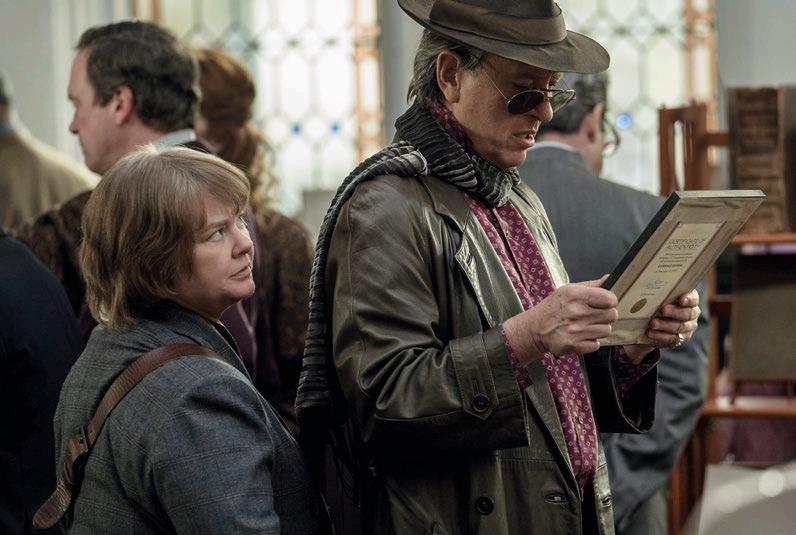
Melissa McCarthy shines as Lee Israel in this moreish biopic of the celebrity biographer who fell from grace
She’s behind with rent, her ageing cat needs medicine, her dependence on alcohol is getting worse by the day and nobody’s buying her books. Lee Israel found herself amidst a particularly rough patch in in the early 1990s, when her Estée Lauder biography proved to be a critical and commercial failure and publicists were refusing to give her an advance for a new book. Desperate times, as they say, require desperate measures, and so, Israel turned to a life of (very niche) crime, embellishing literary letters from famed wits like Noël Coward or Dorothy Parker and
selling them for big bucks to book shops and collectors.
Melissa McCarthy delivers an Oscarworthy performance as Israel, proving she call pull off dramatic roles as easily as her “comedy goofball” template, and Richard E Grant is utterly delightful as her hedonistic friend, Jack, who balances out her neurotic, selfish ways with his charm and flamboyance. The duo’s portrayal of friendship is a thing of pure joy, alternating between vicious verbal abuse and deep affection.
It’s a sweet but biting and darkly funny comedy that’ll shroud you in a charming, old-timey world of authors, letters and typewriters and keep you wildly entertained from start to finish with its whip-smart script and witty banter.
READERSDIGEST.CO.UK/CULTURE/FILM 118 • FEBRUARY 2019 © 20TH CENTURY FOX
H H H H H
DRAMA: GREEN BOOK
Working-class, ItalianAmerican hustler Tony Lip (Viggo Mortensen) takes a job driving the distinguished African-American pianist, Dr Don Shirley (Mahershala Ali) on a concert tour of the American South in the 1960s, which, as he observes, “is going to be trouble.” And trouble it is. As Dr Shirley navigates his way through violent racism and prejudice, Tony never leaves his side, protecting him like a pit bull. As expected, the mismatched heroes learn a thing or two about themselves from
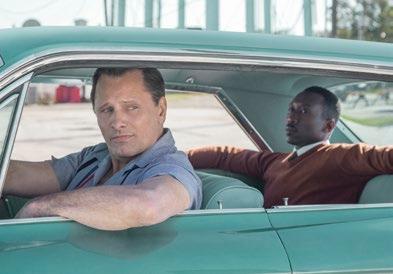
this journey and, more importantly, form a deep friendship. The formula is as old as time yet the charming, wholesome fashion in which it’s delivered will win over even the most bitter cynics.

ROMANCE: IF BEALE STREET COULD TALK
KiKi Layne and Stephan James will make you weak in the knees as the madly romantic couple, determined to make it work against all odds in this moving adaptation of James Baldwin’s novel of the same title. Directed by Barry Jenkins, who made the Oscar-winning Moonlight, it’s a beautiful portrayal of love at its purest and most wholesome, playing out against the ugly background of racial injustice.
BIOGRAPHY: A PRIVATE WAR
Rosamund Pike brings out the big guns in this hard-hitting biopic of the Sunday Times war correspondent, Marie Colvin. Rocking a pirate eye patch and an impeccably cool New York accent, Pike really taps into the complexities of this influential journalist’s personality. At once a fearless reporter and a vulnerable woman, Colvin routinely risked her life in her pursuit of the truth, which ultimately led to her death in Syria in 2012. Though A Private War stumbles over some grating clichés every once in a while, it’s bound to keep you on the edge of your seat.
by Eva Mackevic

FILMS
© ENTERTAINMENT ONE / ALTITUDE H H H H H
H H H H H
H
H H H H

THIS TIME WITH ALAN PARTRIDGE (BBC1; BBC IPLAYER)
What is it? Long-overdue, six-part return to terrestrial TV for everybody’s favourite national embarrassment, played—to excruciating perfection once again—by Steve Coogan.
Why should I watch it? Partridge has been recalled to primetime as the Beeb’s new face of Brexit and putting him in a light-entertainment setting offers infinite possibilities for disaster. He’ll be going some to top the explosive finale of 1994’s Knowing Me, Knowing You which ended with Partridge shooting one guest.
THE VIRTUES (CHANNEL 4; ALL4)
What is it? Four-part social drama reuniting the This Is England team of writer Jack Thorne and director Shane Meadows.
Why should I watch it?
As if the Thorne/Meadows reunion wasn’t appetising enough in itself, the new project stars the fiercely compelling Stephen Graham—This Is England’s skinhead-in-chief, Combo, and one of our very best actors—as a troubled soul returning to Ireland to exorcise the demons of his time in the care system there. Expect heavy-hitting drama, with a typically unflinching yet nuanced central turn—but Meadows also has a knack for leavening even the most despairing plot developments with a cheery, disarming humour.
 by Mike McCahill
by Mike McCahill
WHAT TO STREAM THIS MONTH:
MIRZAPUR (AMAZON PRIME)
Amazon’s response to Netlix India’s Sacred Games: a bloodsoaked soap about two lawyers’ sons descending into the underworld.
PEOPLE JUST DO NOTHING (BBC IPLAYER)
Brentford’s keepers of the pirate radio flame, Kurupt FM, go out on a high with the cult comedy’s hilarious final broadcasts.
SPRINGSTEEN ON BROADWAY (NETFLIX)
An intimate recording of last year’s theatrical hot ticket—the bard’s stripped-back, acoustic one-man show.
TELEVISION
120 • FEBRUARY 2019
READERSDERSDIGEST.CO.UK/CULTURE/FILM BBC PICTURES / CHANNEL 4
ALBUM OF THE MONTH:
ALL BY YANN TIERSEN Convention is the last thing that comes to mind when you think of Yann Tiersen. The French composer’s musical output is as diverse as the range of instruments he plays (toy piano, vibraphone, er, bicycle wheel?). He’s collaborated with everyone from Jane Birkin to Cocteau Twins and produced multiple film soundtracks, including the iconic Amélie. Tiersen’s latest album, All is another wonderfully niche and unique addition to the rich tapestry of influences and cultures that is his music.

Recorded on a small island in the Celtic sea, which has been Tiersen’s home for the past ten years, All explores our connection to nature and the environment through beautiful soundscapes, bridging the gap between Chopin and Björk. Everything about this album exudes nature; the tracks flow into each other like streams into rivers, while the sounds of birds, monkeys and quiet, electronic buzzing lull you into a soothing state of inner tranquillity. The piano takes centre stage, however; tinged with intimacy and personal expression, it follows familiar patterns before throwing you a curveball just when you begin to settle into the rhythm. It’s a beautiful collection that’s bound to thaw the winter-hardened wellsprings of emotion.
by Eva Mackevic
READER RADAR: SHEILA CHISNALL, HOUSEWIFE
WATCHING: QUIZ SHOWS
I enjoy watching quiz shows on TV. If I manage to beat any competitor I’m very happy!
READING: MY SON’S BIOGRAPHY I’m reading my son’s published book and reliving his memories of growing up on our tobacco farm in Rhodesia. I’m also learning about the time he spent fighting in the Rhodesian bush war which he’s never spoken about.

LISTENING: EVERYTHING
My TV, radio or tablet are invariably playing music. My dodgy back is probably due to when, many years ago, I danced the Twist too often and too exuberantly!
ONLINE: FACEBOOK
I’m definitely not technically inclined, however Facebook has put me in touch with some old friends which is great.
MUSIC EMAIL YOUR RECOMMENDATIONS TO READERSLETTERS@READERSDIGEST.CO.UK
February Fiction
Forget Mills & Boon, our February fiction picks focus on the twists and turns of familial love…
If Only I Could Tell You by Hannah Beckerman (Orion, £14.99)
Like many novels these days, this one begins with a cunningly mysterious prologue. In 1988, tenyear-old Jess saw her teenage sister Lily coming out of the spare room looking guilty. Naturally, the reason for the guilt takes most of the book to emerge. Once we move to the present day, though, it’s clear the sisters are still estranged because of whatever happened—and their mother Audrey, suffering from terminal cancer, is desperate for them to reconcile before she dies.
Alternating between the three viewpoints, Beckerman is particularly shrewd on the shifting dynamics involved, while treating the characters with a sympathy that turns out to be

James Walton is a book reviewer and broadcaster, and has written and presented 17 series of the BBC Radio 4 literary quiz The Write Stuff
entirely justified. All three are trying to behave honourably. The trouble is they have very different versions—or, more accurately, fateful misunderstandings—of the same family secret.

The big reveal, when it comes, is certainly thumping enough to explain the decades of mistrust. It also confirms the book as the equivalent of a high-class Hollywood tear-jerker. At times, you might feel a bit manipulated—but so skillfully that a) you won’t mind that; and b) your tears will be jerked anyway.
Late in the Day by Tessa Hadley (Cape, £16.99)
Perhaps Hadley’s greatest claim to fame is regularly appearing on lists of novelists who deserve to be more famous. For 16 years, her fiction has turned a beady, amused eye on ordinary lives, illuminating them with quiet authority. Even so, her big break has yet to come.
BOOKS
122 • FEBRUARY 2019

That quietness, of course, may be part of the problem. Hadley definitely doesn’t specialise in dazzling twists—and while virtually all her sentences are perfect for the job, they don’t go in for wild flourishes.
And so it proves again—I’m delighted to say—in Late in the Day. The main characters are two sets of long-married fifty-something couples, who’ve been friends for years. But then one of the husbands suddenly dies, and the others find themselves re-examining their lives, with sometimes surprising results— which, nonetheless, Hadley presents with her usual calm acceptance of human unpredictability.
In other words, if it’s a compulsive page-turner you’re after, you might want to go elsewhere. If, however, you fancy an acute and beautifully observed novel by a writer in her defiantly unflashy pomp, then look no further.
Name the author
Can you guess the writer from these clues (the fewer you need the better)?
1. His first novel, published in 1951, is one of the biggest selling in history.
2. His first names were Jerome David.
3. That first novel was narrated by Holden Caulfield.
Answer on p126
Paperbacks
Still Me by Jojo Moyes (Penguin, £8.99).
Lou Clark returns in the follow-up to the all-conquering Me Before You and After You. Likely to be one of 2019’s biggest books.
Epic by Simon Barnes (Simon & Schuster, £8.99).
The veteran sports journalist reflects, with infectious relish, on the greatest sporting events he’s ever covered.
Broken Ground by Val McDermid (Sphere, £7.99).
The latest DCI Karen Pirie crime thriller from McDermid—and, by general agreement, one of the best books she’s ever done.
Big Week by James Holland (Corgi, £8.99).
The compelling story of the biggest air battle of the Second World War, when the Allies sought to destroy the Luftwaffe before D-Day.
Not the Whole Story by Angela Huth (Constable, £9.99).
Now 80, the much-loved novelist (The Land Girls) recalls her wealthy, extraordinarily glamorous early life, featuring—among many others— Princess Margaret, Noël Coward, Marlene Dietrich, Liberace and Keith Richards.
FEBRUARY 2019 • 123 READER’S DIGEST
RD’S RECOMMENDED READ
Making Waves
Last Train to Hilversum takes readers on a journey through the history and magic of radio, a medium so many of us take for granted…
Many people, suggests Charlie Connelly rather sorrowfully, take radio for granted. No fewer than 90 per cent of British adults listen every week—and for an average of 21.3 hours. Most of us could tell the story of our lives through the radio we were listening to at any given period. And yet, we often “forget just how miraculous and magical it is”.
In his heartfelt bid to restore the magic, Connolly shares plenty of his own radio memories—beginning with an old wireless whose dial bore such beguilingly obscure place-names as Hilversum (a Dutch town he reverently visits near the end). He also witnesses today’s broadcasters in action, touchingly thrilled to be there when Corrie Corfield reads the

Last Train to Hilversum: A Journey in Search of the Magic of Radio by Charlie Connelly is published by Bloomsbury at £20

shipping forecast and Charlotte Green the classified football results.
There’s lots of fascinating stuff, too, on the history of the medium, featuring memorably eccentric characters. What’s most striking is how quickly wireless developed. Around the turn of the 20th century, Guglielmo Marconi was still struggling to prove that radio signals could travel more than half a mile. By 1922, the BBC had been founded.
A key turning point came on June 15, 1920, when Marconi’s New Street works in Chelmsford decided to show
BOOKS
124 • FEBRUARY 2019
that radio could be used for entertainment as well as for contacting shipping—by inviting the opera singer Dame Nellie Melba to perform for the few hundred people around the country with the necessary receiving equipment. The masterminds of the operation (one that Connelly convincingly argues changed the world) were Tom Clarke of The Daily Mail, which put up the money, and Arthur Burrows, Marconi’s head of publicity…
‘‘
At first Melba was not remotely interested, not even tempted by the whopping £1,000 fee Clarke dangled in front of her (at the time the average house in London cost roughly half that). Her voice, she felt, was not something with which to indulge the vulgar passions of wireless enthusiasts and their ‘magic playboxes’ as she called them. This was, after all, a woman so famous throughout the world there was a dessert named after her.
Clarke and Burrows were persistent, however, and eventually the great dame was won over. She arrived at Chelmsford by train in the afternoon accompanied by her son, daughter-inlaw and her two piano accompanists. A white Rolls-Royce stood on the station forecourt to drive her the short distance to the Marconi offices where she dined on chicken and sipped champagne in the swanky surroundings of the Directors’ Luncheon Room.
Charlie Connolly Shares His Favourite Radio Moments
• In 1937 Thomas Woodrooffe broadcast from the Spithead naval review after catching up with old navy pals. His boozy description of how “the fleet’s lit up” remains British radio’s greatest four minutes. (Available on YouTube).
• In 2009, just before his BBC London afternoon show, Danny Baker heard that the musician John Martyn had died. What followed was a spontaneous personal tribute and two hours of extraordinary radio.
• I once heard a Donegal DJ break into a country record to announce with some urgency, “Attention please. A pair of glasses has been found at the chapel on Aran Mor.” Ah, local radio...
• Commentator Peter Jones gave an unforgettable summary of the Hillsborough disaster on Sports Report. Professional yet deeply human, he concluded simply, “…and the sun shines now.”
• As I write, Chris Fawkes has just dealt flawlessly with “four at first in the Firth of Forth” during the shipping forecast. Well played.
READER’S DIGEST
FEBRUARY 2019 • 125
After lunch, having toured the New Street works, Burrows showed Melba and her entourage outside, where they all craned their necks to see the tops of the transmitting masts. Burrows, with an expansive sweep of the hand, explained to the soprano that her voice would be carried from the very tops of those masts out into the wide world beyond. There was a short pause as Melba looked up at the masts and then turned to look at Burrows.
‘Young man,’ she said, ‘I am Dame Melba. If you think for one moment that I am going to climb up there I’m afraid you are very much mistaken.’
When the time came to prepare for the broadcast Melba found her surroundings to be more dignified than a ladder up a mast, but not much. Floors were swept, workbenches tidied and walls whitewashed but the vast New Street experimental shed still fell a little short of the great opera houses of the world.
Meanwhile in Canterbury, Exeter, Derby, Hull and everywhere else there was a receiver, headphones were
And the name of the author is…
J D Salinger, whose first novel was The Catcher in the Rye (2019 is the centenary of his birth).

“Headphones were donned, speaker horns angled, dials tuned…”
donned, speaker horns angled, dials tuned to the 2,800-metre waveband, and an expectant hush fell, underpinned by the static hiss of the empty atmosphere.
At 7.10pm. a male voice called, ‘Hallo, hallo, hallo!’ and after a short pause the unmistakable sound of Melba’s voice trilled up and down an arpeggio. There was a further pause and then the same man’s voice announced, ‘Hallo, hallo, hallo! Dame Nellie Melba, the prima donna, is going to sing for you.’
It’s almost impossible today to imagine the thrill that must have overcome listeners to that Melba transmission. Most, if not all, will have come to wireless telephony through a scientific interest, but on that clear June evening science travelled way beyond the sending and harnessing of electrical impulses and radio waves and enmeshed itself with art. Until that night, to hear Nellie Melba sing live one required the opportunity and means to attend the world’s most exclusive opera houses, yet here she was singing for anyone and everyone—people sitting in their homes, gathered in local electrical wholesalers and department stores…
BOOKS
’’ 126 • FEBRUARY 2019 © PLOTTE JACOBI COLLECTION, UNIVERSITY OF NEW HAMPSHIRE.
Books
THAT CHANGED MY LIFE
Jacqueline Wilson is a children’s author whose TracyBeaker series are some of the most-loaned library books in the UK. Her latest book, MyMumTracy Beaker is published by Doubleday

The Family From One End Street
BY EVE GARNETT
I bought this book with my pocket money when I was seven. I was probably attracted by the pretty pink-and-white cover on the Puffin paperback. There were many illustrations inside too, most of which I carefully coloured with my Lakeland pencils. These children weren’t curly-haired and confident like the ones in my other books. They didn’t live in big houses and sail boats and play lacrosse at boarding school. They were ordinary children like me, with wispy hair and sagging hems and plimsolls. I knew I was going to love this revolutionary children’s book.

Jane Eyre
BY CHARLOTTE BRONTË
I stumbled across Jane Eyre when I was ten, when I couldn’t find anything I fancied reading on my own bedroom shelf. I raided

my parents’ bookcase instead, liking the look of their small leatherette copy. But as soon as I got started on the story, I raced through the first nine chapters, when Jane was a little girl. I was horrified by Jane’s hateful cousins and furious when she was sent away to a terrible school. Never mind the later Rochester romance and the mad wife in the attic!

The Bell Jar
BY SYLVIA PLATH
My old copy is falling to bits because I’ve read it so many times. Plath’s cool, almost clinical prose tells the story of a bright American college girl whose life unravels one strange summer. Her use of surprising imagery makes every page startle. It can be seen as one of the first great feminist novels, but it’s no tract. I’ve recently bought Plath’s collected letters and they tell the same story—but The Bell Jar hones her experiences into a sharp and poetic masterpiece.
FOR MORE, GO TO READERSDIGEST.CO.UK/CULTURE FEBRUARY 2019 • 127
Home Office Upgrade Your
More people than ever are working from home—or, at least, drafting emails in their jim-jams… Here are some ways to smarten up your working space

KEEP SMARTER NOTES
Want to digitise your doodles? The Samsung Galaxy Note 9 (from £599) smartphone offers the simplest option—just undock the S-pen, triggering the accompanying app, and you’re away. But if “writing” directly on to a screen feels too synthetic for you, you might prefer the RoWrite Smart Writing Pad (£119) from Royole, which uses a real ballpoint pen (albeit, one powered by an AAA battery) and a real A5 notepad attached to a folio case. The button


Olly Mann presents Four Thought for BBC Radio 4, and the award-winning podcasts The Modern Mann and Answer Me This!
on the side of the case transmits your scribbles to an iOS phone or tablet, where you can create an archive, and employ a variety of clever editing features (though the note-to-text conversion couldn’t cope with my handwriting). The battery lasts 20 hours, and replacement pads are a reasonable £1.49—so long as Royole continue to make them.
DO YOUR BACK A FAVOUR
Still working from an old dining chair? Chuck out the chintz. True, office seating isn’t typically considered technology—but it’s actually evolving all the time, with new fabrics and materials, and designers becoming ever-savvier about posture problems. The best ergonomic examples can cost around a grand—but the internet has opened up the market for secondhand chairs reclaimed from businesses who’ve shut-up shop. The
TECHNOLOGY 128 • FEBRUARY 2019
website 2ndhnd.com stock iconic brands such as Herman Miller, Knoll and Giroflex, with a range of eye-catching designs from £99-£399.
SCAN FROM YOUR POCKET


Many businesses still rely on oldfashioned tree-and-ink for contracts, receipts and invoices—even if they’ll accept an emailed version. Scanner Pro (£3.99) by Readdle is an iOS app which offers all the functionality of an entrylevel scanner, but doesn’t take up any physical space on your office desk. If you have an iPhone 6S or better, then you’re already in possession of a good enough camera to “scan” using your phone: just point and shoot (on a simple background), and with a few taps this app can crop the image, add additional pages, and convert to PDF. Files are stored, shared as an
email or cloud document, or even sent via fax, all from your handset.
GET YOUR VOICE HEARD
The speaker on your smartphone is perfectly adequate for a quick call, but if you’re going to spend any length of time talking on the blower—particularly if you need to take notes at the same time—it’s worth investing in a decent conference call set-up. The Jabra Speak 710 (£200) is an attractive portable microphone/speaker that’s instantly compatible with services like Skype and GoToMeeting. But crucially it’s also powerful enough that when your calls are over, you can stream music to it from your laptop or phone and it can easily double as your office hi-fi, especially if you buy a second unit, and form a stereo pair.

FEBRUARY 2019 • 129
You Couldn’t Make It Up
Win £30 for your true, funny stories!
Go to readersdigest.co.uk/contact-us or facebook.com/readersdigestuk
I WORK IN A POST OFFICE and one day, a lady barged in complaining that she received a note from the postman saying he'd tried to deliver a package but nobody was home.
“My husband was home all day!” she fumed.
After giving her the package I heard her tell someone, “Oh, I'm so excited, my husband's new hearing aids!”
LUCY BRYN, Merseyside
TWO WOMEN WERE TALKING for half an hour on the train. One was telling the other her many troubles.
“It's fantastic of you to listen to all of this,” she said. “I had a splitting headache when I came, and now it's completely gone.”
“It's not gone,” was the reply. “I've got it!”
DAISY TRUBY, Herts
MY FRIEND TED works as a construction site manager.
One day, he decided to play a prank on a member of his team, Lenny.
“I bet you £100 I could wheel something in this wheelbarrow over

“It's St Valentine's Day today!”
“Really, on Facebook or Twitter?”
to that building, that you couldn’t wheel back.”
“You're on,” Lenny responded. To which Ted replied, “Jump in then!”
CATHERINE HISCOX, Hemel Hempstead
MY SON-IN-LAW IS A BIT OF A WAG. Once, I received the following message from him.
“We had a lovely meal near your house—a quaint little Indo-Italiano
CARTOON:
GUTO DIAS
FUN & GAMES 130 • FEBRUARY 2019
bistro. We had flatbreads with marinara, oregano and mozzarella, fried julienne potatoes, and tempura poulet pieces. All served with a concentrated tomato jus and individual servings of sweet, carbonated drinks.”
It took me a while to work out they had a takeaway pizza, chips, fried chicken, ketchup and pop.
DIANA EVANS, Harrogate
WHILE TESTING SOME NEW STUDENTS on their knowledge of grammatical terminology, I asked hopefully if anyone could define a subordinate clause.
There was silence and then one bright spark raised a hand and asked, “Is it one of Santa's elves?”
MAGGIE COBBETT, North Yorkshire
I RETURNED FROM SIX MONTHS TRAVELLING and noted that my mum was a lovely trim size ten. She used to be a 16. When I mentioned this to my Dad he revealed that, in order to persuade her to diet, he had purposely put all my spare underwear in her drawer!
JOANNE AITCH, Birkenhead
I’M VERY HANDY AT USING UP what's left in the cupboards and freezer to save money. But my husband was obviously getting rather tired of this.
The other day he commented, “For 20 years you have been serving
me nothing but left-overs. What I want to know is: has the original meal ever been found?”
HANNAH BRYAN, Liverpool
MY SON RANG HIS GIRLFRIEND from the hospital. He told her he was in A&E after having injured himself at work, and Jenny had taken him there.
He continued, saying he was really worried as he might lose a finger. His girlfriend's only retort was, “Who on earth is Jenny?”
MAGGIE COBBETT, North Yorkshire
I PICKED UP MY GRANDSON from his first day at nursery school and asked him what he'd done that morning. Enthusiastically, he told me he'd been painting, playing with playdough, counting, listening to stories, singing and playing with toys.
I said that was a lot of activities and asked him what he thought he'd be doing there tomorrow. He looked at me, horrified, and said, “You mean I have to go back?”
LUCY BRYN, Merseyside
MY DAUGHTER, CHLOE, IS A WAITRESS and was being harassed by an amorous customer. Eventually, when she brought him his bill, he made one last attempt.
“Are you sure?” he cooed, “That there aren't three little words you'd like me to whisper into your ear?”
“There are,” she replied. “Keep the change!”
JOANNE AITCH, Birkenhead
READER’S DIGEST
FEBRUARY 2019 • 131
It’s never been easier to enjoy the World’s favourite magazine!










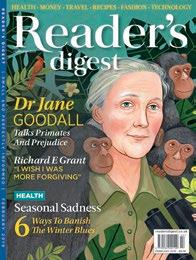


Each must-read monthly issue covers life, culture, health, books, films, food, humour and travel alongside in-depth news features, memoirs and celebrity profiles.
YES I want to subscribe to Reader’s Digest Magazine for just £3 for 3 issues (a saving of £8.37 on the shop price of £11.37 based on the cover price of £3.79 per issue). I understand that if I do not wish to continue receiving Reader’s Digest after my first 3 issues I can simply cancel my subscription by contacting customer services. If I do want to continue to subscribe after my first 3 issues I need do nothing and my subscription will automatically be renewed at the low rate of £7.50 for every 3 issues until I decide otherwise. Name: Address: Postcode: Telephone: Email:
Return your completed form to: Reader’s Digest, The Maltings, West Street, Bourne PE10 9PH
Or call us today on 0330 333 2220


DECEMBER2018 HEALTH • MONEY • TRAVEL • RECIPES • FASHION • TECHNOLOGY READER’S DIGEST SMALL AND PERFECTLY INFORMED On Love Lessons, Luck And LSD Christmas Trees ANNIVE RSARY EDI TION 80 Roger Daltrey JANUARY2019 HEALTH • MONEY • TRAVEL • RECIPES • FASHION • TECHNOLOGY READER’S DIGEST SMALL AND PERFECTLY INFORMED On Politics, Partridge And Perfectionism COOGAN Steve THEPARANORMAL? Please complete direct debit mandate below Name of Bank ...................................................................... Account Holder Branch: / / Account No Instructions to your bank or Building Society: Pay Reader’s Digest Direct Debits from the account detailed on this instruction subject to the safeguards assured by the Direct Debit Guarantee. I understand that this instruction may remain with Reader’s Digest and if so will be passed electronically to my Bank or Building Society. Signature ..................................................................... Date .............................................................................. INSTRUCTIONS TO YOUR BANK OR BUILDING SOCIETY TO PAY BY DIRECT DEBIT. Originators reference: 400162
Data Protection: From time to time Reader’s Digest may contact
details of
Please tick here if
to receiving such information
Sort Code
you with
its products and services.
you object
FOR JUST £3!
Quoting code RDN059
IT PAYS TO INCREASE YOUR
Word Power
Winter always leaves us longing for some time away. If you, too, have a touch of wanderlust this month but can’t manage even a mini vacation, this quiz might help: the theme is toponyms, words derived from place-names both real and fictional. Bon voyage! Answers on next page.
BY ROB LUTES
1. balkanise v.—A: divide into factions. B: coat with rubber. C: prevent from entering.
2. Byzantine adj.—A: artificial. B. complicated. C: dangerous.
3. sybarite n.—seeker of… A: knowledge. B: power. C: pleasure.
4. lilliputian adj.—A: highly fragrant. B: very small. C: wondrous.
5. madras n.—A: colourful lightcotton fabric. B: hearty lentil soup. C: large, noisy crowd.
6. Dixieland n. style of… A: country music. B: country gospel. C: jazz.
7. tabby n.—A: type of silk taffeta. B: variety of wine grape. C: type of wallcovering.
8. El Dorado n.—A: symbol of peace. B: place of great wealth
and opportunity. C: dance to celebrate life.
9. lyceum n.—A: trellised pathway. B: hall for public lectures. C: an ornate display.
10. solecism n.—A: minor blunder in speech. B: expression of disgust. C: statement of worth.
11. jodhpurs n.—A: leather boots. B: riding breeches. C: protective gloves.
12. magenta n.—A: light pink. B: purplish red. C: dark blue.
13. Boeotian adj.—A: heavy. B: witty. C: dull or obtuse.
14. fescennine adj.— A: silent. B: loud. C: obscene.
15. canopic jar n.—a jar for… A: preserving food. B: embalmed entrails. C: keeping medicine.
FEBRUARY 2019 • 133
AND GAMES
FUN
1. balkanise—[A] divide into factions (the Balkan Peninsula was split into small warring nations).
2. Byzantine—[B] complicated (Byzantium bureaucracy was complex). Jo was confused by the Byzantine map.
3. sybarite—[C] seeker of pleasure (the ancient Greek city Sybaris was known for wealth and luxury). A sybarite, Tom favoured costly, rare Italian reds.
4. lilliputian—[B] very small (in Gulliver’s Travels, the inhabitants of Lilliput were tiny).
5. madras—[A] colourful light-cotton fabric (the style originated in Madras, India). Elsie couldn’t resist the pricey orange-and-yellow madras top.
6. Dixieland—[C] style of jazz (a nickname for the US south, where the style originated).
7. tabby—[A] type of silk taffeta (the fabric was first made in Al‘Attabiya, Baghdad). Carol wore an elegant tabby scarf.
8. El Dorado—[B] place of great wealth and opportunity (the city was said to hold fabulous riches). Eli labelled Silicon Valley his El Dorado.
9. lyceum—[B] hall for public lectures (Aristotle taught in Lyceum, a gymnasium near Athens). The professor feared the lyceum’s scale.
10. solecism—[A] minor blunder in speech (after the language spoken in Soloi, ancient Cilicia).
11. jodhpurs—[B] riding breeches (they were designed in Jodhpur, India). Lillie wore her old jodhpurs for the race.
12. magenta—[B] purplish red (the colour’s dye was discovered the year of the Battle of Magenta, Italy, 1859). At sunset, the sky turned magenta.
13. Boeotian—[C] dull or obtuse (Greek Boeotians were labelled bores by Athenians). Mae struggled to explain rap to her Boeotian cousin.
14. fescennine—[C] obscene (the ancient Italian town Fescennia was noted for their use of offensive verse).
WORD OF THE DAY*
RAGABASH:
An idle fellow
Alternative suggestions:
“Attending a costume party in old clothes”
“An embarrassed piece of cloth”
“When you hit someone over the head with fabric”
15. canopic jar—[B] jar for storing embalmed entrails (it was mistakenly associated with Canopus, Egypt). King Tut’s tomb holds four canopic jars.
WORD POWER *POST YOUR DEFINITIONS EVERY DAY AT FACEBOOK.COM/READERSDIGESTUK
VOCABULARY RATINGS 9 & below: Wordmonger 10–12: Wordsmith 13–15: Etymologist 134
Answers
Brainteasers
Challenge yourself by solving these puzzles, then check your answers on p138
THIS IS NOT A MAZE
This puzzle has six white sliding doors that can each be pushed into one of the two corridors they are straddling, blocking people from walking through. How can you close four of them so it’s impossible to get from the entry to the exit?
GEMSTONES
There are eight semiprecious gems in Sven’s collection. At current market prices, four are worth £5, three are worth £10 and one is worth £25. He gives them to his three children: Annika, Birgitta and Carl.
n The total value of each child’s gift is the same.
n Carl receives exactly three stones.
n Annika receives the lowest number of stones.
How are the gems distributed?
FUN & GAMES
(THIS IS NOT A MAZE) DARREN RIGBY; (GEMSTONES) MARCEL DANESI. FEBRUARY 2019 • 135
SIX FIGURES
Fill in each cell of this grid with a whole number from 1 through 6 so that each row, column and outlined region contains six different numbers. We’ve placed a few numbers to get you started.
MAKE IT WORK
Arrange the whole numbers from 1 to 9 in the three-by-three grid so that all of the following conditions are satisfied:
n 4 is positioned between 2 and 5.
n 3 is between 4 and 8.
n There’s a row, column or long diagonal for which the sum and the product are equal.
n There’s a number in the left column that is three times the number in the lower right corner.
n The sum of one of the long diagonals is odd.
UNDER THE SAME FLAG
On the left are the names of five boats that belong to the same company. Which one of the names on the right would fit in with the rest?
FENIX 9
GALVI 56
YARCA 100
SIIKU 2
BOCDU 400
DIVOY 20
SEVON 7
PIJRA 5
NAXIR 11
GIVET 13
n 6 does not share a row, column or long diagonal with 7.
136 • FEBRUARY 2019 BRAINTEASERS 1 4 6 3 6 2 4 5
(SIX FIGURES) FRASER SIMPSON; (UNDER THE SAME FLAG) DARREN RIGBY; (MAKE
IT WORK) RODERICK KIMBALL.
CROSSWISE Test your general knowledge. Answers on p142 ACROSS 1 Rapid nuclear reactor shut-down (5) 4 Helper (9) 10 Dressing (10) 11 Atop (4) 12 Ministers (9) 13 Bender (5) 15 Sets of equipment (4) 17 Female big cat (10) 19 Herefordshire town (10) 21 Type of heating fuel (4) 22 Reprimand (5) 24 Contented (9) 27 Waist band (4) 28 Volume for preliminary artistic studies (10) 29 Steam locomotive (4,5) 30 One of these means almost cloudless (5) DOWN 2 Truce (5-4) 3 Isolated (5) 5 Snow vehicle (7) 6 Notion (4) 7 Fabricated (7-2) 8 Hangman’s knot (5) 9 Emphasise (9) 14 Wig (9) 16 Ignorant person (9) 18 Whipping boy (9) 20 Makes journeys (7) 23 Gaiety (5) 25 Legend (5) 26 Capital of Norway (4) FEBRUARY 2019 • 137 READER’S DIGEST
Brainteasers: Answers
THIS IS NOT A MAZE
£50 PRIZE QUESTION
Answer published in the March issue
Can you rearrange these letters to form a single word?
GEMSTONES
Annika: one stone worth £25.
Birgitta: one stone worth £10 and three worth £5. Carl: two stones worth £10 and one worth £5.
SIX FIGURES
THE FIRST CORRECT ANSWER WE PICK WINS £50!*
Email excerpts@ readersdigest.co.uk
ANSWER TO JANUARY’S PRIZE QUESTION
UNDER THE SAME FLAG
Each of the names on the left contains a Roman numeral and a number that matches its value, so NAXIR 11 fits in with the others.
MAKE IT WORK
EVASION
All the others form another word when the first letter is removed: e/motion, v/indiction, r/evolution, t/reason
AND THE £50 GOES TO… Douglas McKinlay, Great Cumbrae
138 • FEBRUARY 2019
5 1 2 3 6 4 3 2 5 1 4 6 6 4 3 5 2 1 4 3 1 6 5 2 2 5 6 4 1 3 1 6 4 2 3 5 1 8 7 6 3 9 5 4 2
0 A N S W E R P E P
-Second
Stand-Up
We chatted to the fabulously energetic stand-up comic, Sindhu Vee
WHAT’S THE BEST PART OF YOUR CURRENT SHOW? When I know I’m going to talk about things that are a little bit darker. It’s always a moment of uncertainty and magic because I don’t know how the audience is going to take it. It’s very valuable talking about things that are serious yet funny—how are you ever going to get over dark things if you don’t laugh? There are very few topics that play in light and dark the way love does, and the show is ultimately about love.
WHO INSPIRES YOUR COMEDY? My everyday life; I’m not a political comic. Both the family I grew up with and the family I’m bringing up inspire me. We are all products of our relationships, so there’s that.
WHAT’S YOUR FAVOURITE OF YOUR OWN JOKES? When I was growing up in India there was no sex education, so when it comes to sex there’s no theory, you just show up for a practical and wing it. We’re innately so talented at this that there’s a billion of us.

DO YOU FIND ANY PARTS OF THE COUNTRY TO BE FUNNIER THAN OTHERS? Audiences in Scotland, especially Glasgow, are very entertaining. Someone was talking during my set when a man from the back told him to shut up. I assured them I didn’t care about the heckle, but they started having a fight. It was so crazy and I loved it. As an Indian, I have a huge appetite for chaos.
WHAT’S YOUR FAVOURITE ONE LINER? After 20 years of marriage, my husband and I know each other extremely well. In fact, I know him so well I can have a full blown argument with him from start to finish when he’s not even home.
WHICH SUPER POWER WOULD YOU HAVE? To always be content with whatever I was doing at the time.
Get tickets for Sindhu Vee’s comedy tour, Sandhog, at sindhuvee.com. Tour dates are February 1 until April 3, 2019, tickets on sale now
60 FEBRUARY 2019 • 139
FOR MORE, GO TO READERSDIGEST.CO.UK/INSPIRE/HUMOUR
FUN & GAMES
Laugh!
Win £30 for every reader’s joke we publish! Go to readersdigest. co.uk/contact-us or facebook.com/readersdigestuk
THEY SAY THAT WHEN YOU FALL in love, you lose an average of two friends.
So if I ever finally fall in love, I’ll be the first person with negative friends.
COMEDIAN JAMES KING
WHEN I GOT MARRIED THERE WAS never a question of me taking my wife’s name since it was literally unpronounceable.
Scott “Bolander” is already bad enough, I didn’t want to be Scott “Unpronounceable.”
COMEDIAN SCOT BOLANDER
I BROKE UP WITH MY WIFE because she was stealing from me.
Pucker Up!
It’s not just humans who express love with a smooch. These cute critters are celebrating the day of love too (via boredpanda.com)
She stole all my favourite Kevin Bacon films and she stole all my small French cakes.
On the plus side though I’m now footloose and fancy free.
COMEDIAN ALF
A LOT OF PEOPLE CLAIM THAT IT’S a lack of vocabulary that makes people swear.
Rubbish. I know thousands of words, but I still prefer “f**k”.
COMEDIAN BILL CONNOLLY
YOU LEARN A LOT ABOUT HUMANS when you have a baby. Girls are so much more advanced than boys. I seriously think that girls are born in

140 • FEBRUARY 2019 FUN & GAMES
conversation. It’s like they come out of the womb, talking: “Are you my mother? Lovely to finally put a name to a face.”
COMEDIAN MICHAEL MCINTYRE
THE ONLY HONEST ANSWER YOU can give when someone asks you if you love them is “at the moment, yes”, but try saying that without getting a kick in the chaps.
COMEDIAN JON RICHARDSON
I GET CLAUSTROPHOBIC EASILY and I don’t get why aeroplane toilets don’t have windows. I mean it’s not as if anyone can see in. Unless of course you are the most determined pervert in the world.
COMEDIAN BILLY CONNOLLY
FOR THE PRICE OF A SINGLE ticket to go and watch a football match, I could take my whole family to a farm park. We could go on the donkeys. We could get lunch and tea. I could go on a tractor. All for the price of a single ticket.

And that’s exactly why I go and watch the football.”
COMEDIAN ROMESH RANGANATHAN
THE THING RESTAURANTS ALWAYS boast about now is homemade cooking. I don’t want homemade cooking, that’s why I’m here! Because I don’t like the stuff at home!”
COMEDIAN LEE EVANS
IF ADAM AND EVE CAN’T MAKE IT work in paradise, then how am I going to make it work in Lewisham?
COMEDIAN SARA PASCOE
PICASSO SHOULD HAVE BEEN A taxidermist. “I’ve done your dog. It’s got nine eyes down the side, I made his head all square, 15 legs.”
COMEDIAN EDDIE IZZARD
I GOT MUGGED IN LIMERICK. The place, not style. He didn’t sing, “Hello my name is Pete, I’m standing in the street, don’t be rash, give me your cash or I’ll kick you in the teeth.’”
COMEDIAN LEE MACK

FEBRUARY 2019 • 141 READER’S DIGEST
Lonely In Love
This Valentine’s Day, these brave tweeters share the reason they’re still single:
@AnnieKroth: “I bite into both Kit Kat bars at the same time to avoid leaving a lonely one at the end.”
@Derpin_Irwin: “When I had a boyfriend, my Dad pretended to rob us to see if he’d protect me.”
@RingsBySpringlu: “One time I told a girl that I thought she was beautiful and after she said thank you I said, ‘Yeah, I’ve been watching you a lot.’”
@PaigeSorenson: “I point blank refuse to give up my side of the bed. Which is both sides. Because I sleep like a starfish.”
@LiseFranz: “My step dad tells every guy that I bring home, ‘Whatever you do to my daughter, I’ll do to you.’”
RYANAIR HAVE BEEN GETTING A HARD time because they’ve launched a £7 flight to New York. Although as always with RyanAir, it does land slightly outside of New York… In Dublin.”
COMEDIAN FRANKIE BOYLE
I SAW A CLOWN DOING SIT UPS THE other morning.
Funny how things work out.
MARI DRURY, Flintshire
I’VE DECIDED THAT I’M NO LONGER going to date people that I work with.
It’s not that I don’t believe in office romance, I’m just really tired of dating people with awful jobs.
COMEDIAN JEREMY RANDALL JOHNSTON
I REALLY WANT TO GET A PHD IN HISTORY so that if there’s ever an accident and someone yells, “is anybody here a doctor?”
I can raise my hand, walk over and say, “I’m not going to let you die… ignorant about the Cuban Missile Crisis.”
COMEDIAN SAMANTHA RUDDY
I RECENTLY HAD TO QUIT DRINKING ALCOHOL. I felt like getting drunk all the time was just making me into sombody I wasn’t.
Drinking makes you outgoing and funny and likeable, and that’s just not me.
SEEN ON REDDIT
CROSSWORD ANSWERS
Across: 1 Scram, 4 Assistant, 10 Mayonnaise, 11 Upon, 12 Reverends, 13 Spree, 15 Kits, 17 Leopardess, 19 Leominster, 21 Peat, 22 Scold, 24 Satisfied, 27 Belt, 28 Sketchbook, 29 Iron horse, 30 Tenth
Down: 2 Cease-fire, 3 Alone, 5 Skiddoo, 6 Idea, 7 Trumped-up, 8 Noose, 9 Underline, 14 Hairpiece, 16 Simpleton, 18 Scapegoat, 20 Travels, 23 Cheer, 25 Fable, 26 Oslo
LAUGH 142 • FEBRUARY 2019
CARTOONST: BILL HOUSTON
BEAT THE CARTOONIST!

Think of a witty caption for this cartoon—the three best suggestions, along with the cartoonist’s original, will be posted on our website in mid-February. If your entry gets the most votes, you’ll win £50.
Submit to captions@readersdigest.co.uk or online at readersdigest.co.uk/fun-games by February 7. We’ll announce the winner in our April issue.
December’s Winner

Our cartoonist was left trailing in last place with his somewhat sinister Santa caption: “…and who do you think they’re gonna believe? Me…or you?” Our witty reader David Taylor managed to knock him off the top spot with his caption: “Listen sunshine when I found you, you were fishing in a garden pond.” Enter online and you could be the next reader to steal our cartoonist’s crown.

Interview:
Neil Morrissey
The actor opens up about his life, work and The Good Karma Hospital

I Remember: Suzi Quatro
The queen of bass looks back on her fascinating life in music In
Plus PARENTING AND MENTAL ILLNESS
Fiona Thomas poses the question of whether mental illness can make you a better parent
FEBRUARY 2019 • 143
READER’S DIGEST
the March Issue



At last! The UK’s rst truly independent guide to stairlifts.


Inside this 24-page colour booklet you will nd everything you need to know about stairlifts, including :-
The huge di erence a stairlift can make to your enjoyment of life!
How easy to operate & reliable they are
How neatly the new designs t in with your home’s surroundings
Design features - safety, comfort & use
How quick and easy it is to t a stairlift
Traps to avoid when buying a stairlift
How & where to get the best deals inc. reconditioned & renting options
A comprehensive listing of all the major U.K. makes & models, design options and features.
FREE GUIDE
AND...
0800 074 3961 For your
GuideFREEPHONE (QUOTE S325EV) Lines Open 8am-8pm Mon-Fri 10am-4pm Sat-Sun New updated 2019 Edition
MUCH MUCH MORE!! CONSUMER’S GUIDE TO STAIRLIFTS
FREE
































































































FREEPOST TO: Mobility Aids Information Service (S325EV), FREEPOST LON15651, London SE1 1BS For your FREE Guide FREEPOST this coupon in an addressed envelope or you can request details online at mobinfo.co.uk The information we will send you will be from our authorised stairlift practice for your area. Your information will only be used to deliver our service and as set out in our Privacy Policy: www.stairliftsecrets.co.uk. MR/MRS/MISS ADDRESS POSTCODE (we cannot despatch without all details) TELEPHONE NUMBER Please update me on the latest stairlift discounts THIS BOOK WILL ONLY BE SENT TO THOSE APPLICANTS WHO SUPPLY THE CORRECT INFORMATION TO ALL SECTIONS MARKED IN BLOCK CAPITALS 24 pages 29 models WAS £4.99







...what a way to make a livin’
LOUISE REDKNAPP AMBER DAVIES and BRIAN CONLEY
Music & lyrics by DOLLY PARTON
Book by PATRICIA RESNICK
NATALIE M c QUEEN
Directed by JEFF CALHOUN
Based on the 20th Century Fox Picture. Originally produced on Broadway by Robert Greenblatt, April 2009
SAVOY THEATRE • OPENS JANUARY 2019
TICKETS.READERSDIGEST.CO.UK • 0207 400 1238










































































 BY JEFF KULAK
BY JEFF KULAK




 Susannah Hickling is twice winner of the Guild of Health Writers Best Consumer Magazine Health Feature
Susannah Hickling is twice winner of the Guild of Health Writers Best Consumer Magazine Health Feature





















 A male Amur tiger rescued from poachers recovers at Utyos Wildlife Rehabilitation Center in Kutuzovka, Russia
A male Amur tiger rescued from poachers recovers at Utyos Wildlife Rehabilitation Center in Kutuzovka, Russia

 PHOTO: © PATRICK EVANS
PHOTO: © PATRICK EVANS




























 Clockwise from top left: the Museum of the History of Polish Jews, built on the site of the former Warsaw Ghetto; doughnuts from the A. Blikle Café; the 755ft Palace of Culture and Science, a gift from the Soviet Union
Clockwise from top left: the Museum of the History of Polish Jews, built on the site of the former Warsaw Ghetto; doughnuts from the A. Blikle Café; the 755ft Palace of Culture and Science, a gift from the Soviet Union


 Clockwise from left: The historic Royal Castle, rebuilt after it was destroyed in the Second World War; one of the lavishly decorated rooms in the castle; a Warsaw metro station, modern, clean and efficient
Clockwise from left: The historic Royal Castle, rebuilt after it was destroyed in the Second World War; one of the lavishly decorated rooms in the castle; a Warsaw metro station, modern, clean and efficient























































































 by Mike McCahill
by Mike McCahill







































































































































